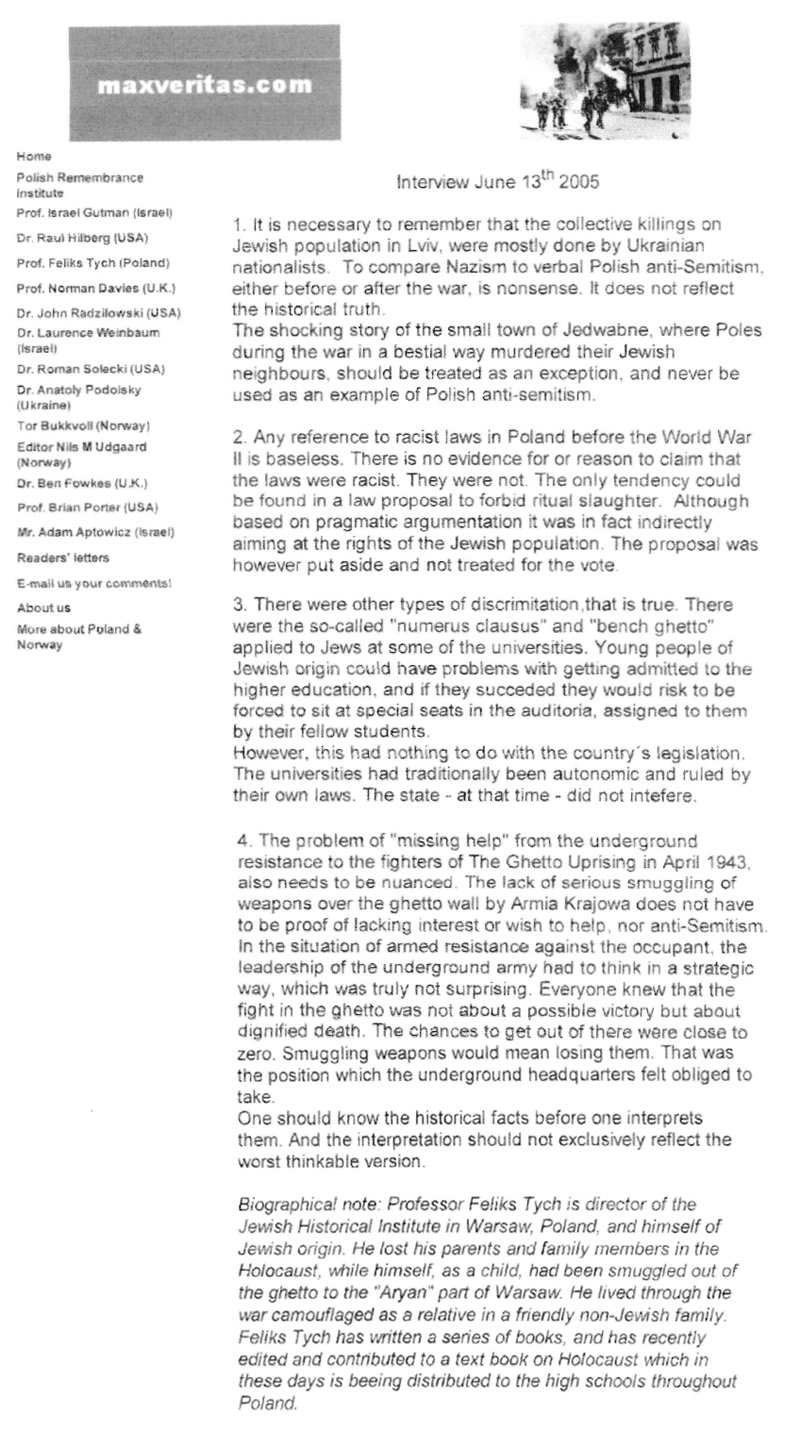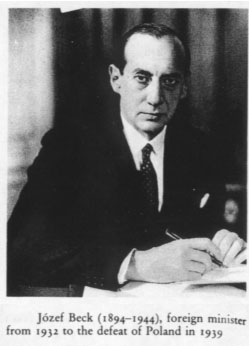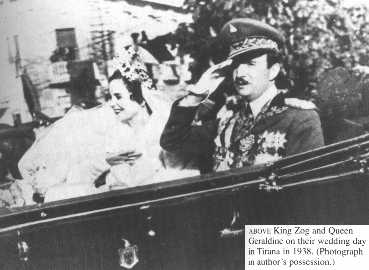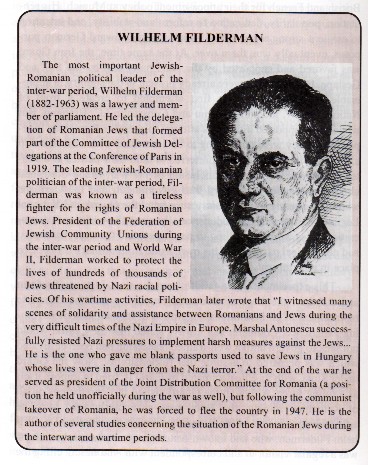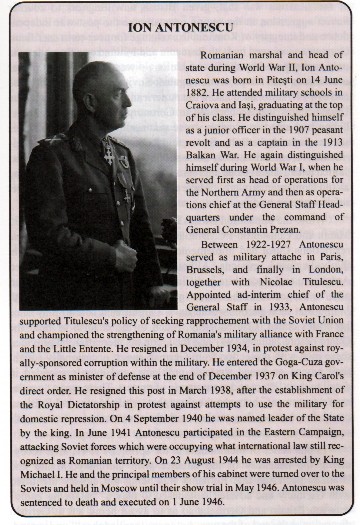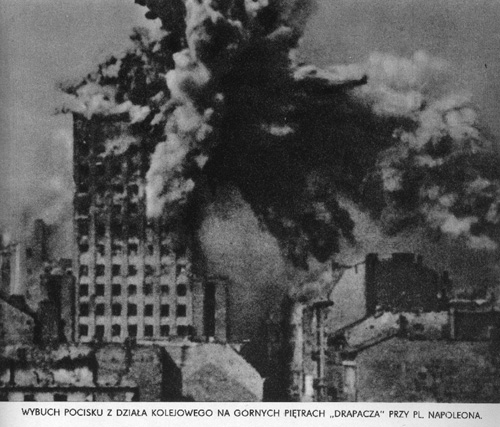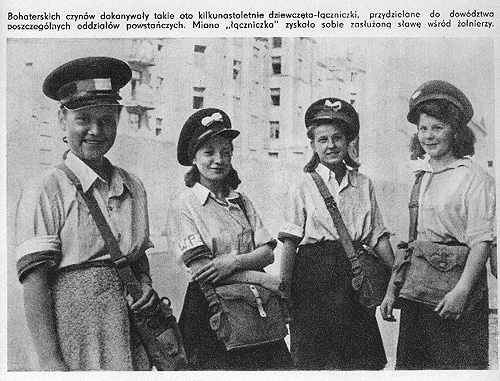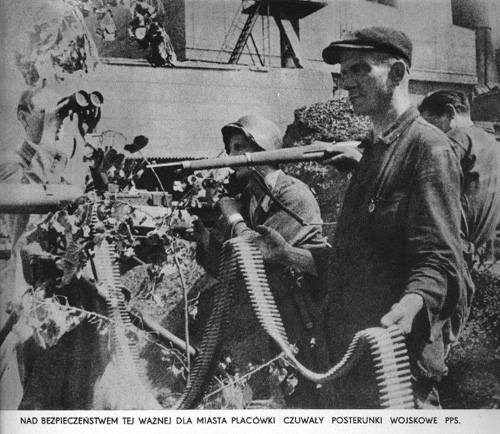|
Anna M. Cienciala (hanka@ku.edu) |
History
557 Lecture Notes |
Spring
2002 (Revised Fall. 2003, spring 2008, Aug-Sept... 2009, April, June2010,
Feb. 2012, Sept. 2013)
|
|
|
LECTURE 16.
THE COMING OF THE WAR AND EASTERN EUROPE IN WORLD WAR II.
A. The British Guarantees to Poland,
Romania and Greece, the Nazi-Soviet pact, and the Outbreak of World War II
[This text is based largely on the
authorís articles, cited here. See also new publications cited in this
lecture.]
I would like to thank Prof. Jean
Sedlar of the University of Pittsburgh at Johnstown, PA, for her very helpful
comments and corrections, esp. on the Balkans. Her surveys of East Central
Europe (including Finland] and South Eastern Europe in World War II, published
in 2008 --see Bibliography-- are cited where pertinent.]
I .British Attitudes toward
Germany in the Aftermath of Munich.
In early October 1938, the U.S.
Ambassador to Britain, Joseph Patrick Kennedy (1888-1969, father of JFK,
Robert and Ted Kennedy, Ambassador 1937-40), reported what Br. For. Secretary
Lord Halifax had told him about British and French policy toward Germany.
Halifax said they intended to strengthen their air defenses and
...after that, to let Hitler go
ahead and do what he likes in Central and South-Eastern Europe. In other words,
there is no question in Halifaxís mind that reasonably soon Hitler will make a
start for Danzig, with Polish concurrence, and even if he decides to go into
Roumania it is Halifaxís idea that England should mind her own business.*
*[Kennedy to the Secretary of State,
October 12, 1938, Papers Relating to the Foreign Relations of the United
States, 1938 . vol. I, Washington, D.C., 1955, pp.85-86. This series is
generally referred to as: FRUS].
Halifax put this less crudely in his
letter of November 1, 1938, to Sir Eric Phipps, British Ambassador in Paris,
when he wrote:
Henceforward we must count with German predominance in
Central Europe. Incidentally, I have always felt myself that, once Germany
recovered her normal strength, this predominance was inevitable for obvious
geographical and economic reasons.
*
*[Documents on British Foreign Policy, 3rd
series, vol. III, 1938-1939, London, 1950, doc. no. 285, p. 252].
Thus James Headlam-Morleyís 1925 warning that
German expansion in Central Europe would threaten W. Europe (Lec. Notes 15)
went unheeded. Although some senior officials in the Foreign Office opposed
concessions to Hitler in Central Europe, their views were ignored. The foremost
opponent of appeasement, Robert Vansittart (1881-1957), lost his
position as Permanent Under Secretary of State for Foreign Affairs and thus
head of the Foreign Office, in 1937 to Alexander Cadogan (1884-1968),
who held that post until the end of World War II.
Despite internal opposition and
criticism from some Foreign Office members, and vocal opposition from some
politicians, British statesmen still believed that German expansion in Central
and S.E. Europe would not have any dangerous consequences for Western
Europe. However, British public opinion was deeply divided over Munich.
While there was much admiration for Chamberlain for havinga avoided war, there
was a strong feeling that while the Munich decisions may have been unavoidable,
the Western Powers should make no more concessions to Hitler. Opposition to
Chamberlainís appeasement policy also grew within the Conservative Party; it
was led by Winston Churchill (1874-1965). He had warned against Germany
and given information (sometimes exaggerated) on its rearmament since 1935.
Although he had supported intervention against the Bolsheviks in 1918-19, he
now advocated a "Grand Alliance" of Britain, France and USSR to stop
Hitler.
2. French Attitudes.
French Premier Edouard Daladier
(1884-1970) was very surprised at the welcome he received on landing in Paris
when he returned by air from Munich. He had expected anger at betraying
Czechoslovakia - but was met with cheers and flowers. He said the people did
not realize what had happened. Indeed, after the initial joy at avoiding war had
passed, public opinion polls showed that most French people thought like the
British - - that Munich was unavoidable, but no more concessions should
be made to Hitler.
Unlike Daladier, French
Foreign Minister Georges Bonnet (1887-1973) was a convinced appeaser. On
December 6, 1938, he signed an agreement in Paris with German Foreign Minister Joachim
von Ribbentrop (1893-1946) that the two governments would consult each
other on questions of mutual interest. This was, in fact, like the
Chamberlain-Hitler agreement signed at Munich on September 30 - but
Ribbentrop saw the agreement signed with Bonnet as French resignation
from interest in Central Europe. Bonnet denied this officially in a diplomatic
note of July 1, 1939. However, in a work published after the war he
seemed to confirm Ribbentropís impression. Thus, in his book on the French
Foreign Ministry under the first three republics (published in Paris,1961),
Bonnet wrote that a Franco-German "entente" could have been the first
step to a United States of Europe (!). He also wrote that, at the time,
one could hope Hitler would be clever enough to settle the Danzig-Corridor
question at another conference.* It is clear that this reflected Bonnetís
own hopes in 1938-39.
*[Georges
Bonnet, Le Quai díOrsay sous Trois Republiques, Paris, 1961, p.240,
243-44].
II. Polish-German Relations,
October 1938 - January 1939.
1. On October 24, 1938, Ribbentrop
told Polish Ambasssador Jozef Lipski (1894-1958, Minister, then
Ambassador in Berlin, 1932-39, later in the West), that Germany could offer
Poland a "general settlement" of all outstanding questions.
Ribbentrop proposed that: (1) Poland agree to the abrogation of Danzigís status
as a Free City and its return to the Reich, while preserving all its rights
there, also to a German extra-territorial highway and railway through the
Polish Corridor to Danzig and East Prussia; (2) Poland would join the
"Anti-Comintern Pact."* In return, Germany would guarantee the
Polish-German frontier and extend the Declaration of Nonaggression of 1934 for
25 years.
*[Oct.25, 1936, German-Italian Pact;
Nov. 26. 1936, German-Japanese Pact; Nov. 6, 1937, Italian-Japanese Pact
against the Comintern. These pacts came to be known as the Anti-Comintern
Pact].
Polish Foreign Minister Jozef
Beck (1894-1944, For. Min. 1932-39) instructed Lipski to give a
negative answer on Danzig , but say that negotiations were possible to
improve German railway traffic and on building a German highway through
the Polish Corridor. This seems to be have been a gambit to gain time, and
there is no trace of any agreement by the Polish "Castle Council"
(President, For. Min., Army Chief,and selected others meeting in the
President's rooms in the Royal Castle, Warsaw) to this project. Finally, Beck said
nothing to the invitation to join the Anti-Comintern Pact, which was equivalent
to a refusal.
Ribbentropís proposal seems quite reasonable. However, we know what
Hitlerís real intentions were from information given by the Danzig
"Gauleiter" (Party district leader) Albert Forster (1902-1950)
to the League of Nations High Commissioner in Danzig, Carl Jakob Burckhardt
(1891-1974, in Danzig 1937-39). In November 1938, Forster told him what he had
just heard from Hitler: The Fuhrer said he would guarantee Polish
frontiers for his own lifetime - but only if the Poles were "reasonable
like the Czechs." Burckhardt heard the same phrase from
German State Secretary Ernst von Weizsacker when he visited Berlin in
December 1938. Thus, it is clear that Hitlerís aim was to make Poland
subservient to Germany. *
*[for details and references to doc.
sources, see info. below on Ribbentrop visit to Warsaw, Jan. 26, 1939.]
Beck played for time
and worked for closer relations with Britain. In this he succeeded, for on December
15, 1938, the British government stated that it would not approve any changes
in the status of Danzig without first consulting with the Polish government.
This meant a defeat for Georges Bonnet, who was pushing for the removal
of the High Commissioner from Danzig as well as the abolition of all League of
Nations involvement in the Free City. This French proposal to Britain came on
the heels of the introduction of antisemitic legislation in Danzig by Forster
in November 1938, just after attacks on Jews all over Germany known as the
"Crystal Night" because of the broken glass.
Halifax rejected Bonnet's proposal because he believed that Britain
might need Col. Beck in the future. It is not clear what Halifax meant by this
phrase, but it seems that he saw Beck as a Polish statesman who
would be willing to give Hitler what he wanted by negotiation, thus avoiding
war. In any case, Halifax certainly believed that the issue could be settled
peacefully.
In December 1938, with the next
League of Nations session in the offing, Beck requested a meeting with Hitler
to find out whether his views on Danzig and the Corridor were the same as
Ribbentropís. The meeting took place in Berchtesgaden on January 5, 1939.
Hitler repeated the Ribbentrop proposals of Oct. 24, 1938, to which Beck
answered that he saw no equivalent for a Polish agreement that Danzig return to
Germany. Ribbentrop pressed Beck on the same issue next day, and received the
same answer.
On returning to Warsaw, Beck
thought briefly of taking up a phrase Hitler used, when he suggested a new
organism, a "Korperschaft" (corporation) to safeguard Polish and
German interests in Danzig. Beck thought that some sort of
"condominium" or joint Polish-German administration might provide a
solution. However, the Castle Council decided that no such Polish proposal
should be made because it would be the first step on the slippery slope to the
loss of Polish independence. B
eck agreed.
There is no clue as to what Hitler
might have meant by "corporation," but the whole thrust of Nazi
propaganda in the Free City -- which the Nazis ruled since winning the
elections in the FCD territory in May 1935 -- was "Heim ins Reich!"
(Home to Germany). Therefore, it is possible to assume that whatever Hitler may
have meant by corporation," it would have meant German sovereignty.
Neither the Polish government nor public opinion could agree to this or to an
extraterritorial German Corridor through the Polish Corridor, because then
Germany could choke off Polandís access to the sea. Furthermore, even a narrow
German corridor through Polish Corridor would mean putting Polish people under
German rule. (Many still remembered the heavy-handed Germanization policies in
former Prussian, now western Poland.)
On January 26, 1939, Ribbentrop paid
an official visit to Warsaw to
celebrate the fifth anniversary of the Polish-German Declaration of
Nonaggression. of Jan. 26, 1934. However, his real objective was to secure
Beckís agreement to the proposals which he and Hitler had made earlier. He also
tempted Beck with vistas of Polish expansion into the Soviet Ukraine, even as
far as the Black Sea, but Beck did not take up the offer. Finally, they agreed
that neither country would act unilaterally if the League of Nations withdrew
from Danzig.* Nevertheless, German leaders still hoped to isolate
Poland so that the Polish government would finally accept their
"reasonable" proposals. *
*[On German-Polish relations, Polish
and British policy toward Poland in the period October- 1938 - end January
1939, see Anna M.Cienciala, Poland and the Western Powers, 1938-1939. A
Study in the Interdependence of Eastern and Western Europe, London,
Toronto, 1968, ch.V. For an updated study including the Forster-Burckhardt
conversation, see same: "Poland in British and French Policy in 1939:
Determination to Fight or Avoid War,?" Polish Review, vol. XXXIV,
no. 3, New York, 1989, pp. 199-226, reprinted with some abbreviations in
Patrick Finney, ed., The Origins of the Second World War, London, 1997.]
III. Toward the British Guarantee
of Poland.
1. In December 1938 and again
February 1939, rumors reached the British government of Hitlerís alleged plans
to attack Holland, Belgium, and Switzerland, and bomb London at the same time.
In fact, these rumors were planted by the secret German "Resistance"
to Hitler led by Dr .Carl Friedrich Goerdeler (1884-1945, mayor of
Leipzig 1930-37), which was supported by some German generals, foreign ministry
officials and diplomats. In summer 1938, they secretly proposed to the British
government that they would overthrow Hitler if he provoked war with the Western
Powers. However, there was no war, so there was no attempt to overthrow Hitler.
Now, they advised a firm British attitude toward Hitler to prevent war
- but they wanted British agreement to Germany keeping Austria and the
Sudetenland as well as regaining Danzig and the Polish Corridor from Poland.
However, the British government did not take up the offer because
it still hoped for a negotiated settlement with Hitler.
2. On the night of March
14-15,1939, Hitler sent the German army into the Czech lands of
Bohemia-Moravia. A Czech-Slovak dispute was his pretext for this
attack. He also told the Slovak leaders to demand independence under his
protection - or he would give Slovakia to Hungary. He summoned Czech
President Emil Hacha (1872-1945) to Berlin, and threatened to bomb
Prague if Hacha did not ask for German "help." Hacha did so, Hitler
sent in German troops, and announced a German "protectorate"
over Bohemia-Moravia, as Slovakia declared its "independence."
Hungary took her chance to occupy the rest of Subcarpathian
Ruthenia, thus creating a common border with Poland. (On November 2, 1938, Hungary had received a slice of
southern Slovakia and western SCR in the Vienna Award, agreed by Hitler
and Italian Foreign Minister, Count Galeazzo Ciano ,1903-1944, For. Min.
1936-43.)
Hitlerís occupation of the Czech
lands provoked outrage in Britain. Many saw it as proof that his word could not
be trusted and public opinion demanded the government take a firm stand. Still,
Neville Chamberlain proclaimed in Parliament that while he regretted
Hitlerís action, the French and British guarantees, promised to
Czechoslovakia at Munich, did not come into play because Czechoslovakia had
disintegrated in an "internal crisis." He said he would still pursue
his policy of seeking peace.
However, on March 16-17, the Romanian ambassador in London, Virgil V. Tilea,
informed the British government that Romania had received a German ultimatum to
sign an agreement with the Reich that would make it a German satellite. Tilea
may have done this on his own initiative so as to provoke a British guarantee
to Romania without implicating King Carol, but it is also possible that he had
the King's consent. (In fact, the Germans demanded the subordination of the
Romanian economy to their needs and a treaty to this effect was signed on 23
March.) Tileaís news, which spread fast in London, increased the pressure on
the British government to do something to stop Hitler. Therefore, Halifax persuaded
Chamberlain to insert a warning to the Fuhrer in the prepared speech he
delivered in Birmingham on March 17. The Prime Minister said that Britain
would not be passive if one power tried to dominate Europe.
On March 18, the British Cabinet decided to propose a declaration
by Britain, France, Poland and USSR that they would "consult"
together if there was a threat of further German aggression. On March 19, at
the insistence of the French ambassador in London, the wording was changed to consult
together on taking action.
That same day, the Soviet government proposed a conference of the same
states to meet in Bucharest to consider what they should do. It is
still unknown what Stalin wanted to gain by this proposal, but in view of his
deep distrust of Britain and his previous hints to Hitler about a nonaggresion
pact in 1935-1936, it is posible he intended the conference to put
pressure on Hitler to come to an agreement with the USSR. Whatever the case may
be, the British government distrusted the Soviets and did not want to provoke
Hitler. Furthermore, the British Dominions as well as many neutral countries
opposed a western alignment with the Soviet Union. Therefore, the Soviet
proposal was politely rejected and Britain stuck to the declaration on
consultation.
On March 22, Hitler annexed Memel (
Lith. Klaipeda) the mainly German-speaking port city of Lithuania and the
surrounding region. Hitler had gone there aboard a German warship. (He was so
seasick that he vowed never to set foot on a ship again.) Poland feared that he
might annex Danzig, so a partial mobilization was carried out the next day in
Polish Pomerania (Corridor) to warn him off. Hitler was angry, but he still
hoped to persuade the Poles to grant his demands peacefully.
Meanwhile, the Polish government
had rejected the declaration on consultation proposed by Britain,
on the grounds that if it signed along with the USSR, this might provoke a
German attack on Poland. The real reason, however, was deep Polish distrust of
the Soviet Union. But Foreign Minister Beck made a counter proposal. On March
22, he told the British Ambassador in Warsaw, Sir Howard Kennard,
why Poland would not sign the declaration; at the same time, he proposed
a secret Anglo-Polish agreement on consultation. The Polish
Ambassador in London, Edward Raczynski (1891-1993, Ambassador London,
1934-45, and briefly P. For. Min. in WWII, later president of the Polish
Government- in- Exile) made this proposal to Lord Halifax two days
later, on the afternoon of March 24. Halifax received it well and mentioned
the possibility that a British-Polish mutual assistance agreement might be negotiated
later.
That same day in the late afternoon or evening, Beck told a group
of high foreign ministry officials in Warsaw that Poland had to draw the line.
He said Danzig was a symbol, but also involved vital Polish interests. He said
that Poland was no longer isolated. (Which suggests that he might have learned
of the Halifax-Raczynski conversation, although Amb. Raczynski wrote
Cienciala -- in answer to her question about this --that there would not have
been enough time to decypher the report he sent to Warsaw after he seeing
Halifax.)
On March 25, Beck told German ambassador in Warsaw, Hans Adolf
von Moltke, that Poland could not accept the German proposals received on 21
March, ( a repetition of the previous German demands). Then he instructed Lipski
to tell Ribbentrop that Poland could not agree to the proposals. Lipski delivered this message to Ribbentrop on March 26. Meanwhile, the day before, on March 25, on hearing of
the Polish refusal, Hitler had issued a directive to the head of the German
army, General Wilhelm Keitel. Hitler said he did not want to drive Poland into
the arms of Britain. However, as soon as an opportunity arose, he would crush
Poland so badly that she would not play a role in European politics for decades
to come. He planned to annex western Poland, ( more or less the
territory of Prussian Poland in 1914), whos Polish population was to be
"evacuated" and resettled elsewhere. For the time being, however,
Hitler wanted to prevent an Anglo-Polish rapprochement. It is hard to see how
British historian A.J.P.Taylor (1906-1990) could claim the directive
showed that "Hitlerís objective was alliance with Poland, not her
destruction." *
[ A.J.P.Taylor, The Origins of
the Second World War, London, 1961, p. 210.]
The British Cabinet considered what
should be done, and the Cabinet Foreign Policy Committee discussed
the problem on March 27.Chamberlain said Polandís
attitude was uncertain as to helping Britain and France defend Romania
if she were attacked, but Poland was absolutely necessary to create a
"second front" against Germany in the East. Also, Poland might buckle
and accept Hitlerís demands, thus lining up with Germany... For these reasons,
he favored giving Poland a unilateral guarantee. Halifax
said that France and Britain could not prevent Poland and Romania from being
overrun, but Chamberlain responded by saying that the Western Powers could
divert some German forces by holding the Maginot Line. Finally, it was
agreed to give a unilateral guarantee to Poland in order to deter
Hitler from further aggression, but without setting a date when it should be
given.
Two days later, on March 29, Ian
Colvin, the Berlin correspondent of the News Chronicle arrived in
London with the "news" that Hitler was about to attack Poland at any moment.
Colvin had heard this from some members of the German "resistance"
who wanted to push the British government into taking a firm stance, frighten
Hitler, and thus prevent him from leading Germany into another war with the
Western Powers, which they believed she would lose again. In fact, Hitler had
not yet set a date for attacking Poland and the "proof" of attack
that Colvin brought -- that is supplies sent to the German troops stationed
near the Polish border -- was not at all new for the British War Office had
known of it for some time. Nevertheless, with rumors flying around London, that
evening, Chamberlain "agreed to the idea of an immediate
declaration of support of Poland, to counter a quick putsch by Hitler."*
*[Note by Alexander Cadogan, Wed.,
29th March 1939: The Diaries of Sir Alexander Cadogan O,M.
1938-1945, edited by Charles Dilks, London,1971, p.165].
Thus it was that on March 30,
Halifax asked Ambassador Raczynski whether Poland would
accept a British guarantee of her independence, and Ambassador Kennard
transmitted the same question to Beck in Warsaw. The Polish Foreign Minister
accepted the proposal at once. It should be noted that he had
rejected the German demands on March 25, five days before he was offered the
British guarantee.
What Beck did not know
was that the British Cabinet decided the guarantee of Polish independence was
conditional on Poland not being "stupidly obstinate" over Danzig and
relations with Germany in general, also on Poland actually fighting to defend
her independence. Furthermore, at noon on March 31, Chamberlain told the
British Cabinet that Britain would decide if and when Polish independence was
threatened.
On the afternoon of March 31,
Chamberlain read a statement in the House of Commons. He first said, at
great length, that the British government believed every dispute could be
negotiated. In the meanwhile, if Polish independence were threatened and Poland
resisted with all her forces, Britain would do all in her power to help Poland,
and France would do likewise.
However, this was not the end of
appeasement. The British guarantee of Polish
independence was meant to deter Hitler from further aggression and persuade him
to obtain what he wanted from Poland by negotiation. On April 1, (All
Fools' Day),Geoffrey Dawson (1874-1944), the editor of the London Times,
published an editorial saying the guarantee did not apply to Polish
frontiers, but to Polish independence. In his diary, he noted that
Halifax and Chamberlain agreed "this was about right."
Polish Foreign Minister Beck,
who was about to depart for London, issued a strong protest and even threatened
to cancel his trip, but the Foreign Office assured ambassador Raczynski
that the editorial did not reflect British policy (!) Beck visited
England on April 4-6, and succeeded in changing the unilateral British
guarantee to Poland into a secret, provisional mutual assistance agreement
between the two countries.*
*[For the British guarantee to
Poland and the provisional agreement of April 6, see: Anna M.Cienciala,
"Poland in British and French Policy in 1939," Polish Review,
no. 3, 1989, cited earlier; slightly abbreviated version in Patrick Finney,
ed., The Origins of the Second World War, London, 1997, pp. 413-433.].
IV. The Path to War: From the end of
March to August 1939.
There are several threads to follow
in this period: Polish-German Relations, Polish-French Relations,
Anglo-Polish Relations, Anglo-Soviet and German-Soviet relations, Anglo-German
Relations, also Anglo-French guarantees to Romania and Greece. These
threads were all inter-related, but for the sake of clarity, they will be
discussed separately.
1. Polish-German
Relations.
Hitler reacted to the Anglo-Polish rapprochement in a speech to
the Reichstag on April 28. He abrogated the Polish-German
Declaration of Nonaggression of January 1934, as well as the Anglo-German Naval
Agreement of June 1935. He listed German demands on Poland publicly for the
first time, said that Poland had rejected them, and stated that he would never
offer them to her again.
Beck gave the Polish reply in a speech to the Polish
Parliament on May 5. He declared that Poland wanted peace - but not any
price, and she would not allow herself to be pushed away from the Baltic Sea.
Poland, he said, was ready to negotiate with Germany, but only on an acceptable
basis. He stated that Poland wanted peace - "but not at the price of
honor." (He meant it would dishonorable for Poland to give up her
independence without a fight). Polish attempts to renew conversations with
Germany failed.The head of Beckís Cabinet Office, Michal Lubienski
travelled to Berlin later in an attempt to see Marshal Goering -- known
to favor a peaceful settlement with Poland --but the Marshal would not see him.
Whatever Lubienski was to propose at this time - and it may have been
the condominium project - Hitler did not want to listen.
Nevertheless, Beck hoped
almost to the end that Hitler would step back from the abyss of another
European war, and that British support would enable Poland to negotiate a
compromise settlement with Germany on Danzig. Also, British pressure on
Beck to do this was intense. There are indications that as late as July-August,
Beck considered the idea of a Polish-German "condominium" in Danzig
(which a Castle Conference had decided not to pursue in January), and it is
known that a project for dividing the territory of the Free City between Poland
and Germany was drawn up in the Polish Foreign Ministry for possible use. There
was also a compromise project for a German highway through the Corridor, but it
was to run through the southern part of the region which was home to many
Germans. These projects show that the Polish govt. did consider a compromise
possible, but there is no evidence that there was any interest in Berlin in
anything but full Polish acceptance of Hitler's demands..
2. Franco-Polish Relations and
the question of French and British military aid to Poland.
In the British guarantee of March 31
-- which was a joint one with France --and as well as in the secret British-Polish
provisional mutual assistance agreement signed April 6, 1939, Britain
had promised to help Poland "with all the means in her
power." In the secret interpretive protocol attached to that
agreement, the British recognized that a German attack on Danzig would be a
threat to Polish independence. (The P. govt. maintained that there could be no
German attack on Danzig without an attack on Poland as well. ) France was also
bound to aid Poland by the military convention of March 1921. However, the
Franco-British military general staff talks which took place in London in April
1939, ended with a secret agreement that if Poland were attacked by Germany,
France and Britain would adopt a defensive strategy.
Despite this agreement, in the Franco-Polish
protocols on implementing the old military convention signed in Paris on May
19, 1939 the French side stated that if Germany attacked Poland,
France would start bombing Germany, and after 15 days (the time needed for
French mobilization), the French army would launch a grand offensive against
Germany. The Poles were to fight so as to delay the advance of German troops
and hold out until the French attacked in the West. If France was attacked by
Germany, Poland was to attack her in the east.
It is unlikely that the French
general staff really believed that French commitments to help Poland would be
honored. It seems they assumed from the beginning that Poland should be
encouraged to fight as long as possible in order to win time for France, which
is what General Gamelin said at a Franco-British conference in September. In
any case, no plans for a grand offensive against Germany were made.
Furthermore. French Foreign Minister Bonnet made the ratification of the
military protocols of May 19 dependent on the signing of the political protocol
interpreting the Franco-Polish alliance, for he did not believe that Britain
would go to war over Danzig. The political protocol was not signed until
September 4, three days after the German attack on Poland, but no grand French
offensive against Germany took place. Gamelin explained later that the French
army had to take measures against a possible Italian attack.
The Polish general staff, for its
part, believed that the military protocols signed in Paris on May 19, meant
that the French had given up their defensive strategy of simply manning the
Maginot Line, and would attack Germany in the West if the latter attacked
Poland. They expected the French to attack the unfinished German fortifications
called the Siegfried Line. This seemed logical, for such an attack would divide
the German armies, while abandoning Poland would mean the Germans could later
launch all their forces against France when they were ready. But the Poles did
not realize the depth of the French military leadersí defensive psychology. They always thought of the terrible French losses in WW I,
and of the fact that a generation of potential fathers and recruits had
perished in the war.
3. Anglo-Polish Relations.
Despite the provisional
Anglo-Polish agreement on mutual assistance (April 6), British policy was still
aiming at a negotiated Polish-German agreement . On May 22-23, Halifax
visited Paris. He told Daladier and Bonnet that he hoped Danzig
would become a Free City in Germany, and that the Vatican would help negotiate
a Polish-German agreement on the Corridor at the right time. Nevertheless, the
British encouraged the Poles to believe that Britain would help if Germany
attacked.
In May, Anglo-Polish air staff talks took place in Warsaw.
The British officers strongly implied that if Poland were attacked and the
Germans bombed Polish military objectives, the British would bomb the same in
Germany. If the Germans bombed Polish civilian objectives, the British would
consult with the French on what action to take.
In July, General Sir Edmund Ironside, the Inspector General
of British Armed Forces, visited Warsaw. His main objective was to secure clear
answers from Polish military and political leaders on just how they would react
to a crisis over Danzig, which was then being filled with German troops -- who
arrived as tourists -- and the city was being armed to the teeth by Germany.
The Poles told Ironside that they would react in proportion to the threat. They
said that if Danzig was declared part of Gernany without a German attack on
Poland, they would protest. But they also said they believed any German attack
on Danzig would be accompanied by an attack on Poland. Despite the nature of
Ironside's questions, the very fact that he visited Warsaw, and was known to be
friendly to Poland, gave the impression of British determination to help the
Poles in case of war.
At this time, in July 1939, the
Polish military gave the British and French military an "Enigma" typewriter
each. These had been constructed on the basis of work by three Polish
mathematicians who had broken the German military "Enigma" code. The
Polish breakthrough -- aided by the French --led to the later development of
code-breaking machines by British code breakers working in the famous Bletchley
Park and the development of "Ultra," the secret name for the
intelligence produced by breaking German codes. It was to be the Western
Allies' secret weapon against Hitler.
In summer 1939, there were
Anglo-Polish negotiations for a large British loan to help Polish rearmament. The loan would provide credits for Polish purchases in
England. However, the British Treasury adamantly opposed this, and the War
Office did not have arms to spare for the Poles. Finally, the British government
agreed to give Poland a loan of 8 million pounds for buying British war
equipment. Most of this went to buy British planes -- to be sent by sea from
French ports to the Black Sea ports of Poland's ally, Romania -- but they were
shipped off too late to help Poland, and turned back.
For the whole period from end March to the outbreak of war, the British exerted
constant pressure on the Polish government not to do anything rash against
Germany, and to seek a negotiated compromise with Hitler.
4. Franco-British guarantees to
Romania and Greece.
On April 7, Italian forces invaded
Albania. This meant an Italian threat to
Greece, while Romania seemed threatened by Germany. (On March 23, a
German-Romanian treaty was signed subordinating the Romanian economy to German
needs). Therefore, the British and French governments now guaranteed the
independence of Greece and Romania. However, no military preparations were made
to implement the guarantees, so they were meant to deter Mussolini and Hitler
from moving against those countries. Romanian oil refineries and agriculatural
produce would help Germany counter the effects of an allied naval blockade,
while a Greece free of German domination was important for British forces and
naval bases in the Mediterranean. The guarantees were meant to prevent German
domination of these countries.
5. Britain, France and the
USSR - the Play for Germany.
France was an ally of the Soviet
Union since 1935 (ratified 1936), and the French government desperately wanted
to turn this into a triple alliance with Britain on the lines of World War I. Chamberlain
and his Cabinet distrusted Moscow but finally decided in late May to seek an
alliance with the USSR in order to deter Hitler from aggression.
Stalin is known to have viewed Britain as the number one enemy of
the USSR, so he distrusted British intentions but Foreign Commissar Maxim M
Litivinov probably had a genuine desire for a Soviet alliance with London.
Historians differ in their interpretations of Litvinov; some believe he worked
for collective security in 1934-38 and then for a Soviet alliance with the
Western Powers because this was Stalin's policy; others believe that Stalin
really aimed at a deal with Hitler at least since 1935, if not earlier, and
used Soviet apparent interest in collective security and later an alliance with
France and Britain, in
order to push Hitler into a deal with the USSR. Whatever the case may be,
Stalin dismissed Litvinov in early May 1939 and some historians see this as
indicating a step toward Soviet agreement with Germany. Indeed, a
comparison of German foreign policy documents available in print since the
1950s, with Russian foreign policy documents published in 1992, indicates that
in 1939 Stalin was far more interested in a nonaggression pact with Hitler -
which he had suggested to Berlin in 1935 through Maxim Litvinov and in 1936
through his special envoy, David Kandelaki - than in a triple alliance with
Britain and France.
It is true that the British at first wanted only a Soviet commitment to help
Poland and Romania in case they were attacked by Germany, and this looked to
Stalin like placing the whole burden on the USSR. Stalin also saw British
guarantees to Poland and Romania as aimed against the USSR. (The two countries
had a defensive alliance to support each other in case of a Soviet attack on
either of them.) After a while, however, the British and French proved willing
to negotiate an alliance and military convention with the Soviet Union. The
sticking point in late summer 1939 was Moscow's insistence that the western
powers accept its definition of "indirect aggression,"
that is, the right to enter Estonia or/and Latvia, if the Soviets
perceived that either country even changed its government and/or policy so as
to threaten the USSR. What the Soviets had in mind was, of course, a
German invasion of their territory through these countries, which signed
nonaggression pacts with Germany in June. France and Britain proposed a
far-reaching compromise in an exchange of letters, which would grant the
Soviets what they wanted without putting this in the public text of the treaty,
but this was not enough for Stalin.
In view of Russian claims, made in
2008-09, that Stalin had no choice but sign an agreement with Hitler in late
August 1939, also that Poland had a secret agreement with Germany against the
USSR signed in 1934, and that France and Britain wanted Hitler toattack the
USSR, this whole issue needs to be set out clearly.
First of all, Poland had signed a
non-aggression treaty with the USSR in 1932, and after signing the Declaration
of Non-Aggression with Germany in late January 1934, For. Mn. Beck travelled to
Moscow in Feb. to sign a 10-year extension of the non-aggression treaty with
the USSR. Secondly, there was no secret Polish-German agreement against the
USSR. Thirdly, it is clear that Stalin was very interested in reaching an
agreement with Germany.
The Soviet leader, in fact,
authorized Georgii Astakhov, the Soviet charge d'affaires in Berlin .
(Ambassador Merekalov left for Moscow in May, )to conduct secret talks with the
Germans .* The ostensible goal of these talks was the renewal of the
German-Soviet Trade Agreement of 1935 which had lapsed in 1938, and which was
very important for the Russians. However, Astakhov kept on hinting at Soviet
interest in a political agreement. In fact, Foreign Commissar Vyacheslav
M. Molotov (1890-1986, Foreign Commissar May 1939-1955), first
mentioned this interest to the German Ambassador in Moscow, Count Friedrich
Werner von der Schulenburg, in May, and confirmed it to him in early
August. (Molotov succeeded Litvinov in early May, indicating a change of
direction in Soviet policy. Litvinov was Jewish; therefore some foreign
observers saw this as a move toward Berlin.)
*[Georgii A. Astakhov,1897-1942, Soviet charge d'affaires in Berlin 1938-40;
arrested in USSR, Dec.1939, he was either shot or died in a Soviet forced labor
camp in 1942.]
Aside from the many secret
indications of Soviet interest in a political agreement with Germany, there
were also "leaks" of British and Franco-British proposals to
Moscow. These documents were passed to the Soviet Embassy in London,
which sent them on to the German Embassy there, which in turn telegraphed them
immediately to Berlin. The documents were provided by a Soviet mole in the
Foreign Office Code Room,Ret. Captain John - or John Herbert - King, an
Irishman who hated the English and needed money. * This procedure of
informing the Germans of British proposals indicates Soviet pressure on Berlin
to come to an agreement with Moscow. At the same time, of
course, it meant that Molotov always had advance notice of what
the British ambassador, or the latter together with the French ambassador, was
going to tell him.
*[See: Donald Cameron Watt,
"Francis Herbert King. A Soviet Source in the Foreign Office," Intelligence
and National Security, vol. III, no. 4., London, 1988, pp. 62-82. He is
elsewhere named: John Herbert King].
We should also keep in mind that
five highly placed British civil servants were Soviet "moles"
in the British establishment. Among them was Kim Phliby, who was to become the
head of British military intelligence, the MI5.
The British govt., for its part -
especially Prime Minister Chamberlain --, was pursuing a policy of covert appeasment,
and Stalin may well have known about it. In fact, there were some secret
Anglo-German talks. These were leaked to the British press, where a report
appeared on July 22, 1939. Chamberlainís closest adviser at this time, Sir
Horace Wilson, actually proposed to the Germans in early August that
Britain and Germany conclude a non-aggression pact, after which Britain would
drop her guarantees to Poland, Romania and Greece. (He may have done so in
July, but no British document on this has survived.) However, Hitler sent no
answer until he knew he would have a pact with the Soviets. He then
insisted on having his demands on Poland met first, and only then entering into
negotiations with Britain for a general settlement.
In early August, a Franco-British military
delegation - or rather two delegations which worked together - set out for
Leningrad (formerly and now again Petersburg) on
a slow merchant ship.* This,
plus the lack of a prominent British military or political figure with full
powers, was criticized at the time and since as indicating a British lack of
interest in the Soviet alliance. General Ironside, Inspector General of
British armed forces, would have been the logical senior military figure to
send, but he was ineligible because he had commanded British and Polish troops
in northern Russia against the Bolsheviks in the Russian Civil War (1918-21).
The French delegation (France was already allied with the USSR in 1935) had
full powers to negotiate, but the British did not.The British lack of full
powers was due to the British government's assumption that a military alliance
would be concluded when agreement was reached on the issue of "indirect
aggression" (Soviet demands reg. Baltic States), or, if possible, that
both be reached at the same time. Thus, Foreign Secretary Halifax could not
have gone to Moscow without some basic agreement being reached first, but this
was not the case. (When Ribbentrop went to Moscow later, basic agreement had
been reached and only the details had to be worked out).
*(The slow travel by ship, which is
often criticized as foot dragging by the British and French,was due to the fact
that the joint delegation could not travel by the most direct route to Russia,
that is, through Germany (then Poland), while sending the delegation on a
warship was considered "provocative" to Germany. Finally, the British
navy only had two Sunderland Flying Boats at the time, and did not want to put
them at risk.)
It can be argued that the British
and French leaders were not really eager to undertake military obligations to
the USSR. Indeed, they aimed above all at an alliance and military convention
with Moscow in order to deter Hitler from attacking Poland and setting
off a possible European war. However, these considerations are immaterial
because in early August Molotov had already told the German
Ambassador in Moscow that the Soviet government insisted on the conclusion of a
political agreement, and, by the time the the Franco-British-Soviet talks began
on August 12, Stalin knew that Hitler was willing to conclude an agreement with
Moscow which recognized Soviet interests in East Central Europe, particularly
in Poland.
Furthermore, Stalinís
instructions to the head of the Soviet delegation, Marshal Kliment Y.
Voroshilov (1881-1969), dated August 7, show great distrust of the British
and French. He said that even if the western delegations revealed their
countriesí military plans, Voroshilov was to demand the passage of Soviet
troops through Poland Romania in case of war as the absolute Soviet
condition for signing the alliance. *
*[Dokumenty Vneshnei Politiki,
1939 god. Kniga 1, (Documents on Foreign Policy, the Year 1939, book
1,Moscow, 1992), doc. no. 453, p. 584]
This demand, which had not been
raised earlier in Anglo-Soviet negotiations (proceeding since May), was made by
Voroshilov at the first full meeting of the combined delegations on 12 August.
When the Soviets suspended negotiations on 17 August --ostensibly to allow the
Western Powers to secure Polish and French agreement to the entry of Soviet
troops to Poland --the French and British representatives in Warsaw tried hard
to get Polish agreement. The Polish government and high command refused, saying
they did not believe the USSR would fight Germany, and that once Soviet troops
entered Poland - they were unlikely to leave.
In any case, it is clear that Stalin
and Molotov were determined to make a deal with Hitler, and the main points
were agreed on two days earlier, on August 15. While the military talks with
the French and British were suspended, Hitler asked Stalin to receive
Ribbentrop by August 23, and Stalin agreed. On August 22, the German press
announced the signature of the Soviet-German Trade Agreement, that the
Nonaggression Pact would be signed the next day, and Ribbentrop would travel to
Moscow. On the night of August 23, the Polish government said they would not
oppose the discussion of the passage of Soviet troops by the general staffs in
Moscow, but Ribbentrop was then negotiating with Stalin. Even if the Poles
had agreed earlier, it is most unlikely that Stalin would have traded an
agreement with Hitler for one with the Western Powers specifically to to help
Poland if it was attacked by Germany. *
*[ For a discussion of the
diplomatic negotiations, secret talks, and Polish foreign policy in 1939, See
Anna M.Cienciala, "When did Stalin Decide to Align with Hitler and was
Poland the Culprit?", in M.B.B. Biskupski, ed.,Ideology, Politics
and Diplomacy in East Central Europe,
(University of Rochester Press,
2003), pp. 147-227].
German documents show that the Secret
Protocol to the Nazi-Soviet Nonaggression Pact was worked out at the
Kremlin by Ribbentrop and Molotov and their aides during the night of August
23-24. They agreed that Poland would be
divided down the middle, so that the Soviets would even have the right bank or
eastern half of Warsaw (The city is divided by the Vistula river into left
(eastern)and right (western) bank Warsaw.) Germany also recognized preponderant
Soviet interest in the Baltic States of Finland, Estonia, and Latvia, with the
northern frontier of Lithuania (that is, with Latvia) demarcating the
German and Soviet spheres of interest in that region. The Germans also
recognized Soviet interest in Bessarabia. [Part of the Russian Empire to
1918, then part of Romania, now Moldova].*
*[Documents on German Foreign Policy, ser. D, vol. VII, London,
Washington, 1956, doc. nos. 228,229. No Russian record of these negotiations
has been published].
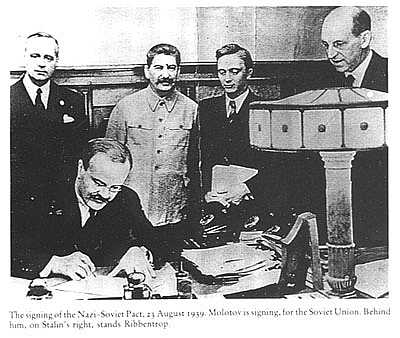
[from
R.Watt, Bitter Glory].
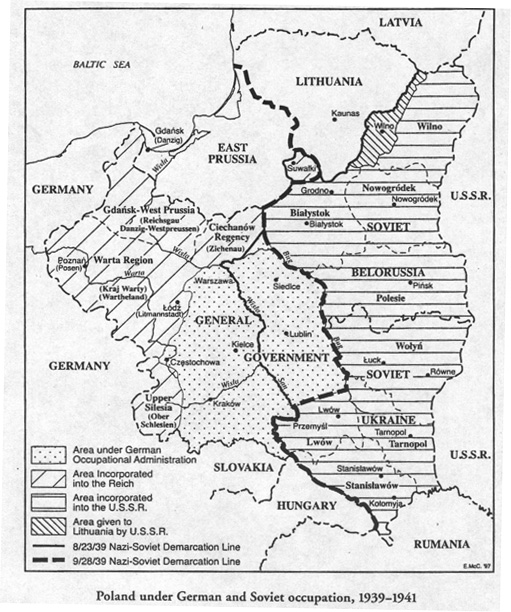
[from: Tadeusz Piotrowski, Poland's Holocaust. Note the two different German-Soviet lines of Aug. 23 and
Sept. 28, 1939 in Poland and Lithuania.
All Soviet authorities denied the
existence of the Secret Protocol until end December 1989, when it was disclosed
that a "verified copy" had been found in the Soviet archives, and the
Secret Protocol was condemned by the freely elected Supreme Soviet.
The original Russian copy was "found" in the Kremlin
Presidential Archives somewhat later. Only the Non-Aggression Pact was known in
1939, but it shocked world opinion, especially communist party leaders outside
the USSR who had been propagating the anti-fascist line.
It is worth noting that the Aug. 23
German-Soviet "demarcation line" in Poland (including the addition of
the Pisa river) was actually shown on a map printed in the Soviet paper Pravda
[Truth] on 23 September 1939 (see below), probably as a reminder to the
Germans, who had already gone east of it. Interestingly enough, in the Secret
Protocol Stalin was willing to leave Lithuania to Germany. In the Soviet-German
Treaty of Sept. 28, Hitler recognized Soviet dominant interest in almost all of
Lithuania. In exchange, Stalin gave up a part of Poland gained in the Secret Protocol
and agreed to pay Germany several million dollars.
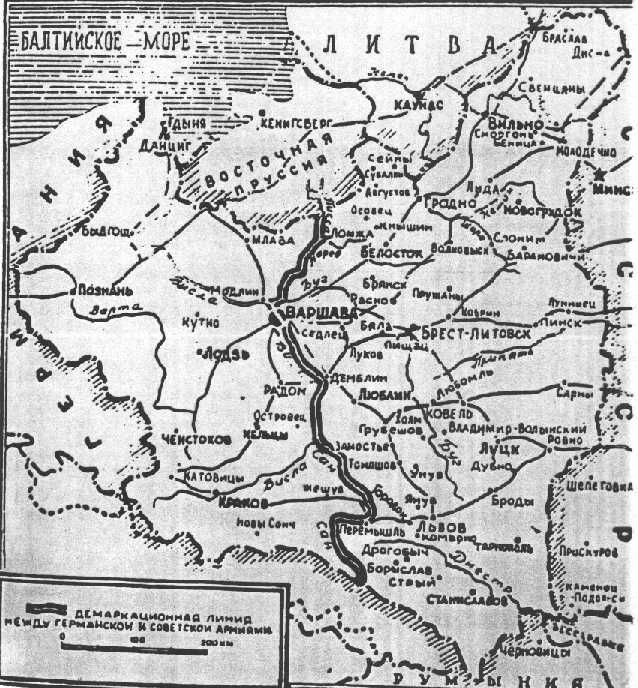
The
German-Soviet "demarcation line" in Poland (according to the Secret
Protocol of Aug.23, 1939, amended on September 22 to include the Pisa
river).
Pravda, Sept. 23, 1939.
When the Nazi-Soviet Pact gave
Hitler a free hand to attack the Poles, the British government decided to
conclude a Mutual Assistance Treaty with Poland, signed in London on August
25. The timing of the signature, 5 p.m., was set to coincide with the
delivery of a letter from Mussolini to Hitler - which the British
ambassador in Rome had encouraged him to send - saying that Italy was not ready
for a war with the Western Powers unless it received enormous amounts of raw
materials and arms from Germany. The combination of the treaty and the letter
made Hitler cancel his orders, given on August 23, for an attack on Poland to
start on August 26. However, the cancellation failed to reach a German unit on
the Polish-Slovak border, so it got into a fire fight with the Poles and
retreated.
Chamberlain and his Cabinet saw the
treaty with Poland as a deterrent to Hitler, for they still hoped for a
negotiated German-Polish agreement granting Hitler what he wanted. Therefore, Birger Dahlerus, a Norwegian businessman
and friend of Goering, shuttled secretly between London and Berlin in late
August. His mission was to persuade Goering and Hitler to work for such a
result. It was even agreed that Goering would pay a secret visit to England,
but Hitler cancelled it when he had the agreement with Stalin in hand.
On August 27, Chamberlain told the Cabinet that Poland could at most accept the
return of Danzig to Germany and a German extra-territorial highway and railway
through the Corridor. He said this despite the fact that the Polish government
had always viewed this solution as unacceptable. Therefore, Chamberlain was
expressing his opinion, and not that of Britainís ally.
Hitler made an apparent ploy for peace, but German armed forces
had orders to attack Poland on September 1, so his aim was to place the blame
for war on the Poles. At midnight on August 29, Ribbentrop quickly read
to the British Ambassador, Sir Nevile Henderson, a list of terms for Poland
which would allegedly ensure peace. Danzig was to return to Germany
but Poland would keep its rights there; there was to be a plebiscite in the
Polish Corridor, but all Poles who were born or settled there since early 1919
would have no vote, while all Germans born, even if not living there, would. (Hitler
did not seem to realize that there was a Polish majority in this region
according to the Prussian census of 1910, see Lec. Notes 11, The Rebirth of
Poland). Poland would have guaranteed access to the sea. There would be an
exchange of minority populations between the two countries. If Poland accepted
these terms, Germany would agree to the British offer of an international
guarantee, but this would now include the Soviet Union. A Polish
plenipotentiary (with full powers) was to arrive in Berlin to accept these
terms by noon the next day.
The British Cabinet thought the
terms were "reasonable," except the demand for a Polish
Plenipotentiary which was too much like the Czech President Hacha accepting
Hitlerís terms in mid-March 1939; they feared outrage in British public
opinion. The British government had asked the Poles a few days earlier if they
were ready to negotiate, to which Beck said yes -- providing the terms were
not contrary to vital Polish interests, (which were: Danzig to continue
to exist as a Free City, and the Polish Corridor to continue to be part of
Poland).
At this time, on August 29-31, the Sir Nevile Henderson
exerted great pressure on Polish Ambassador Jozef Lipski to accept Hitlerís
offer. It is clear from British documents, that Henderson acted in
agreement with Halifax, though he exceeded his brief because he was openly in
sympathy with German demands. Sir Horace Wilson -- who shared their views --
told him to be careful on the phone because it was bugged by the Germans.
In Warsaw, the British and French
Ambassadors now pressed the Polish government not to proclaim
mobilization -- which was viewed as having triggered World War in 1914. The
Polish government agreed, but proceeded to mobilization by mail (post cards).
When Ambassador Lipski went to see Ribbentrop on August 30, he was presented
with Hitlerís demands. Ribbentrop asked the Ambassador if he had full powers to
sign. When Lipski said he had come to receive the German terms, Ribbentrop
ended the meeting. The German radio then broadcast Hitler's demands with the
comment that Poland had rejected them.*
*[For an account of these events, focusing on British and French policy,
see: Anna M. Cienciala, "Poland in British and French Policy in
1939..." in Finney, cited earlier].
It is clear that the conclusion of
the Nazi-Soviet Pact removed any fears Hitler may have had about risking a
European war by attacking Poland, and this seems to put the onus on Stalin.
Some historians have claimed-- as is the official Russian position today,
August 2009 -- that Stalin had no other choice because he had to obtain
security for the USSR, which faced the Germans in the West and was fighting the
Japanese in the Far East. This is the line followed by some Russian historians
and most Russian media today, along with charging Polish For. Minister Beck
with following a pro-German policy in 1939; some media even charge him with
being a paid Germana agent. These charges are designed to show that Stalin had
no choice but to go with Hitler; there is no explanation how and why a
pro-German Beck, or as a German agent, rejected Hitler's demands and secured
first, a British guarantee of Polish indeepence, and then an alliance with
Britain.
. Russian TV showed a film on Aug.
23,2009, claiming that Poland was in cahoots with Hitler and had even planned
to attack the USSR in tandem with Germany and Japan (!). The film also claims
that Poland had a secret agreement with Hitler, attached to the Jan. 26 1934
Polish-German Declaration of Non-Aggression, valid for ten years.There was no
such secret protocol. On the contrary, Poland had signed a Non-Aggression
Treaty with the USSR in July 1932 and Foreign Minister Jozef Beck travelled to
Moscow in Feb. 1934, where he signed a 10-year extension of the treaty.
The USSR did not offer an alliance
to Poland in 1939. Soviet Deputy Foreign Commissar V. Potemkin, told Beck on
May 10 that the Soviet Union would observe benevolent neutrality in case of
war. The Soviet ambassador, Sharonov, also stated around this time that Moscow
would consider asssistance to Poland if the latter asked for it. These statements were not equivalent to the offer of an
alliance to Poland, as some historians claim.
Another argument used by pro-Kremlin
authors is that of Soviet security. They assumes that it would be strenthened
by the seizure of eastern Poland and later the Baltic States so Stalin must
have aimed to control the main access routes into the USSR: the northern route through
the Baltic States and the southern route through western Ukraine, then S.E.
Poland; the Polesie marshes lay inbetween. (The the Soviet government drained
the marshes after World War II.) In fact, however, the new German-Soviet
frontier of Sept. 28 1939 brought German armies that much closer to Moscow (see
Piotrowski map above). The Germans regained former eastern Poland in about two
weeks in June-July 1941, while also overunning the Baltic States. If they had attacked a couple of weeks earlier, Hitler might
have held a victory parade in Moscow. Stalin had done nothing since occupying
eastern Poland in September 1939, to prepare for the defense of these
territories. His worst error was refusing to believe the warnings sent by
Churchill and Roosevelt in spring and summer 1941, also his man in Tokyo,
Richard Sorge, that Hitler was prepring to attack the USSR. We may assume he
rejected these warnings because they did not fit his timetable for Soviet
readiness to fight Hitler, or/and he may have believed Hitler would not risk
such a war. We do not, however. know what Stalin was thinking because
theRussian documents, which might clarify the issue, remain inaccessible in
Russian archives.
It should be mentioned, that Soviet
military intelligence reported in late 1938 that Hitler was planning to attack
Poland next, and that his main goal was the destruction of the USSR.But no such
warnings came in 1939. As it happened, Hitler turned against Czechsoslovakia,
then Poland, but Stalin may have expected Poland to accept Hitler's demands and
become a willing satellite of Germany in an attack on the USSR.
The most balanced Russian statements
on the whole issue were made by Vladimir Ryzhkov (b.1966), who had
represented Barnaul, (Siberia) in the Duma in 1993-2007. He became head of the
Republican Party of Russia, which was refused registration for the elections of
2005. Ryzhkov sees responsibility for the outbreak of the war as shared by
France and Britain, although the Ribbentrop-Molotov Pact also played a major
role. Nevertheless, the main responsibility if, of course, Hitler's.*
*(For Ryzhkov's statements on the
Ribbentrop-Molotov Pact, see "Detrimental Denial," Moscow News,
no.32, 2009. Ryzhkov is now professor at the Higher School for Economics, and
chairman of the political organisation "Russia's Choice.").
Just ahead of the 70th anniversary
of the German attack on Poland in 1939, and on the eve of his own visit to
Gdansk, along with other statesmen for the celebrations, Russian Prime Minister
Vladimir Putin wrote an Open Letter to the Polish people, printed in Gazeta
Wyborcza, Aug. 31, 2009. He stated that the Russian Duma had condemned the
Secret Protocol to that Pact in Dec. 1989, and it was, of course, immoral. He
pointed out, however, that the Ribbentrop-Molotov Pact should not be seen as
causing the outbreak of WW II. He said that the roots of the war went back
further, and pointed out the Munich Agreement of Sept. 28, 1938, in which
France and Britain had agreed to the cession of part of Czechoslovakia, the Sudetenland,
to Germany, while Poland took a part of Czechoslovakia (western Cieszyn/Teschen
Silesia). He mentioned the sad fate of Soviet prisoners of war in Poland in
1920 *and also mentioned the Versailles Treaty of 1919 ( a hint at German
resentment of losing Danzig and the Polish Corridor to East Prussia). He also
recalled that Poland had annexed a piece of Czechoslovakia in fall 1938.**
*[NOTE by Cienciala: Out of 100,000
Soviet Prisoners in Polish captivity in 1920, Polish and Soviet historians agreed
that 16-18,000 died of malnutrition and hunger (Russ. lang. book on Red Army
Men in Polish Capitivity, 1919-1920, published Moscow, 2004). About 40,000
returned home to Russia, while the rest either joined anti-Bolshevik forces or
found some kind of a living in Poland. While the Polish camp commanders can be
charged with not providing enough food and medication to the prisoners, we
should note that in 1920 there was general malnutrition as well as a typhoid
epidemic in Poland. Herbert Hoover's American Relief Administration (ARA) saved
the lives of thousands of Polish children. The ARA also saved many lives in
Russia, where famine raged at this time.]
Adam Michnik, the founder and editor-in -chief of Gazeta Wyborcza,
answered Putin in the same newspaper. He welcomed Putin's conciliatory
statements and hope for better Polish-Russian relations. He also pointed out,
however, that while the Polish annexation of (disputed) Czech territory was
immoral, the new Polish administration there did not shoot or deport any Czechs
in that area (as the Soviets did to Poles and others in Eastern Poland,
1919-41). As for the Soviet prisoners of war in Poland in 1920.Michnik stressed
the fact that none of them had been shot in the back of the head. ***
Putin's speeach on Sept. 1, 2009, at
the meeting of of several European leader in Gdansk,was much shorter and more
conciliatory to Poland Polish Premier Tusk spoke in the same spirit.
** As for the Versailles Treaty
solutions of the Free City of Danzig and the award of the predominantly Polish
Pomerania (Corridor) to Poland, these were compromises fair to both sides. Of
course , the Germans resented the separation of East Prussia from Germany, but
the predominantly Polish population of the Corridor could not be put back under
German rule. Communication with Germany was assured by six trains crossing the
Corridor every day while most of the bulk trade went by sea, as it had done
before the World War I.. It should also be noted that all German governments
before Hitler -- and at first, Hitler as well -- demanded revision of the
German-Polish frontier, which meant not only the return of Danzig and the
Corridor but all of former Prussian Poland to Germany. Hitler at least put
these demands on the back burner by agreeing to the Polish-German Declaration
of Non-Aggression of Jan. 26, 1934. See Lec. Notes 14a.]
As for the date of the Soviet attack
on eastern Poland , Sept. 17, if Stalin waited to see whether the French Army
would attack Germany in the West, it was clear by Sept. 16 that it would not do
so. He ordered the attack to take place
on Sept.13, but postponed it to Sept. 17 on being assured by the Germans that
they were about to take Warsaw. (In fact, it surrendered on Sept.27.)
As for the Japanese-Soviet conflict
in the Far East, it may have been a factor in Stalin's policy before 23As
August 1939, but by that time the Japanese forces involved in the Nomonhan area
were being beaten back by Army Commander (later Marshal) Georgy Zhukov,
and an armistice was signed on Sept. 16. Furthermore, the Soviet mole in Tokyo,
Richard Sorge (1895-1944), informed Stalin in summer 1939, on the basis
of his contacts with high Japanese officials, that Japan would not be ready for
war for another two years, and it was not planning to attack the USSR. (The Japanese finally arrested Sorge, but Stalin refused
Tokyos's offers of exchaning him for some Japanese officers, so he was executed
in 1944.)
Some historians believe that
Stalinís decision to line up with Hitler was most likely based on an alleged
key assumption of Soviet policy: that a war between the capitalist powers would
lead to their mutual exhaustion and therefore pave the way to the establishment
of communist governments in Europe, presumably under Soviet control.
Indeed, one can deduce as much from Stalin's statement to Georgii Dimitrov,
head of the Comintern (Communist International) on Sept. 17. According to
Dimitrov's diary, in early Steptember Stalin said the longer France and Britain
fought Germany, the better, and he would help both sides. Also, Poland was a
fascist state which oppressed the Ukrainians and Belarusians and there was
nothing wrong with gaining territory for the USSR and expanding Socialism. *
*(Diary of Georgii Dimitrov,
1933-1948, introd. by Ivo Banac, (Yale Univ. Press, 2003), entry for
Sept. 7, 1939.).
As for the argument that the
Ukrainians and Belarusians suffered under Polish rule, there is no doubt that
they resented it, but Soviet rule was much worse. Stalin forced
collectivization on Soviet peasants and used famine to break resistance in
Soviet Ukraine in 1932-33. This led to the death of an estimated 5 million
Ukrainians. There was famine in other parts of the USSR, but nowhere was it as
dreadful as in Ukraine. Many peasants, who lived on the Soviet side of the
border, fled to Poland.
We do know that Stalin was shocked
by the rapid defeat of France in May-June 1940. He seems to have expected a
longer stand off . Of course, in the short run the USSR would profit by gaining
territory which could be viewed as a buffer against German attack. but it
proved not to be such in 1941. Indeed, Stalin did not make use of the time he
had to strengthen hist western defenses against Germany. On the contrary, he
ordered the destruction of the old Soviet fortifications on the former
Polish-Soviet border, which would at least have held up some German forces, and
he did not build any new ones. Was he perhaps thinking of removing obstacles to
a future Soviet attack on Germany? No one can give absolutely sure answers to
questions about Stalin's policy in 1939 because the relevant Russian documents
are still inaccessible to historians.
6. The German Attack on Poland
and the Outbreak of World War II.
On September 1, 1939, several German
armies attacked Poland from the West, North and South-West. To justify this aggression, German
propaganda faked a Polish "attack" on the radio station in the Upper
Silesian town of Gleiwitz (now Gliwice, Poland) , and this was broadcast to the
world. (After the war, it was found that the SS - Security Police - had used
German political prisoners dressed in Polish uniforms, and murdered them after
the "attack" to eliminate witnesses. The sturdy, wooden radio tower
still stands in Gliwice toda).
The French and British governments
delivered warning notes
in Berlin on September 1,
stating that if the German army did not withdraw from Poland, they would
immediately fulfill their obligations to that country. At the same time,
however, the British government encouraged Mussolini to propose a great
power conference, this time including Poland, and the French government
supported this move. On September 2, Mussolini informed the British that he was
trying to get Hitler's consent, but thought he was unlikely to withdraw
his forces from Poland unless he first got what he wanted. Mussolini also said
that Hitler asked for time until midnight September 3, to answer Mussoliniís
proposal. Meanwhile, German armed forces continued their attack on Poland.
The British Cabinet met at 4 p.m.
September 2. Halifax reported
Mussoliniís information and proposed the deadline for Hitlerís answer to
the British and French notes be set at midnight September 3. The
Cabinet decided for midnight the same day, Sept. 2, but left the
"coordination" of French and British action to Halifax.
That evening, September 2,
Chamberlain spoke in the House of Commons and Halifax in the House of Lords. They
stated that if German forces withdrew from Poland, then the British government
would treat the situation as if nothing had happened, and would support
Polish-German negotiations, or a wider conference. They did not give a deadline
for Hitlerís answer to the British note.
The staid House of Lords, which
respected Halifax, heard him out in silence -- but there was uproar in the
House of Commons. Chamberlain was told that he must report to the House the
next day by 11 a.m. There was a revolt in the Cabinet too. Therefore, on the night of September 2, Chamberlain told
the French government that Britain had to act, and instructed Ambassador
Henderson to deliver a note to Ribbentrop the next day at 9 a.m. demanding an
answer by 11 a.m. Henderson did so, and the French ambassador delivered a note
demanding an answer by 5 p.m.
When there was no answer from Hitler
by 11 a.m. Setp 3, Chamberlain spoke on the radio stating that Britain was at
war with Germany. The French government stated the same at 5 p.m. Thus, the
German attack on Poland and Polish resistance brought about the outbreak of
World War II.
7. The German-Polish War,
September 1 - October 5, 1939.
The Polish General Staff, government
and the Polish people expected Britain and France, especially the latter, go
give them military aid, as per their agreements, by attacks against Germany in
the West. However, Poland received no help from the its allies. The French
manned the Maginot Line and made a few probing forays into West Germany, after
which they withdrew. General Maurice Gamelin (1872-1958),
Commander-in-Chief, Allied Forces, told the British on September 12, that he
had ordered the withdrawal of French forces from Germany [small forces had gone
a few miles forward], and that he would not attack Germany even if the Poles
resisted for three months -- because their task was to gain time for France. *
*[For source, see Cienciala in
Finney, cit above.]
The French and British had about
1,600 first line planes against 600 German planes in the West; they had 2,600
tanks against some 850 -- while about 1,600 were in Poland. About 100 French
divisions faced 26-30 German divisions, most of them manned by reservists; and
the Siegfried Line -- the German defense line in the west-- was still
unfinished. The two powers, had, however, agreed to be on the defensive if
Germany attacked Poland; they did not tell the Poles.
The Poles had about 400 planes, most
of them outdated, facing 1,800 German planes. They had about 300 light,
French-made tanks facing about 1,600 German tanks. A German warship pounded the
Polish munitions depot at Westerplatte -- just north of Danzig harbor-- where
the Polish garrison fought gallantly for 12 days. Other warships were pounding
Polish defenses on the tiny Hel peninsula west of Gdynia; the fortifications
there were the last to surrender to the Germans.
The German airforce did not destroy
most of the Polish planes on the ground, as is often stated in books about this
war. In fact, they had been camouflaged or moved elsewhere to prevent this from
happening. Most of these planes -- which were outdated in any case --were
destroyed in air battles. The German airforce did, however, wreak havoc with
the Polish rail and road network. It also attacked undefended towns and
villages. Indeed, Hitler had given orders to German airmen that they were
to show no mercy to the Polish population. The Polish government
appealed to the British to bomb Germany, but Lord Halifax finally told
Polish Ambassador Edward Raczynski that this would not be done, and
Poland must wait for allied victory.
In fact, British planes carried out
one raid on the German naval base at Wilhelmshafen, and made a few
desultory sorties over the Ruhr. They did no more than that, so people thought
this was to avoid German retaliation against London. In fact, British and
German air force experts knew that German bombers could not do carry havy bombs
to London, unless they flew from airfields in western France - as they were to
do in the Battle of Britain, 1940-41.
The Polish defense plan seemed strategically absurd: the Polish army was to try and
hold the whole length of the German-Polish frontier and retreat slowly when
forced to do so. But the Polish General Staff had two reasons for this
strategy;(a) they feared that giving up Western Poland with its industry and
Polish population in order to hold a defensible line on the Vistula, might lead
Hitler to offer peace negotiations to France and Britain , which might
recognize his conquests; (b) the Franco-Polish military protocols of May 19,
1939, stipulated that the Polish armed forces were to delay the German advance
along the whole front line until the French army was ready to attack Germany in
the West, that is, on the 16th day after the start of the German
attack (15 days for mobilization). The French airforce was to bomb Germany.
However, as stated earlier, the French had no intention to do so, or to launch
an offensive against Germany, so Poland was left to fight alone.
Finally, the retreating Polish High
Command planned to regroup its forces in south-eastern Poland, near Romania,
which was expected to receive French and British arms and planes to pass on to
the Poles. These plane, however, became inoperative once the USSR attacked
Poland on Sept. 17.
|
|
|
[pictures
and captions from: R.Watt, Bitter Glory - The Marshal is shown at
a parade, wearing a winter coat and sporting a dress saber].
7.The Soviet attack on Poland.
The Red Army entered eastern Poland
on September 17. Stalin and Molotov had resisted German pleas to march into
Poland after the German attack began, but it is clear from Russian documents
(available in 1989-90) that although the Soviet western military districts of
Minsk and Kiev were mobilized and the original orders were for them to attack
on 9 September, the attack was postponed to September 17.
No reason is documented for the delay. It may be that Stalin was waiting
for an agreement with the Japanese to end the fighting in the Far East, and
this took place on September 13 with the armistice signed three days later. Or
he may have waited to see what the French and British would do, particularly
the French, would attack Germany in the West; or he waited for the fall of
Warsaw to the Germans. Also, there were no signs of preparations for a French
offensive against Germany.
There was some difficulty in
agreeing on the text of the Soviet declaration justifying the Soviet move.
German and Russian documents show that Molotov at first proposed a statement
saying the Red Army was coming in to save its Ukrainian and Belorussian
brothers from the Germans, but this was unacceptable to the Berlin so it was
later changed to giving them security and the Polish people the chance for a
happier life (!) Finally, when the Germans informed Moscow on Sept. 16 that
Warsaw was about to be fall (it did not), Stalin and Molotov informed the
German Ambassador at 2 a.m. on September 17 that the Red Army would enter
Poland at 6 a.m. that day.
The Polish Ambassador in Moscow, Waclaw
Grzybowski (1887-1959, ambassador in Moscow 1937-39), was handed a note at
3 a.m. on September 17 by Deputy Foreign Minister Vladimir P. Potemkin
(1874-1946), who had summoned him to his office. The note, drawn up by Molotov
and sent also to all foreign diplomatic representatives in Moscow, stated that
since Warsaw had surrendered and the Polish government had ceased to exist
(neither of which was true), the Soviet government considered its treaties with
Poland as no longer in force. The ambassador refused to accept the note, but it
was delivered to the embassy while he was talking with Potemkin. He
informed the Polish government which, together with the diplomatic corps, was
by this time on the Polish-Romanian frontier. (The information was sent via the
Polish Embassy in Bucharest.)*
At first, some in the Polish
government and military thought the Russians might be coming to help
Poland, but very soon it was clear this was not the case.
Therefore, the Polish government -- then located almost on the Polish-Romanian
frontier, with Romania over the bridge on the Dniester River -- decided to
cross into Romania with the intention of proceeding to France and continuing
the fight from there. In fact, the French ambassador supported this plan, while
the head of the French military mission, General Faury, persuaded the Polish
Commander-in-Chief, Marshal Edward Smigly-Rydz (sometimes called
Rydz-Smigly), not to stay and fight to the death in Poland as he intended, but
proceed through Romania to France and build a new Polish army there. All this
was not public knowledge, however, so the government and the commander-in-chief
were condemned by German and Soviet propaganda, as well as by Polish public
opinion, for abandoning the Polish people while Polish army units were still
fighting the Germans.
As it happened, the chief ministers
of the government and Rydz-Smigly were interned by the Romanians, who
did so under heavy German pressure. Nevertheless, they allowed President
Ignacy Moscicki to leave for Switzerland. (He had worked there as a scientist
before World War I and had dual Polish and Swiss citizenship.) Also, thousands
of Polish military were allowed to make their way, mostly through Yugoslavia
and Italy (which gave Poles reduced group fares on the Italian railways to
spite the Germans) to join the new Polish army in France. Hungary also allowed
this to happen, so that about 35,000 Polish military reached France and formed
a new army there, along with 20,000 Polish immigrants (mostly coal miners),
already living in France. A new Polish government was formed in Paris on
September 30, 1939, with General Wladyslaw Sikorski * as Premier - and
soon also Commander-in-Chief of Polish armed forces - and Wladyslaw
Raczkiewicz ** as President. The former Polish government remained interned
in Romania and For. Min. Jozef Beck died there on 5 June 1944, a day before the
D-Day Allied landings in north-west France.
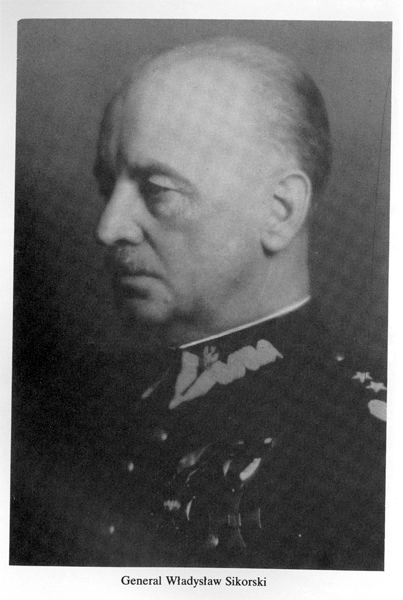
* [Wladyslaw
Sikorski, 1881-1943, Premier 1922-23, War Minister 1923-24, in the opposition
after Pilsudskiís coup of May 1926. Died in an air crash off Gibraltar on July
4, 1943.]
** [Wladyslaw
Raczkiewicz, 1885-1947, held various ministerial and adm. posts in interwar
Poland; President of the Polish government-in-exile, London, 1939-47.]
Marshal Rydz-Smigly, before
crossing to Romania, issued an order to Polish forces not to fight the Russians
unless the latter tried to disarm them, also for Polish soldiers and officers
to make for Romania and Hungary. This order reached some units but not others.
In fact, there were some pitched battles with the Red Army, but for the most
part Polish soldiers surrendered to the Russians -- who had orders to prevent
any Polish forces leaving the country for Romania and Hungary. The Polish
commander in Lwow (now Lviv), General Wladyslaw A. Langner (1897-1972)
chose to surrender to the Russians rather than the Germans, who were encircling
the city but withdrew as the Red Army advanced. His representatives signed an
agreement with the representatives of Komandarm [Marshal] Semyon K.
Timoshenko (1895-1970), that he and his men would be set free. However,
they were taken prisoner and sent to the NKVD concentration camp in Starobelsk,
eastern Ukraine. (Langner himself was allowed to travel to Moscow, where he pleaded
for the release of his men. He was promised that they would be freed, but on returning
to Lwow found they were not, so he decided to cross the border into Romania and
joined the Polish army in the West.)
Of the Polish prisoners estimated at
250,000 or more, most of the rank-and-file, also NCOs from former eastern
Poland (now western Ukraine and western Belarus) were sent home, but the
officers were selected out and sent either to Starobelsk, south-east of
Kharkov (now Kharkiv) in Ukraine, or to a another concentration camp, Kozelsk,
south of Smolensk in western Russia.. Police, gendarmes, some officers, also
some civilians - mainly employed in law courts - were sent to Ostashkov,
just north of Smolensk. (See map of concentration camps in Lec. Notes. 16B).
About 40,000 rank-and-file soldiers who came from German-occupied Poland, were
delivered later to German authorities. In exchange, the Germans gave the Soviet
authorities their Ukrainian and Belorussian prisoners who had served in the
Polish Army.
8. Polish Defeat.
The Poles fought
bravely against greatly superior German forces. The biggest battle of the
campaign was the Battle of the Bzura River, in central Poland, where the
Poles fought the Germans for several days.

[from: Steven J. Zaloga and Victor Madaj, The Polish Campaign,1939, New
York, 1985. Note the two, horse-drawn light artillery pieces on the left and
right of the cavalry. They were used as anti-tank guns].
Poland was an economically
underdeveloped country in 1939, so it did not have a modern army, hough it had
a few up-to-date bombers and one armored brigade.
The Polish cavalry was used as a mobile force and never attacked German
tanks, as claimed in some history books. This legend probably originated from
the fact that in one place, when surrounded by tanks, cavalrymen charged
between them to escape. Some Italian journalists reported cavalry charges
against tanks and the Germans made a propaganda film showing Polish cavalry
charging tanks to show Polish recklessness. However, if one looks closely, the
cavalrymen are wearing German helmets (!) Some Polish propaganda officials in
London decided to present this myth as a fact, thinking the British would be
impressed with Polish courage. Instead, of course, they thought the Poles to be
foolish. The myth lives on in some history books to this day as an example of
Polish romantic recklessness.
Warsaw surrendered on September 27 -
on orders from Marshal Rydz-Smigly brought by an officer who flew from Romania
and landed in Warsaw. In any
case, after a three week German siege from land and air there was no more food
or water in the city. The last Polish unit fighting the Germans was
dissolved by its commander at Kock on October 5. Thus, the Poles had
fought the Germans for five weeks,about as long as the much better armed French
and British fought them in May-June 1940.
The Germans took about 500,000
Polish prisoners; released many of the rank-and-file and placed the officers in
special camps. Most of these prisoners survived the war.
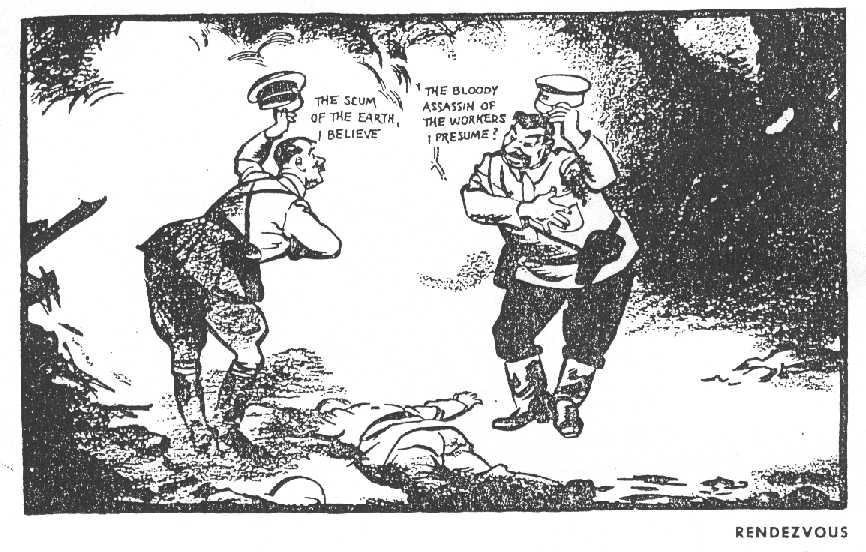
David
Low Cartoon [Britain, September 1939].

[from: An Atlas of Russian History. The map does not show the original
demarcation line which went through Warsaw itself; see Piotrowski map above.]
In the German-Soviet Friendship
and Frontier Treaty, signed by Ribbentrop and Molotov in Moscow on September
28, 1939. Stalin gave up some territory in Poland in exchange for Soviet
dominant interest in the whole of Lithuania - except for Memel which
would stay with Germany and Wilno (now Vilnius), which was to go to Lithuania.
He also agreed to pay Hitler several million dollars in gold. The new
German-Soviet frontier in Poland, which was similar to the Curzon Line, came to
be known as the Ribbentrop-Molotov Line, although the line of August 23,
which cut Poland in half, deserves to be called the first line with this name.
( See the Piotrowski map of Poland 1939-41 above, shown under the photo of
the signing of the German-Soviet Nonaggression Pact).
A secret protocol to the treaty of 28 September 1939,
specified German-Soviet cooperation against any Polish attempts at resistance.*
Several meetings between the Gestapo and the NKVD are known to have taken place
in German-occupied Poland. No records have been found, but clearly agreements
were reached on cooperation against Polish resistance of any kind.
[* "Both
parties will tolerate in their territories no Polish agitation which affects
the territories of the other parties. They will suppress in their territories
all beginnings of such agitation and inform each other concerning suitable
measures for this purpose.," Documents on German Foreign Policy,
ser. D, vol. VIII, Washington, London, 1956, doc. no. 160].
German Losses in Poland.
The Germans lost about one sixth of
their front line planes and about one quarter of their tanks, plus armored cars
and some 15,000 dead in the war with Poland; the Poles lost about 60,000 men.
The Germans expended all their bomb stocks. It was these losses, and not just
the weather, that made Hitler decide not to attack France in October, as he had
planned.* The
Germans took about 450,000 prisoners, whom they placed in POW camps, divided
into officer and regular camps.
* [see: Steven J. Zaloga nad Victor
Madaj, The Polish Campaign, 1939, New York, 1985].
German occupation policies.
The Germans immediately began to
arrest and shoot prominent Poles, also all those with higher education
("Operation Tannenberg."). There was also a violent German
"reprisal" for an alleged Polish massacre of German civilians in
Bydgoszcz [pron, Bydgoshch, formerly Bromberg] called "Bloody Sunday"
by German propaganda. Polish civilians were massacred in reprisal.
Most Polish historians claim that some
Germans had shot at retreating Polish troops, while the Germans denied it. It
was only recently that Polish researchers found German Military Intelligence
(Abwehr) documents in the German Military Archive, Freiburg, showing there was
a 150 member German civilian battle-sabotage group in Bydgoszcz, which
attacked Polish military units retreating from the city on 3-4 September,
provoking Polish reprisals.A study on this subject was to be published by the
Polish Institute of National Remembrance in 2008.* The Germans shot several
hundred Poles in revenge.
*["Historycy wytropili
dywersantow," (Historians traced and found the Diversionists), Gazeta
Wyborcza, Warsaw, Sept. 5, 2007. On German atrocities against Polish
civilians during and after the campaign, see Alexander B. Rossino, Hitler
Strikes Poland. Blitzkrieg, Ideology, and Atrocity, Lawrence, KS., 2003.]
Conclusion.
Polandís lone fight gained precious
time for the Western Powers, a time used well by the British who were producing
600 fighters a month. The French, however, produced far fewer planes. Their
military leaders also disregarded the lessons of the German
"Blitzkrieg" in Poland -- they said it could not happen in France --
and did not change their war plans accordingly.
Polish troops fought the Germans in
Norway in spring 1940 and in France in May-June 1940. The Polish government
escaped to Britain when France was falling in June 1940, and about 20,000
Polish military managed to make their way there while some were interned in
Switzerland. Of those who reached Britain, the most important were Polish
airmen who fought in the Battle of Britain. (Some came by sea from Romania,
registered as Jewish refugees going to British Palestine !) After September 15,
when these airmen were allowed to fly and fight (the British had feared
communication difficulties since most of the Poles did not know English), they
made up 10% of RAF pilots and racked up many kills, specially Squadron. 303,
which became famous, even though the pilot with the most kills was a Czech.
(The Czechs were also fighting in the RAF at this time.) From June 1940 until
the USSR came into the war in June 1941, the Polish military were the only
armed force actively fighting on the British side against Germany.
[For Poland under German and Soviet
occupation, see 16B, part. II].
*********************
LECTURE NOTES 16B. Eastern Europe in
World War II: October 1939-May 1945.
Introduction.
As discussed above, World War II was
sparked by the German attack on Poland and by Polish resistance to this attack.
Poland had the largest underground movement in Europe, with the
anti-communist Home Army [Armia Krajowa - A.K] being the largest after Tito's
communist-led Partisans. (The Armia Krajowa had 400,000 soldiers in August
1944, while Tito's Partisans numbered about 800,000 in 1945). Poland was also
the only German-occupied country which had a fully developed underground
administration, known as the "Underground State," which
recognized the Polish government-in-exile located first in France, then in
Britain. Finally, the most contentious issue in Western-Soviet - mostly
British-Soviet - relations in WW II --- was the future Polish-Soviet frontier.
Therefore, the focus of these lecture notes will be on Poland. However, first
there will be a brief survey of the war in the rest of Eastern Europe. (On
Poland see III)...
After Poland, the next E.
European country to fight the fascist powers was Greece. Italian forces
invaded Greece from Albania at the end of October 1940. British
reinforcements landed in Crete and other Greek islands, and British planes
bombed Italian warships at Taranto. (The Russians also sent some planes to help
the Greeks). However, most of the fighting was done by the Greeks, who broke
through Italian lines in Albania and occupied part of that country.
Greece was isolated because Romania
and Bulgaria soon joined the Axis or Tripartite Pact signed by
Germany, Italy and Japan on September 27, 1940, and Yugoslavia signed it on
March 25, 1941. However, a coup organized in Belgrade by Serbian
officers, with British support, overthrew the Regent, Prince Paul, and his
government on March 26-28, 1941, and the almost 18-year old Peter (born 1923),
was proclaimed King as Peter II.
The new government did not want to
provoke Hitler, and proclaimed Yugoslav neutrality. When it hesitated to grant
the German army transit to Greece, German planes bombed Belgrade on April 6
1941 causing great civilian casualties, while German troops poured in and
overran the country. Of course, Belgrade crowds had demonstrated to show they
were anti-German, so the code name for the German attack on the city was
"Punishment." The USSR, which had just signed an alliance with
Yugoslavia, quickly backed out. King Peter and his government were
evacuated to Britain. [For Yugoslavia, 1941-45, see below].
At the same time as their attack on
Yugoslavia, the Germans invaded Greece.
The Greeks -- who had pushed invading Italian forces back into Albania -- were
beaten by the Germans, signed an armistice on April 23, 1940 and King George II
left the country for Britain. A British Expeditionary Force of 60,000 managed
to save most of its men, but lost much valuable equipment. Moreover, German
forces parachuted into Crete destroying part of the British forces there
and forcing the evacuation of the rest. Greece suffered heavy population
losses under the German occupation, mostly by starvation. Greek Jews were
deported to Nazi death camps in German-occupied Poland.*
*[For the German occupation of
Greece, see Mark Mazower, Inside Hitlerís Greece. The Experience of
Occupation 1941-1944, New Haven, CT., 1993].
Greek resistance was mostly carried
out by the communist-led National Liberation Front (Greek acronym, EAM) and its
armed forces, (Greek acronym, ELAS), although there was also a republican
resistance movements (Greek acronym: EDES), which was supported by Britain and
received the largest share of supplies. Churchill supported the restoration of
the Greek monarchy under King George II, whose exile government was located in
Cairo, under British protection. FDR also supported George II, although both
British and American experts warned their governments that most Greeks opposed
the restoration of the monarchy. However, Churchill believed that only the
return of George II to the throne could mobilize Greek opposition to a
communist takeover of Greece. Churchill also aimed to get Stalin's agreement to
stay out of Greece - always seen as a key British ally in the Mediterranean.
In October 1944, Churchill went to
Moscow (his second trip there, the first
being in Aug. 1942,) and proposed a division of influence in the Balkans.
Stalin agreed and they concluded the "Percentage Agreement," whereby
Stalin recognized Britain as having 90% influence in Greece, while Churchill
recognized the USSR as having 90% influence in Romania and Bulgaria. They were
to share 50-50% influence in Hungary and Yugoslavia. [See II 4 D below].
In late December 1944 the Germans
withdrew form Greece and British forces landed in Athens followed by Prime Minister Churchill and Foreign
Secretary Anthony Eden who both arrived on Christmas Day 1944. Greek
Communist leaders seemed to accept the temporary government of Archbishop
Damaskinos as Regent, but a Civil War broke out in 1946 and lasted until
1949, when the Communists lost. Stalinís policy in this period was
generally in keeping with the October 1944 agreement with Churchill, but it it
is known that Czechoslovak arms reached the Greek communists through Bulgaria
(both countries were under Soviet control). It is also known that in 1947, the
Soviet Politburo supported the plans of the Greek communists to capture part of
the country with Saloniki as the communist capital. Ultimately, Stalin seems to
have decided that it was better to avoid antagonizing Britain and the US over
Greece and the communists lost the civil war.
I. East Central Europe in World
War II (except Poland)
1..
The Baltic States
As mentioned earlier, part of Lithuania
was recognized as being in the Soviet sphere of influence, and part in the
German sphere (Secret Protocol to the Nazi-German Non-Aggression Pact, Aug.23,
1939). In late September 1939, however, Stalin ceded some of his Polish
territory to Germany in exchange for Soviet influence in all of Lithuania
(Soviet-German treaty of Sept. 28, 1939).
Stalin first forced the Baltic
States of Estonia, Latvia and Lithuania to sign treaties with the USSR
alllowing the stationing of Soviet troops (Sept-Oct. 1939). He then occupied
these states in June 1940 -- when France fell -- and organized rigged elections
to turn them into Soviet Republics. The Soviet political and economic system
was imposed on these countries; also,
tens of thousands of people were
imprisoned and deported to forced labor camps -- the GULAG-- and "special
settlements" in Siberia and Soviet Central Asia (Kazakhstan, Uzbekistan)..
It is not surprising that when
German troops entered the Baltic States, they were welcomed with open arms. The
Jews, some of whom had supported the Soviet-style governments, were subjected
to terrible pogroms. Some citizens volunteered for the German army and the SS.
Soviet troops returned in 1944-45, when tens of thousands of people were again
deported to Siberia, while those who could, fled to Germany. The Baltics again
became Soviet republics, but the memory of independence was strong and they
were to regain it in 1991, with the collapse of the USSR.
--------------------------------------------------------------------------------------------------------------------------------------------------------------------------------------
Reading:
For brief accounts, see: David
Sitra, "Remembering the 1941 Baltic Deportations," in: REEIfication,
News from Indiana University's Russian and East European Institute, vol. 32,
no. 1, Feb. 2008, pp.4, 11; Saulis Suziedelis, "The Perception of the
Holocaust: Public Challenges and Experience in Lithuania," in EES [East
European Studies, Woodrow Wilson International Centre for Scholars, Washington,
D.C.)Jan-Feb. 2008, pp.7-10. For detailed coverage, see Jean Sedlar, Hitler's
Empire in East Central Europe.
----------------------------------------------------------------
Finland refused Soviet demands for military and naval bases on its
territory, deemed necessary by Stalin for the defense of the USSR. Therefore,
the Red Army attacked on November 30, 1939, beginning what is generally called
"The Winter War." The Finns gave a good account of themselves against
Soviet troops, but they could not win without outside help and this was
missing. Germany had recognized Finland as being in the Soviet sphere of
influence in August 1939, so it did not help. France and Britain planned to
send an expeditionary corps but failed to do so because neutral Norway and
Sweden refused passage to their troops. In any case, The British and French
governments wanted to draw the USSR away from Germany. Ultimately, they sent
troops (including Poles) to northern Norway in a bid to prevent German control
of ports through which Swedish ore was shipped to Germany. However, Hitler was
one jump ahead, attacking Denmark and Norway at the same time, so the
expeditionary corps was late and had to be withdrawn, suffering losses. Finland
was forced to sign peace with the USSR on March 12 1940, losing some territory,
but managed to recover it in summer 1941, when the Germans attacked the USSR.
It lost again in 1944-45, coming under Soviet control, but never comparable to
the East European states.
[For detailed coverage and
bibliography see Sedlar work cited above. The best analytical survey of all of
E.Europe in WW II is by Mark Mazower, Hitler's Empire. How the Nazis
Ruled Europe, New York, 2008].
------------------------------------------------------
--------------------------------------------------------------------------------------------------------------------------------
2. THE CZECH LANDS.
a. BOHEMIA-MORAVIA
Some Czechs joined a Czechoslovak
Legion in Poland, which became part of the Polish Army and fought the Germans
in September 1939. Many of these soldiers were taken prisoner by the Red Army
after it invaded eastern Poland (Sept.17,1939). More Czechs managed to reach
France and established an armed force there, later in Britain.
There was no military resistance
movement in the Czech lands until late 1944. A puppet Czech administration
collaborated with the Germans - but it was also in touch with the
Czechoslovak government-in-exile headed by Edvard Benes in London.
German occupation policy was mild in comparison with the ruthless terror in
Poland, the western Soviet Union, Greece and Yugoslavia.
This policy became much harsher when
Reinhard Heydrich (1904-1942, succeeded von Neurath as the
"Protector of Bohemia and Moravia". His assassination in May 1942,
was carried out by Czech soldiers parachuted from England. (Their hiding place
was betrayed by a fellow soldier, but they fought to the death). In reprisal,
the Germans burned down the village of Lidice, allegedly for hiding the
parachutists. They executed the men and deported the women and children. They
made no secret of this, and world opinion was outraged --as it would also be by
the German destruction of the little town of Oradour- sur- Glane in
France in July 1944.*
*[Hundreds of villages were burned
down and their inhabitants murdered by the Germans in Poland, Belarus, Russia
and Ukraine, for cooperation with the Partisans and other resistance units,
including Home Army units in former eastern Poland. About 300 villages were
burned and their inhabitants murdered in Poland alone].
Nevertheless, life in the Czech
lands was much easier than in occupied Poland or the western USSR. A film about
Czech resistance was made in the 1960s, titled "Closely Watched
Train,." It won an Adacemy prize in 1966
and is a film classic.*
*[For Czechs under German
occupation, see Vojtech Mastny, The Czechs under Nazi Rule. The Failure of
National Resistance, 1939-1942, New York and London, 1971; for military
resistance in late 1944- early 1945 as the Red Army was entering
Czechoslovakia, see Radomir Luza with Christine Vella, The Hitler Kiss. A
Memoir of the Czech Resistance, Baton Rouge, LA, 2002 ("The Hitler
Kiss" was the name Czech resistance fighters gave to death by a German
bullet, thus avoiding capture and torture.]-
Edvard Benes, President
of the Czechoslovak Government-in-Exile (London), decided to cooperate with the
Soviets in 1942. He favored a Polish-Czechoslovak Confederation -- but only if
Poland agreed to Soviet territorial demands. (He and T.G. Masaryk had supported
a revision of Poland's eastern frontier in the interwar period and
Czechoslovakia had been an ally of the USSR in 1935-39). Therefore, the Soviet
authorities allowed the release of some Czech military who had fought in
Czechoslovak Legion as part of the Polish army in September 1939 and were taken
prisoner by the Red Army, but they had to sign a declaration that they would
not fight against the USSR. Eight hundred of them signed the declaration,
travelled in 1940 via Turkey to France to join Allied forces there, then to
England. Some, however, remained in the USSR. They later formed the nucleus of
the Czechoslovak Armed Force in the Red Army
b. SLOVAKIA
Slovakia was a German satellite state headed by a Catholic priest, Father
Josef Tiso (1887-1947). He succeeded Father Andrey Hlinka (who
died in 1938) as leader of the largest Slovak party. Tiso cooperated to some
extent with the Germans in allowing the deportation of Slovakia's Jews to
German death camps in Poland in Feb.- March 1942. In doing so, he at first disregarded
the appeals of the Papal Nuncio in Slovakia, to spare the Jews.. The Slovak law
of May 1942 exempted certain categories of Jews, especially the converts to
Christianity, but only President Tiso could issue exemptions. When the Germans
refused to allow Slovak inspection of the deportations, Tiso stopped them.
About 35,000 Jews survived until the Slovak uprising against the Germans in
August- September
1944, when most of the remaining Jews were deported by the Germans to Auschwitz
or to a camp in Slovakia.* An excellent film showing the persecution of Jews in
Slovakia was made in the 1960s, titled "The Shop in the Main Street"
(1965) starring the famous Polish-Jewish actress Ida Kaminska. (It won an Oscar.)
Nevertheless, this Slovak satellite
state did in some measure fulfill its peopleís desire for independence, and its
memory fueled the desire for a Slovak state, which was established in 1992.
There was a small Slovak communist
resistance movement, and a combined communist and non-communist uprising broke
out against the Germans in central Slovakia on August 30,1944. The fighting
went on until October 17, always in hopes of Soviet aid. However,as in the case
of the Polish Home Army Warsaw Uprising (August 1-October 2, 1944), the Red
Army did not help, and the reason seems to have been the same - Stalinís
distrust of the insurgents.*
*[On wartime Slovakia, see: Yehuda
Jelinek, The Parish Republic (1976), and Livia Rothkirchen,
"Vatican Policy and the 'Jewish Problem' in 'Independent Slovakia,' "Yad
Vashem Studies, VI (1967), pp. 27-53l; also comments by readers. For a
sympathetic view of Slovakia in World War II and an account of the Slovak
uprising of 1944, see: Stanislav J. Kirschbaum, A History of Slovakia. The
Struggle for Survival, New York, 1995,ch.9, 10].
President Benes returned to
Prague via Moscow in May 1945. He presided over a coalition government until
the communist coup of February 1948, when he resigned. He died a few months
later. [See Lec. Notes 17].
. HUNGARY IN WORLD WAR II.
In 1939-41,Hungary made territorial
gains at the expense of Romania, the USSR, and Yugoslavia.

[From: The Corvina History of Hungary, edited by Peter Hanak,
Budapest, 1999].
However, in September 1939, the
Hungarian government did not allow the transit of German troops through
northern Hungary (Slovakia) against Poland. Also, like the Romanian government,
Admiral Horthy gave asylum to several thousand Polish troops, and
allowed most of them to proceed to France. (
Later, however, some Hungarian
troops fought alongside the Germans against the Russians.)
Horthy also welcomed refugee Polish Jews and opposed the
deportation of Hungarian Jews to German death camps in Poland. In October 1944,
he tried to negotiate peace with the approaching Russians, but was kidnapped by
the Germans and taken to Germany. The new government, headed by the Ferenc
Szalasi (1897-1946), leader of the fascist "Arrow Cross" Party,
began to round up Hungarian Jews and deport them to the death camps. That is
when the Swedish representative of the International Red Cross in Budapest, Raoul
Wallenberg (1912-1947), acted to save many Jews by issuing them Swedish
passports. He was attached to the Swedish Embassy, and it is known that he was
in touch with American intelligence. He was arrested by the Soviets and died in
a Soviet prison, date unknown. Soviet governments denied knowledge of his fate,
but in the late 1950s it stated that he had died of a heart attack. Some Soviet
Jews, who had been imprisoned, stated after leaving they the USSR in the 1970s,
that they had seen him in various prisons. Finally, in 2001 Aleksandr N.
Yakovlev, head of the Commission to Rehabilitate Victims of Stalinist
Terro, said that Wallenberg had been arrested as a "spy" and had died
in prison, though the circumstances of his death were unknown. *

*[ On Hungary in World War II, see
Peter Sugar et al., eds., A History of Hungary, ch. XVIII, pp.
339-355. On the Holocaust in Hungary, see: Bibliography, pt. II. On
Wallenberg, see Andrew Handler, A Man for all Connections. Raoul Wallenberg
and the Hungarian State Apparatus, 1944-1945, Westport, CT., 1996].
For an excellent survey of East
Central Europe, which also includes Finland and has an extensvie bibliography,
see Jean Sedlar, Hitler's Central European Empire 1938-1945.
Booklocker.com.Inc., 2007.
II. South-Eastern Europe (The
Balkans).
1. YUGOSLAVIA, 1941-1945
Yugoslavia was dismembered. Northern Slovenia was incorporated
into the German Reich, while its southern part went to Italy, which also took
over the Dalmatian coast. Croatia, enlarged by Bosnia, became an
"independent" state. In fact, Croatia was a German puppet state
occupied by German and Italian troops. It was ruled by the fascist Ante
Pavelic (1889-1959, pron. Pavelich), with the "Ustashe"
(Insurgents) as his military/police force. They set out to kill as many
Serbs and Jews as possible.
Hungary took over the Yugoslav part
of the Banat, as well as Backa and Voevodina.
Serbia was dominated by the Germans, with a collaborationist Serb
government in Belgrade,
Resistance began almost immediately,
led by a Serbian royalist officer, Dragoljub (Drazha) Mihailovic
(1893-1946). He and his "Chetniks" (detachments) harried German and
Italian forces, but often made provisional truces with them. The Yugoslav
communists, led by Josip Broz Tito (1892-1980), who was head of the
Yugoslav Communist Party since 1937, wanted to fight the Germans right away,
but were ordered by Moscow to sit tight. They got into the war after the
German attack on the USSR, June 22, 1941. Titoís "Partisans" had a
difficult start in the mountains of western Serbia, but grew in strength as
German and Italian oppression increased.
In mid-1943, the British government,
influenced by reports of the Chetniksí extensive cooperation with Italian
forces, decided to switch its support from Mihailovic to Tito. Some historians
claim the reports were slanted by Communists in the British intelligence
service, who did not report Titoís temporary agreements with Germans and
Italians and assigned Chetnik victories to Tito, but it is unlikely that this
influenced British policy. The British Military Mission with Tito reported
favorably on the Partisans and they obtained British arms drops from mid-1943
on. By spring 1945, Tito's forces are said to have numbered around 800,000.
About one million Yugoslav citizens
lost their lives in the war. but most were killed in the fighting between
the Serbs and Croats. The Moslem Bosniaks generally sympathized with the
Germans, although the "ehnic cleansing" action by the Chetniks made
many seek protection from Tito's Partisans. The Albanian Kosovars also
sympathized with the Germans and Italians, but this was not surprising given
their treatment in interwar Yugoslavia. Kosovo came under Italian
occupation, and so was united with Albania, as it had been under Ottoman rule.
Thus, the Kosovars realized that an Axis victory would prevent the return of
Serb rule over Kosovo.
|
Tito
and Moshe Pijade, fall 1942. |
[On the Chetnik-Ustashe fighting and
its victims, see: Tomislav Dulic, Utopias of Nation: Local Mass Killings in
Bosnia and Herzegovina, 1941-42, Uppsala, Sweden, 2005; favorable review by
Robert M. Hayden, Slavic Review, vol. 66/3, fall 2007, pp. 529-530..
For the history of the Partisan
struggle, see the memoirs of Titoís right hand associate, later opponent, Milovan
Djilas, Wartime, New York and London, 1977. The best scholarly treatment
of wartime Yugoslavia is in Jozo Tomasevich, War and Revolution in
Yugoslavia, 1940-1945. Occupation and Collaboration (2001) and The
Chetniks (1975). For an attack on the Tito legend, see Nora Beloff, Titoís
Flawed Legacy. Yugoslavia & the West since 1939, Boulder, CO., 1985.
See also Phyllis Auty and Richard Clogg, eds., British Policy towards
Wartime Resistance in Yugoslavia and Greece, London and New York, 1975].
Yugoslavia was dismembered. Northern Slovenia was incorporated
into the German Reich, while its southern part went to Italy, which also took
over the Dalmatian coast. Croatia, enlarged by Bosnia, became an
"independent" state. In fact, Croatia was a German puppet state
occupied by German and Italian troops. It was ruled by the fascist Ante
Pavelic (1889-1959, pron. Pavelich), with the "Ustashe"
(Insurgents) as his military/police force. They set out to kill as many
Serbs and Jews as possible.
Hungary took over the Yugoslav part
of the Banat, as well as Backa and Voevodina.
Serbia was dominated by the Germans, with a collaborationist Serb
government in Belgrade,
Resistance began almost immediately,
led by a Serbian royalist officer, Dragoljub (Drazha) Mihailovic
(1893-1946). He and his "Chetniks" (detachments) harried German and
Italian forces, but often made provisional truces with them. The Yugoslav
communists, led by Josip Broz Tito (1892-1980), who was head of the
Yugoslav Communist Party since 1937, wanted to fight the Germans right away,
but were ordered by Moscow to sit tight. They got into the war after the
German attack on the USSR, June 22, 1941. Titoís "Partisans" had a
difficult start in the mountains of western Serbia, but grew in strength as
German and Italian oppression increased.
In mid-1943, the British government,
influenced by reports of the Chetniksí extensive cooperation with Italian
forces, decided to switch its support from Mihailovic to Tito. Some historians
claim the reports were slanted by Communists in the British intelligence
service, who did not report Titoís temporary agreements with Germans and
Italians and assigned Chetnik victories to Tito, but it is unlikely that this
influenced British policy. The British Military Mission with Tito reported
favorably on the Partisans and they obtained British arms drops from mid-1943
on. By spring 1945, Tito's forces are said to have numbered around 800,000. *
About one million Yugoslav citizens
lost their lives in the war. but most were killed in the fighting between
the Serbian Chetniks and the Croatian Ustashe. The Moslem Bosniaks generally
sympathized with the Germans, although the "ehnic cleansing" action
by the Chetniks made many seek protection from Tito's Partisans. ** The
Albanian Kosovars also sympathized with the Germans and Italians, but this was
not surprising given their treatment in interwar Yugoslavia. Kosovo came
under Italian occupation, and so was united with Albania, as it had been under
Ottoman rule. Thus, the Kosovars realized that an Axis victory would
prevent the return of Serb rule over Kosovo.
*[On British policy, see Auty and
Richard Clogg, eds., British Policy towards Wartime Resistance in Yugoslavia
and Greece, London and New York, 1975
**[See: Tomislav Dulic, Utopias
of Nations: Local Mass Killing in Bosnia and Herzegovina, 1941-1942,
Uppsala, Sweden, 2005, rev. in by Robert M. Hayden, Slavic Review,
66/3, Fall 2007, pp. 529-530]
2. ROMANIA IN WORLD WAR II.
In 1940, Romania lost a large
part of Transylvania to Hungary, Southern Dobrudja (gained from Bulgaria 1913)
to Bulgaria and Bessarabia as well as northern Bukovina (both of which had
significant Ukrainian-speaking populations) to the USSR. The Germans entered
Romania in the fall of 1940, on Romanian government invitation, to
"protect" the oil fields and refineries, but they did not occupy the
country.
Romanians fought the Red Army on the
Eastern Front (USSR) alongside the Germans in 1941-45. Nevertheless, the
pro-German government of general Ion Antonescu (1882-1946), gave good
treatment to most Polish internees and refugees, allowing many politicians and
thousands of military to escape West, to France. He bowed to German pressure in
not allowing former Polish Foreign Minister Jozef Beck to escape, or even go to
a sanatorium in Italy for TB treatment, but did not turn him over to Berlin.
[Beck died of TB in Romania on 5 June, 1944].
Antonescu helped save some Romanian
Jews; most of those in the Old Kingdom survived, and he welcomed those who fled
from Hungarian Transylvania to Romania. [See Filderman inset below]. At the
same time, however, he did not try to prevent the slaughter of thousands of
Jews by Romanian troops and civilians in Bessarabia after Soviet troops
withdrew and the region was rejoined with Romania in summer 1941. Most of the
Jews in Bessarabia did not speak Romanian and were considered disloyal because
of cooperation with Soviet authorities in 1940-41; however, about 65,000 Jews
living in Transnistria survived. Antonescu also bears responsibility for
the expulsion of Jews from Bukovina - under Soviet rule 1940-41- and for the
Romanian army's massacre of Jews in Odessa (a Black Sea port just west of
Crimea), which came under Romanian rule. In all three regions, Ukrainians
participated in the slaughter. *
*[see: Radu Ioanid, The Holocaust
in Romania. The Destruction of Jews and Gypsies under the Antonescu Regime,
1940-1944, Chicago, 2000].
Antonescu tried but failed to
interest the British in a separate peace. In late August 1944, the young King
Michael overthrew Antonescu, formed a new government, and declared war on
Germany. This must have annoyed Stalin, who had his own Romanian communists
ready to take over the country. Indeed, the western powers at first supported
Michael, but soon bowed to Soviet policy. Michael fled the country in 1947,
when it came under complete communist rule.*
|
(from
a:: A History of Romania, Iasi, 1997)* |
|
*[for an overview of Romania in
World War II, sympathetic to Antonescu, see A History of Romania, edited
by Kurt W. Treptow, 3rd edition, Iasi, 1997, ch. V, pp. 467-518. For
more detail, see the fine study by American historian Keith Hitchins, Rumania
1866-1947, Oxford, 1994, ch.11.].
3. BULGARIA IN WORLD WAR II.
Bulgaria profited by regaining Southern Dobrudja from
Romania in 1940. After the outbreak of the war, it also gained Greek and
Yugoslav Macedonia as well as some Serbian territory. However,
Bulgarians did not fight against the USSR and the Soviet Embassy functioned in
Sofia during the war. The government tried desperately to secure a western
instead of a Soviet occupation, but the British and Americans had no intention
of liberating Bulgaria. As the Red Army approached Sofia, the USSR
declared war on Bulgaria. The new Muraviev government failed to prevent a coup
in Sofia led by the Communist-dominated Fatherland Front on September 9,
1944, and Bulgaria declared war on Germany.
Most of the
50,000 Jews living within the borders of interwar Bulgaria were
assimilated Bulgarians. They were not deported to the Nazi death camps in
Poland because of strong opposition by political and religious leaders, as
well as the majority of citizens who considered these Jews to be Bulgarians.
However, the Bulgarian government did allow the deportation of Jews from the
part of Macedonia annexed by Bulgaria from Yugoslavia, to Nazi death
camps in German-occupied Poland
*[On Bulgaria in World War II, see:
R.J. Crampton, A Concise History of Modern Bulgaria, Cambridge, England,
1997, ch.7, pp.170-183. For an overview of the Balkans in World War II, see:
Barbara Jelavich, History of the Balkans. Twentieth Century, ch.7,
pp.247-300. On the saving of Bulgarian Jews, see: Tzvetan Todorov, The
Fragility of Goodness. Why Bulgarian Jews Survived the Holocaust,
Princeton, N.J., 2001].
For
an excellent. year by year history of the region (plus Finland) in WW II and an
extensive bibliography, see: Jean Sedlar, The Axis Empire in Southeast
Europe 1939-1945, Booklocker.com, Inc., 2007.
************************
III. POLAND
The German Occupation of Poland and
the Holocaust in German-occupied Poland.
Poland and The Polish Question in
World War II.
1. The German Occupation of
Poland.
(a) The Polish Corridor and
Western Poland, including Polish Upper Silesia, were annexed to the Reich, also
western Teschen Silesia (annexed to Poland from Czechoslovakia
in early October 1938, see end of Lec.Notes 15).
German ethnic cleansing in western
Poland.
In fall 1939 and winter 1939-40, up
to June 1941,the Germans forced about 300,000 mostly urban Polish citizens,
including Jews, out of their homes in the annexed territories (Western Poland),
generaly at 20 minutes' notice. They were allowed to take one suitcase, were
pushed into unheated cattle cars, and deported to central Poland during the
harsh winter of 1939-40. Many old people and infants died on the way. This was
an early example of "ethnic cleansing." The Poles were to be replaced
by Germans. Some of the latter came from Polish territories annexed to the
USSR, some from the Baltic States (annexed June 1940),some from Bessarabia and
some from the Italian Tyrol. However, not as many Germans came in to replace
the expelled Poles as Nazi authorities expected.

[German
ethnic cleansing of western Poland, annexed to the Reich. Poles being led to
trains under German army escort.]
[See Rossino, Hitler Strikes
Poland, Lawrence, KS, 2003, and a detailed study, Philip T. Rutherford, Prelude
to the Final Solution. The Nazi Program for Deporting Ethnic Poles,
Lawrence, KS, 2007 .]
The Nazi policy of murdering Polish
citizens, to December 1939.
It is estimated that about 60,000
Polish citizens were murdered in the annexed territories and in German-occupied
Poland between late September and end 1939; of these, at least 7,000 were Jewish.
(Alexander B. Rossino, Hitler Strikes Poland, p.234). In the annexed territories this was
done in the SS "Operation Tannenberg."
Central Poland was organized as the
"General Gouvernement" (French spelling of government),
which was meant to be a Polish reservation. After the German attack on the
USSR, this region was extended to include former south-eastern Poland (East
Galicia). The German governor, Hans Frank lived in the royal castle,
Wawel, in Krakow.
German occupation policies
Hitler planned to make the Poles a
nation of slaves, to be terrorized into obedience. Therefore,
(i) prominent people in every
locality were arrested immediately as hostages when German troops
arrived. Many were shot, at once, others later. For e.g. in Tomaszow
Mazowiecki, which had a Germany minority and a large Jewish population, many of
the Polish school teachers were taken "hostage" and shot. German policy was to kill all educated Poles.
(ii) The Faculty of the
Jagiellonian University, Krakow, were called to meet with a German officer on
November 8, 1939. This was a ruse, for they were arrested and deported to the
concentration camp of Sachsenhausen, Germany. Though some were released, mainly
on the request of prominent Italians, many died either in the camp or after release.
In the General Gouvernement, Poles
were not allowed any education beyond elementary and vocational schools, and
these were scarce.
(iii) The Germans requisitioned food
produce from the peasants, so the farmers had delivery quotas with severe
punishment if the quotas were not met. The Germans also took the mineral
resources, mostly coal, and forced Poles to work in factories for the German
war effort. Poles had ration cards but rations, set at 750 calories,were far
below needs so many died, particularly in the harsh winter of 1939-40. There
was a flourishing black market where people with money could buy almost
anything, but most people did not have large amounts of money. The Germans abolished
Polish currency and established a new one, so people who had savings lost them.
Most people tried to get a job approved by the Germans, so they could have an
I.D. work card that would prevent deportation to forced labor or a
concentration camp. Most sold what they could and did odd jobs to make a
living. Those fortunate enough to have relatives in the West could get parcels
sent through neutral countries like Portugal, Switzerland and Sweden.
(iv) There was terror. The
penalty for one German killed was the shooting or hanging of up to 100 Poles
arrested at random. (The ratio in France was 10 Frenchmen for 1 dead German).
In practice, the number of Poles executed depended on the local German
commander. Also, there were more executions in Warsaw, the center of Polish armed
resistance, than in Krakow, the seat of German admnistration under Hans Frank.
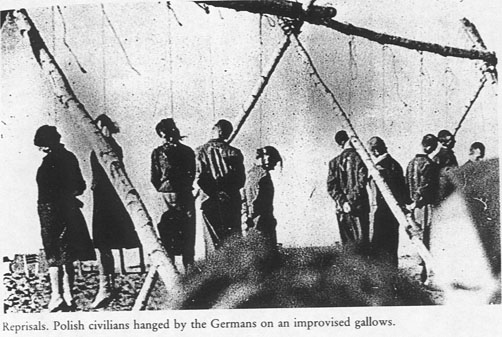
(v) The Germans forcibly ejected
1,710,000 Poles from their homes in the annexed territories, of whom 100,000
were deported for forced labor to Germany; by war's end, the total was over 1
million. There they worked as slaves under very bad conditions. Those who
worked for German farmers generally had enough to eat. Those who volunteered
for work in Germany had better treatment. The
majority of the ejected were deported to occupied Poland.
(vi) The Germans looted Polish art
objects and books.*
(vii) Poles were used by the Germans
at the lowest administration levels as clerks etc. Many helped the underground if
they could, mostly by faking I.D. cards. The "blue police"(prewar
police in blue uniforms) kept their jobs, as police did in every
German-occupied country. Some cooperated with the Germans in hunting down Jews;
some helped to save them.
*[On Poles under the German
occupation, see: Richard D. Lukas, The Forgotten Holocaust. The Poles under
the German Occupation, Lexington, KY., 1986, revised edition, 1990; same, Forgotten
Survivors. Polish Christians Remember the Nazi Occupation, University Press
of Kansas, Lawrence,KS, 2004; Jan T. Gross, Polish Society under German
Occupation: The Generalgouvernement. 1939-1944, Princeton, N.J. 1979, Gross
is v. critical of the Polish attitude toward the Jews..]
For photographs of occupied Poland
by German soldiers, see "Bagnowka"
The German Persecution and
Extermination of Polish Jews.
In 1939, out of 8.3 million Jews
living in Europe -- including the USSR, where Jews numbered some 3,3 mln
--about 3.275.000 lived in Poland, where they made up 10.5% of the total prewar
population, the highest such percentage in the world. [See Polish population
statistics and figures on Jewish populations in the world given below.]
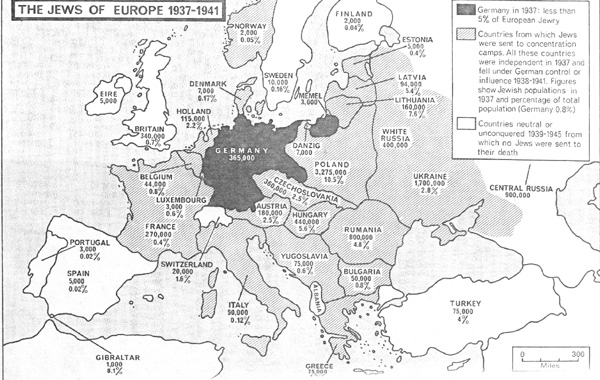

[Maps from: Martin Gilbert, Atlas of Jewish History, New York, 1984].
At first the Jews were forced
to wear the Star of David on their clothes. Very soon thereafter, many were put
in labor camps but most were forced to live in ghettoes which the Germans set
up in 134 Polish towns. The largest one, in Warsaw, was opened in October 1940.
Later, ghettoes were set up in seventeen towns in former eastern Poland, which
the Germans conquered from the Soviets in summer 1941.* Conditions were
appalling so there was a very high death rate. However, some Jews were put to
work producing goods for the German war effort, and they had somewhat better
conditions. Jewish Councils ran the ghettoes, which had their own Jewish
police. In summer 1942, the Germans began to deport Jews from the ghettoes to
the death camps.
*[Philip Friedman, Roads to
Extinction, 1972, p. 72]
The attitude of ethnic Poles toward
the Jews in German-occupied Poland.
We should bear in mind that Poles
and Jews had lived side by side for centuries -
but apart. Most of the Jews were
Orthodox,that is, observing all the Jewish laws and customs. They lived their
own way of life in their communities, preserving their religion and customs,
coming into contact with ethnic Poles mainly through trade. Most Jews were
artisans, who were very poor. However, a small, assimilated minority -- about
10% of the total Jewish population --made up over 50% of Poland's doctors and
lawyers, and owned about 60% of Polish industry. Most of the retail trade,
incl. shops, was also in Jewish hands. Thus, there was little social contact
between Poles and Jews except for the Jews who were assimilated Poles.
Furthermore, news that the Jews in Soviet-occupied Poland were cooperating with
the Soviets against the Poles (only a small minority did so, but blame was
extended to all ), strengthened old Polish feelings of distrust into hostility.
Finally, most Poles found it difficult to make ends meet and faced German
terror every day. For all these reasons, most of the help from Poles to Jews
was given to assimilated Jews by their Polish friends or professional
colleagues.
Beginning in October 1941, the
Germans imposed the death penalty for any help given to Jews. However, in the fall of 1942, when the Polish underground
learned the Warsaw Jews were being taken to the death camp in Treblinka,
an underground organization was set up to help save Jews, code- named"Zegota"
(pron. Zhegotah). It is estimated that hiding and feeding one Jew and moving
him/her from one hiding place to another required the help of 10-12 Poles.
These Jews and their protectors had to watch out for Polish black mailers
(shmaltzovniks), who made money by threatening to inform German authorities
where the Jews were hidden. (They rarely informed on them, however, because
they would lose the blackmail money, which was often far less than the German
rewards.)
The Polish government sent funds to
help "Zegota" from London and so did Jewish organizations in the
West. Help for the Polish underground,including "Zegota," was usually
in the form of U.S. dollars dropped from Polish-piloted planes flying from
Britain to agreed locations in Poland and recovered by the Home Army. "In
all, Zegota raised and distributed funds amounting to $320,000 USD,
equivalent to $3,200,000 in 1995 USD." *
*[See: Those Who Helped. Polish
Rescuers of Jews During the Holocaust, Warsaw, 1997, p.16; Martin Gilbert, The
Righteous. The Unsung Heroes of the Holocaust, New York, 2003, chapters
1-7; Irena Tomaszewski and Tecia Werbowski, Zegota, Santa Barbara, Ca.,
2010.]
Zegota was not a large organization
and saved only a small number of lives -- less than those saved by individuals
-- but it was unique as a government-supported organisation and worked in far
worse conditions than in west European countries occupied by the Germans.
Historian Gunnar S. Paulsson
estimates that the largest number of Jews to survive in a large European
city occupied by the Germans, survived in German-occupied Warsaw. The
prewar population of Warsaw was about 1,250,00 of whom about one third or
417,000 were Jews. At its peak, the Warsaw Ghetto held about 450,000 Jews,
including those brought in from other towns. 28,000 Warsaw Jews managed to hide
at any one time on the "Aryan" side, but many who had money were
caught in a German trap (the "Hotel Polski Affair"), while others
perished in the Warsaw Ghetto Uprising of spring 1943 and the Home Army Warsaw
Uprising of Aug-Oct. 1944, so only about 11,500 lived to see the end of the
war. These were "assimilated" Jews, most of whom had Polish friends
or acquaintances who hid them.
Paulsson estimates that 6-9% of the
city's Polish population helped the Jews in one way or another, including 6%
who knowingly provided hiding places, though housing was very tight and they
risked death in doing so. He writes that the Jewish "secret city" in
Warsaw was a remarkable achievement "made possible by the initiative,
courage, and perseverance of the Jews, the heroic altruism of some Poles, and
the common decency of many others as well as Germans. It casts a welcome and
entirely unfamiliar light on the Holocaust as a whole...." *
* [Gunnar S. Paulsson, Secret
City. The Hidden Jews of Warsaw, 1940-1945, New Haven and London, 2002,
p.248. The author is the son a Polish-Jewish Holocaust survivor].
Irena Sandler, a member of "Zegota" is credited with helping to
save 2,500 Jewish children from the Warsaw Ghetto, and personally saving about
600. (See the play "Life in a Jar" written and acted by High School
students from Union City, KS., first performed in 2001). She showed
extraordinary courage, but she could not have done so much without the support
the RGO [Rada Glowna Opiekuncza = Main Protection Council] for which she
worked, and of the "Zegota" organisation.
Most of the Jewish children, that
were hidden all over Poland,were placed in Catholic convents and orphanages.
They had to learn the Catholic Catechism because German inspectors visited and
demanded that "suspect" Jewish children recite it as proof that they
were "Christian." Those who survived were reunited with their
families, if they had any, and of those who had none some voluntarily converted
to Catholicism after the war.
However, most of Polandís Jews were
unassimilated and thus had few if any social contacts with Christian Poles.They
died either in the ghettoes or in the death camps. The largest of these was Auschwitz-Birkenau
(P. Oswiecim-Brzezinka), followed by Chelmno, Belzec, Treblinka, and Majdanek.
The largest death camp of all, Auschwitz, was in Polish territory annexed to
the German Reich. We should bear in mind that that Auschwitz proper held Poles
and other nationalities, while Birkenau held Jews. Many ethnic Poles died in
Auschwitz, including a cousin of the author of this text.* Most of the Jews
were, however, murdered in former eastern Poland.
* [Ewa Cienciala, b. 1896,who is listed
as no. 35497/1943, and recorded as having died on 12 December 1943, see: Death
Books For Auschwitz, State Museum of Auschwitz-Birkenau, K.G. Saur,
Munich-New Providence, London-Paris, 1995, vol. 2, A-L, p.176. On Auschwitz,
see also Appendix at end of Lec.Notes 16B].
In late November 1942, an emissary
of the Home Army, Jan Karski, arrived in London and
informed the Polish government of what he had seen in a death camp [probably
Belzec or a camp nearby]. He had entered it in a borrowed camp-guard uniform
to see with his own eyes what was going on. He also brought an appeal
from two rabbis in the Warsaw Ghetto, asking the Allies to take action to stop
the genocide of Polish Jews. He had
personally gone into the Ghetto and reported what he saw there.
The Polish government informed the
Allies and called publicly for allied retaliation measures against Germany,
such as special bombing raids accompanied by information on why these took
place, or bombing the railway lines leading to the death camps. The first was
rejected out of hand as not being a military action, and the second on the
grounds that Allied planes should only bomb military objectives. Thus, the
I.G.Farben works, just next door to Auschwitz, were bombed, but not the camp.
Many British and American officials
did not believe the reports of the genocide of the Jews. Also, many prewar
British and U.S. officers had anti-Semitic attitudes which carried over into
the war. Whether or not this played any role in policy, the standard answer
to pleas for special bombing of Germany, or bombing railway lines to stop the
genocide of the Jews, was that bombing was confined to military objectives for
this would lead to victory in the war. In any case, it is unlikely that that
bombing the railway lines to Auschwitz - which was within bombing range from
Britain - would have reduced the number of victims, because such lines could be
repaired very quickly. It is also unlikely that special bombing, advertised as
punishment for the genocide of the Jews, would have succeeded in changing
Hitler's policy, for the Germans resented any and all bombing of their
homeland. Even the dreadful "carpet bombing" of Bremen, Hamburg and
Dresden did not provoke the German people to rise up against Hitler, although there
were a few heroic individuals who dared to oppose him.
The massacre of the Jews of
JEDWABNE, July 10, 1941.
In 2000, an
American sociologist and historian of Polish-Jewish origin (his mother was an
ethnic Pole), Jan T. Gross, published testimony showing that on
July 10, 1941, just after the Soviets withdrew and the Germans came in, Poles
had massacred Jews in the small Polish town of Jedwabne, about 90
kilometers north-east of Warsaw, which had been in the Soviet-occupied part of
Poland in 1939-41. His book, Neighbors, first published in Poland in
2000, sparked a nationwide discussion, and an English translation was published
in the U.S. in April 2001. [see appendix at end of lec. notes 16B].
A heated
discussion ensued in the Polish media on whether Poles actually murdered Jews
in Jedwabne, in which at first a minority accepted the testimony in Gross's
book as true, while a majority rejected it. Of the many initial Polish
reactions, the most balanced was by Adam Michnik, whose father was Jewish
and mother was Polish (he adopted her name), a famous former dissident, and
since 1989 editor of Poland's most widely read newspaper. [See appendix end of
lec.notes 16B].
Most Poles were brought up on
memories of heroic Polish wartime resistance to the Germans and the communist
governments of 1944/45-89, made no effort to note Jewish losses as well as
ethnic Polish losses. On the contrary, even the state-supported Auschwitz
Museum concealed the fact that most of the victims who died there were Jewish. Thus,
the charge that Poles had murdered Jews in Jedwabne was difficult for most
Poles to accept because it challenged the image of heroic Polish resistance
against the Germans, but most came to accept that their countrymen had murdered
the Jews of Jedwabne.
As for the facts of the case,
research since the book's publication has shown that some 40-70 Poles took part
in the massacre, not half the male population of Jedwabne as Gross claims.
Also, the Jewish population of the town was less than 1,600 and the new
estimate of Jews burned in the barn, based on partial exhumation, is about 400.
It is still unclear whether Poles or Germans set fire to the barn.
However, research shows that Jews
were also killed in 22 other small towns in formerly Soviet-occupied north-eastern
Poland; that the killing was sometimes done by the Germans, but mostly by small
groups of Poles under German supervision, and that most of the Polish
population was passive, presumably because of resentment against Jewish
cooperation with the Soviets, but mostly for fear of reprisal if they helped
Jews. Still, a few risked their lives by hiding Jewish friends and lovers,
including amond the latter the author of the main testimony published in Neighbors.
Finally, as Gross himself admits in his book, the Germans were the undisputed
bosses of life and death in Jedwabne so.."it is also clear that had
Jedwabne not been occupied by the Germans, the Jews of Jedwabne would not have
been murdered by their neighbors." [Jan T. Gross, Neighbors,
Princeton, 2001, p. 78; Penguin edition, 2002, p. 47].
We should note that when the Germans
occupied Wilno/Vilnius and its region in summer 1941, Poles did not participate
in murdering the Jews there, but helped them. Perhaps this was because these
Poles saw Lithuanians as their main enemy while many Lithuanians welcomed the
Germans after the Soviet occupation, and many participated in murdering Jews.
Here, Poles and Jews saw the Germans as the enemy. It should be noted that the
Soviet occupation of Lithuania in June 1940- June 1941 was so brutal that most
Lithuanians saw the Germans as the lesser evil.
Some Poles were certainly guilty of
killing Jews, both in Jedwabne and elswhere, but this crime should not burden
the whole nation, for many Poles also helped Jews risking death for themselves
and their families. * It should be noted that in all
the countries occupied by Nazi Germany, the vast majority of people did not
help the Jews. As a rule of thumb, in the face of overwhelming force, some 85%
of people are bystanders; about 10% collaborate in or participate with it; and
about 5% are heroic in helping even unknown targets of violence.
*[See Interview with Prof. Feliks
Tych, Director of the JewishHistorical Institute, Warsaw, June 13, 2005,
Maxveritas.com, appendix to Lec. Notes 16B.
In the first par. he refers to the pogrom in Lviv after the Soviets left and
the Germans entered the city. He denies standard charges that the Poles helped
the Germans murder the Jews. See also Timothy Snyder's article reviewing a
recent book by Christopher Browning and one by Barbara Engelking and Dariusz
Libionka, The New York Review of Books, June 2010, pp.
44-46, link :Timothy Snyder on Jews, Poles and Nazis.
For a discussion of two volumes of
essays and documents on Jedwabne published by the Polish Institute of National
Memory in Warsaw, November 2002, see Anna M. Cienciala, "The Jedwabne
Massacre: Update and Review," The Polish Review, vol. XLVIII [48],
no. 1, 2003, pp. 49-72, reproduced, with corrections of printed errors, in the
appendix to Lec. Notes 16B. See also Gunnar S. Paulsson's assessment in:
Mieczyslaw Biskupski and Antony Polonsky, eds., Polin: Studies in Polish
Jewry. Volume Nineteen, Oxford and Portland, OR, 2007. This volume also has
articles on the Jews of Wilno/Vilnius and one by Polonsky on how Jedwabne
played out in the United States; for a review of this volume by Sean Martin see
The Polish Review, vol. LII (52), 2007, no. 2., pp.264-266).
The Warsaw Ghetto Uprising, spring
1943.
The Warsaw Ghetto was the largest
Jewish resistance action in German-occupied Europe. At its peak, the ghetto
contained about 450,00 Jewish people, which was more than the prewar Jewish
population of Warsaw (about 320,000 out a population of about 1,125,000).
When the Germans entered the Warsaw
Ghetto in January 1943 to deport the 40-50,000 remaining Jews to the death
camps, they seized 6,000 people but backed out on meeting armed resistance.
They came in again on April 19, 1943, with the aim of taking the
rest of the Ghetto population to the death camps. However, a handful of lightly
armed Jews of the Jewish Fighting Organization (Zydowska Organizacja Bojowa -ZOB)
and the Jewish Military Association (Zydowski Zwiazek Wojskowy - ZZW,
whose members were officers of the prewar Polish Army) resisted them,
determined to die rather than be taken to the death camps. * Most of the
remaining Jewish population in the ghetto went underground, hiding in bunkers
built earlier, but there was nothing else these unarmed people could do.
*[ Marek Edelman, 1922-2009, the
last leader of the Warsaw Ghetto forces, estimated there were no more than 200
fighters. He also said that their fight should not be called an
"Uprising," because this denotes some hope of success, while the
Jewish fighters had none. They simply preferred to die fighting. Finally, he
also said that dying arms in hand was no more heroic than dying in the death
camps, for the Jews there knew they were about to die.
Edelman was an extraodinary and
noble human being. After surviving the Ghetto Uprising -- although he did not
use this term -- he fought in the Home Army Warsaw Uprising of summer 1944. He studied
medicine after the war, becoming a well known cardiologist. He refused to
participate in the celebration of the 40th anniversary of the Warsaw Ghetto
Uprising organized by the Polish government in 1983, saying he would not
support a government based on lies and hypocrisy (It was the govt. of General
W. Jaruzelski, who had crushed Solidarity in Dec. 1981.) He died on October 2,
2009, at the age of almost 90 -- see obituary by Michael Kaufman, The New
York Times, October 3, 2009; also obituary in The Economist,
October 10, 2009, p. 91; for a Polish-language obituary, see Joanna Szczesna's
article, Przeglad Polski, New York, October 9, 2009, p. 2. )
The Warsaw Ghetto Uprising of
spring 1943 was a heroic fight put up by a small number of armed Jews who retreated
from bunker to bunker (connected by underground passages) until 12 May,
when all resistance was crushed. The Polish underground army (A.K) tried to
bring in some weapons, but failed to deliver more than a few. They could not
risk a major military action without being wiped out by the Germans, but they
did help some Jews escape and accepted some of them into their ranks.
We should note that there were some
Christians in the Ghetto; these were Jewish converts to Christian religions,
mostly to Catholicism.They could attend services in three parishes; two were
Catholic and one was Protestant; all three were closed by the Germans when they
began to deport the Ghetto Jews to death camps. Two of the Catholic priests who
ministered to the Christians were murdered by the Germans.*
*[See Peter F. Dembowski, Christians
in the Warsaw Ghetto, Notre Dame University Press, 2005. Dembowski was a
member of the Home Army and fought in the Warsaw Rising of 1944. He emigrated
to the U.S. and taught at the University of Chicago.]
The second largest Ghetto was in the
city Lodz (pron. Woots). The head of this Ghetto was Romkowski, whose
policy of cooperation with the Germans led to controversy among scholars of
Jewish history.*
*[See Lucjan Dobroszycki, ed., Chronicle
of the Lodz Ghetto, Yale University Press, New Haven, Ct., c. 1984. For a
recent study (translation of a book published earalier), see Isaiah Trunk, Lodz
Ghetto: A History, Indiana Univ. Press and U.S.Holocaust Memorial Museum,
2006, reviewed by David Engel, Slavic Review v.66, no. 44, winter
2007,pp. 734-735 A Polish lang. memoir was published by Romkowski's secretary
in 2008. See also Arnold Mostowicz, With
a yellow star and a red cross: a doctor in the Lodz ghetto, trans. from
Polish by Henia Nochem Reinhartz, foreword by Antony Polonsky, London, 2005. In
a recent video shown on TV, 2011, Romkowski was characterized as a Nazi
collaborator.]
Of Polandís 3.5 million Jews, some
200,000-300,000 escaped or were deported to the USSR, where most of them
survived. (After the war, they went through Poland to the USA and Palestine,
where the state of Israel was established in 1948). In German-occupied Poland,
about 40-70,000 managed to survive thanks to the help of Poles who risked death
to do so; some of the Polish helpers were killed along with their families.
Some Poles blackmailed hidden Jews, some delivered Jews to the Germans and some
even killed Jews in former Eastern Poland, as the Germans replaced the Soviets
as occupiers in summer 1941. Most Poles, however, stood aside. They were
deterred from giving help not so much by antisemitism, which of course existed,
but by German terror. It was also a fact - mentioned earlier - that the
Christian and Jewish communites had lived separate lives, so there was little contact
barring trade, except between the small minority of assimilated Jews and their
Polish friends or aquaintances. Thus, most survivors were assimilated Jewish
Poles.
Wladyslaw T. Bartoszewski (not to be confused with Wladyslaw Bartoszewski), wrote in
his book The Convent at Auschwitz (New York, 1991) that the Poles could
have done more to help the Jews, but no amount of help could have saved them
because they were doomed (p. 25.) Their extermination was carried out
methodically by the Nazis, who occupied Poland and ruled by terror. Certainly,
there were some Poles who betrayed hidden Jews, and some who even helped murder
them (see Jedwabne above), but there were also those who risked their
lives to help them. Above
all, the main deterrent to helping the Jews was German terror, for Poles risked
the death penalty by helping Jews. A nurse, Irena Sandler, who worked
for an official Polish aid organisation and was also a member of
"Zegota," personally smuggled 450 Jewish children out of the Warsaw
Ghetto and arranged for the rescue of 2,500 children, hiding all the names in a
jar she buried in her back yard. She was captured and tortured by the Germans,
who broke her legs, but she did not give them any information. She continued to
work as a nurse after the war until retiring, and was awarded a high Polish
decoration by President Kwasniewski. A group of school children in Union City,
KS wrote and performed a play about her titled "Life in a Jar," in
2004-05. They also visited in Warsaw. About one third of the memorials in Yad
Vashem, Israel, memorializing gentiles who helped Jews, bear Polish names.
In mid-November 2008, Polish
President Lech Kaczynski awarded state medals -- many of them posthumously --
to 70 Poles who had helped Jews during the war. Among them were Zofia
Brusikiewicz, 81, whose parents had hidden 13 Jews in a Warsaw apartment, and
Irena Gut-Opdyke, whose story is told in the play "Irena's Vow,"
which opened off Broadway in September 2008.*
*[Monika Scislowska,
A.P."Poland awards dozens for saving Jews during WWII," Washington
Post.com. Nov. 17, 2008.]
There is a vast literature on the
fate of Polish Jews, much of which condemns the Poles for working with the
Germans against the Jews, or at least for not giving help - see for e.g. the
Jewish memoirs in the Bibliography section on World War II, although it also
lists works sympathetic to the Poles. For a recent work with documents,see "ZEGOTA"
The Council for Aid to Jews 1942-1945, Selected Documents preceded by an
interview with Wladyslaw Bartoszewski by Andrzej Friszke, edited by Andrzej
Krzysztof Kunert, (Warsaw, 2002). Wladyslaw Bartoszewski was one of the
co-founders of Zegota in 1942. There is
also a book on Zegota by Irene Tomaszewski.
For estimated numbers of survivors,
see Lucjan Dobroszycki, Survivors of the Holocaust in Poland. A Portrait
Based on Jewish Community Records 1944-1947, (Armonk, N.Y., and London,
England, 1994). Dobroszycki estimated that some 300-500,000 Polish Jews
survived, of whom 240-250,000 survived in the USSR. (His number of survivors in
Poland is seen as much too high by some other historians.) The book includes a
list of children who survived due to the help of individual Christian Poles, or
who were hidden in monasteries and convents; also a list of children who
survived by being sheltered in orphanages and childrenís homes, most of which
were run by nuns, though this is not indicated. ( SeeTables 5.1 and 5.2.).
Table 5.3 lists the children redeemed by Jewish organizations and sent abroad
in summer1946 with the goal of settlement in Palestine. Two other tables give
short lists of children who survived in disguise and in two childrenís homes in
Upper and Lower Silesia. Most historians estimate the survivors in
German-occupied Poland at around 40,000, but some give higher figures. A
precise figure may never be established because some records have not survived,
also because of the vast population movements across Poland in 1944-47.
The Jewish Holocaust was unique in
that death threatened every Jew just because of being a Jew. We should note
that the Germans also aimed at the extermination of all the Gypsies of Eastern
Europe, although this was a secondary concern for them. They also applied selective
genocide against the Christian Poles, mostly by targeting educated
people but also anyone who hid or helped Jews, and of course those who either
fought the Germans, or helped those who did. A museum on the history of the
Jews in Poland is to be built in Warsaw.
Polish
Population Statistics
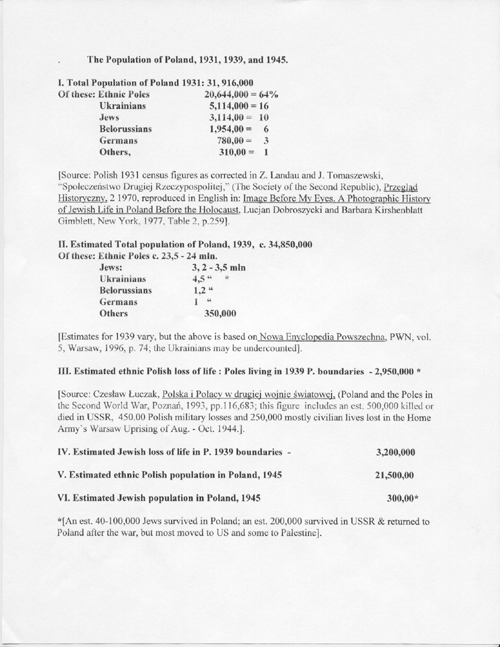

[Note:Together
with the USSR, the number of Jews in E.Europe was 8,3 mln]
On non-Jewish victims of the
Germans, see http://www.holocaustforgotten.com/survivors.htm
2.
The Polish Resistance Movement against the Germans.
(a) Military. Underground
resistance began to form in late September 1939. At first, various political
parties and groups organized their own units. These were combined into the Armia
Krajowa (A.K. = Home Army) and put under one command in 1942. (The National
Democratic forces, called the Narodowe Sily Zbrojne, NSZ (National Armed
Forces) did not join the A.K
In August 1944, the A.K. numbered
some 400,000 members of whom about 100,000 were armed and 40,000 were
concentrated in Warsaw. (Arms were either those buried after the defeat of
Sept. 1939 or, as was mostly the case, bought from the Germans.) Soviet
historians claimed that a million Partisans fought the Germans behind the front
lines in the western USSR (Belorussia and eastern Ukraine), but these numbers
seem vastly exaggerated. Polish historians and most western historians of
Poland state that the A.K.was the largest resistance movement in Europe.*
Titoís Partisans in Yugoslavia are said to have numbered 800,000 but that was
at the end of the war, when conscription transformed them into an army. Unlike
the Soviet and Tito partisans, the A.K. was mostly an urban movement, which was
politically anti-communist. It concentrated on sabotaging German rail and road
transports to the eastern front in Russia, although it also fought some full
scale battles with the Germans in 1943, tying down several German divisions.
A.K. units enjoyed the support of Polish farmers in food and lodgings;
therefore, the Germans burned about 300 Polish villages, murdering the
inhabitants. Polish manor houses were hospitable
to the A.K. -- telling the Germans that losses in horses and other property
handed to the A.K. were due to raids by "bandits." In fact, real
bandits robbed them from time to time.
* [For
a Polish specialist's estimates of the numbers of Soviet Partisans and A.K.
members see Piotr Konieczny talk in Wikipedia: http://en.wikipedia.org/wiki/Talk:
Armia Krajowa#World.27s. largest. 3F.21]
,
A.K. help for Britain. The Czech underground was the first to inform the British
of the German V-1, flying bomb, but it was A.K. members who found an
unexploded, rocket V-2 in a German launch area in Poland, dissasembled it and
sent it to England in a plane which landed in Poland for this purpose in May 1944.
This proved helpful to British authorities in preparing for the V-2 attacks
which began in November 1944, but remains generally unacknowledged in British
publications and a recent TV production (shown in US, 2011) on British aerial
intelligence.
V-2 rocket attacks did more damage
than the V-1 because the V-2 could not be heard coming. The Poles carried out
sabotage on that type of rocket. One V-2 landed in a London apartment, but did
not explode. When the bomb disposal squad opened the rocket, they found the
following message: "Don't worry English, we are with you. Polish
workers." ( Letters to the Editor, Times Literary Supplement,
Jan or Feb. 2008.)
The A.K. planned to rise up against
the Germans as they were retreating from Poland. In former eastern Poland, they were to fight the Germans in
order to document Polish claims to the territory. This became a tragedy in
summer 1944, when the Red Army first accepted A.K. help in fighting the
Germans and then the NKVD arrested the Poles. They were told to join the
communist-led Polish Army. Polish officers who refused were either shot or
deported to the USSR, while rank-and-file soldiers were forced into the
communist-led Polish People's Army. The NKVD also arrested A.K. soldiers and
members of Polish underground civilian author ities in predominantly ethnic
Poland, that is, west of the Curzon Line. [See discussion of Poland in 1944].
(b)The Polish Underground
State. This was headed by a civilian "Chief Political
Council," made up of representatives of the major parties: the Polish
Socialists, the Peasant Party, the National Democrats and the Christian
Democrats. This Council, which later had different names, was chaired by the
"Delegate" of the Polish government-in-exile, which was located first
in Paris, then in London. In fact, however, the Delegate was chosen in Poland
by the leaders of the political parties listed above, and confirmed by the
Polish government. Representatives of the underground state worked in all parts
of German-occupied Poland. Poland was unique among occupied countries in
having both a military underground and an underground state. It is true
that Tito organized an embryonic government in Bosnia, November 1942, called
the "Anti-Fascist Council for the Liberation of Yugoslavia (Serbo-Croatian
acronym: AVNOJ). However,
this council, as well as local governments organized by the Partisans, existed
above ground in areas not occupied by the Germans, who often forced them to
move.
(c ) The Underground Press:
About 600 different publications circulated underground, although the Germans
were on the lookout for distributors and dealt with them ruthlessly when
caught; they were either shot or sent to Auschwitz. The papers reflected
different political groups; there were also periodicals on literature, the
humanities, social sciences, and the arts.
(d) Education An
underground educational system was organized from elementary school
through the Ph.D. Small groups met in private apartments with lookouts posted.
In vocational schools allowed by the Germans, Polish teachers followed the
prewar Polish school program, but if a German inspector was seen coming the
children would be studying the appropriate vocational textbooks. *
*[For Polish underground
organizations and activities, see: Jozef Garlinski, Poland in the
Second World War, Basingstoke and London, 1995, ch. 4 and 10, also by the
same author, The Survival of Love. Memoirs of a Resistance Officer,
Oxford, 1991. For a detailed study, see Stefan Korbonski, The Underground
State. A Guide to the Underground, 1939-1944, New York, 1981. Korbonski
(1901-1989), a member of the Peasant Party leadership, was the head of civilian
resistance and the last Delegate of the Polish government-in-exile. In 1947, he
fled Poland, settled in the United States and received the Medal of Freedom
from President Ronald Reagan].
Total loss of Polish life due to the
war is estimated at about 2,500,000 Christian Poles out of an estimated
23.500,00 - 24,000,000 living in 1939, and about 3,100,000 Polish Jews of whom
an estimated 3.275 million were living in 1939..The heaviest Polish losses were among educated Poles, who
were targeted by both the Germans and the Soviets.
Some Polish cities were leveled to
the ground during the war. e.g. west bank Warsaw, Gdansk (Danzig), Wroclaw
(Breslau) - but the last two had not been part of prewar Poland. There
were enormous losses in art (mostly stolen by the Germans), books, and
buildings of all kinds, and, of course, railways, bridges, and
roads. After the Warsaw Uprising of 1944, the Germans blew up what was
left standing in west bank Warsaw . They also planned to blow up the city of
Krakow, famous for its university, Wawel Castle, market place and St.Mary's
Church with its Wit Stwosz (Veit Stoss) altar. But they were foiled when the
German map of mines and explosives placed around the city was stolen by a
couple of Polish-Jewish citizens and delivered to the Russians as they were
closing in on the city. The wartime names of these very brave people were
Felicia Miklaszewska and Tadek Zaleski; when they immigrated to the United
States, their names were Amalie Petranker and Norman Salsitz. *
*[
For the name information I wish to thank their daughter, Esther Dezube, who sent it to to me in an e-mail
dated Dec. 12, 2008.]
3. The Polish
Government-in-Exile and Armed Forces in the West.
As mentioned earlier (end of 16A),
the Polish government which crossed into Romania on the night of September
17-18, 1939, was interned in that country, although some of its members as well
as other politicians were allowed to leave for France or Britain. A new Polish
government was established in Paris on September 30 and soon moved to Angers.
It was headed by General Wladyslaw Sikorski as Premier and Commander-in
Chief (November), with Wladyslaw Raczkiewicz as president. Sikorski had
been in the opposition after Pilsudskiís coup of May 1926, but Raczkiewicz had
held high office. Also, Foreign Minister August Zaleski (1887-1972), had
been Foreign Minister in the "Sanacja" governments in 1926-32, but
was a bitter enemy of Foreign Minister Jozef Beck (1932-39).
However, leaders of the interwar opposition parties were the majority in the
government, and they pursued a vendetta against members of the prewar
governments. The new Polish government was evacuated to Britain in mid-June
1940, when France was falling. (For photos of the Polish Premier and
Commander-in-Chief, Wladyslaw Sikorski, and Polish President Wladyslaw
Raczkiewicz, see below.)
|
|
|
As mentioned earlier, the Polish
Army was rebuilt in France from about 35,000 military who managed to escape
from internment in Romania and Hungary (neither did much to stop them), and
made their way to France, plus some 20,000 Poles who had emigrated earlier to
France to work there before the war. (Most of them worked in the coal mines of
northern France). The Polish Highland Brigade fought in Norway as part of the
Allied force sent there in spring 1940, and was evacuated back to France with
other troops after suffering some losses. Later, it fought elsewhere.
Polish pilots helped win the Battle of Britain in the fall of 1940. In
the second half of September 1940, they made up 20% of RAF pilots. The most
famous fighter unit was the Kosciuszko Squadron,* better known as
Squadron 303, which had the highest number of "kills,"
although the record holder was a Czech fighter pilot in the squadron. Later,
there were also Polish bomber squadrons which suffered heavy losses, along with
British aircraft, in RAF day raids over Germany. We should note that there were
also Czechoslovak pilots as well as other foreign military in the RAF.
*[The Kosciuszko Squadron, --named
after Tadeusz Kosciuszko, a hero of both the American War of Independence and
the leader of a Polish uprising against Russia in 1794 -- dated back to 1920
when it included many, volunteer American pilots who had served in the
Lafayette Squadron in France, see book credit below, photos.]


(see Lynne Olson and Stanley Cloud, A
Question of Honor. The Kosciuszko Squadron. Forgotten Heroes of World War II.
New York, Knopf, 2003).
Polish military units were scattered
throughout France in May-June 1940, and only 20,000 - many of them officers -
managed to make their way to Britain, some by sea from Dunkirk andBordeaux, or
individually by way of Spain and Portugal. Some - including this author's
brother-in-law - made their way to French North Africa and joined Polish troops
stationed with the French army there. They joined British forces in fighting
the Germans. Some Polish military were interned in Switzerland, where they
crossed from France in summer 1940 to escape imminent German capture.
Polish forces were expanded when
survivors from among the POWs taken by the Red Army in Sept. 1939,as well as
some survivors of those deported to labor camps and settlements in the USSR in
1940-41, were allowed to join the Polish Army raised there in 1941-42. It was
led by General Wladyslaw Anders. However, due to supply difficulties and
political problems, they left for Iran in summer 1942 (see section on Soviet
and Western Policy toward Poland). This army fought in Italy as the Polish 2nd
Corps. Also, a Polish Arrmored Brigade fought in France, Belgium, Holland and
Germany in 1944-45, along with a Polish Parachute Brigade which suffered great
losses at Arnhem. Polish troops landed with British and Americans in Normandy
on June 6, 1944 and Polish tanks helped close the gap at Falaise. In late 1944
- early 1945, the Polish armed forces in the West numbered about 200,000,
making them fourth in size after those of the USSR, U.S. and Britain, although
the French soon caught up. The Polish forces included the air force and a small
navy.*
*[On the Polish government-in-exile
and armed forces in the West in 1939-40, see Jozef Garlinski, Poland in the
Second World War, ch. 5 and 8].
4. Soviet and Western Policy
toward Poland during the War.
1. September 17 - June 22, 1941.
The Red Army invaded eastern Poland
on the early morning of September 17,
to take the Soviet part of its
territory as per the Secret Protocol to the Nazi-Soviet Pact of 23 August 1939.
As mentioned earlier [end of Lec. Notes 16 A], the German
government had urged Soviet action for days before Stalin ordered the attack to
proceed, so in some places German units crossed into the Soviet zone. Indeed, a
supplementary German-Soviet agreement of 28 August amended the division of
Poland by including the Pisa river as part of the boundary line in the north,
and on September 23 Pravda and other Soviet papers printed the
"demarcation line" between German and Soviet armies in Poland. This
line cut Warsaw in two, leaving the eastern part on the Soviet side.. [See map
from Pravda, Sept. 23, 1939, lec. notes 16A]
However, the Red Army did not reach
the Vistula and a new German-Soviet agreement significantly changed the
demarcation line. On
September 28th, the German-Soviet Friendship and Frontier Treaty was
signed in Moscow, giving more Polish territory to Germany in exchange for
recognizing almost the whole of Lithuaniai as a Soviet sphere of influence. (See map of occupied Poland in 16a above). Stalin also agreed
to pay $7 million to Germany over a period of time. (This was paid in raw
materials, esp. grains and oil, which strengthened the German war economy).
German-Soviet relations were friendly; German and Soviet commanders met in Brest
Litovsk and held a military parade, recorded in a German newsreel.
NKVD
[National Commissariat of Internal Affairs] troops entered eastern Poland
behind the Red Army. They proceeded to search out and arrest Polish administrators
and police, as well as other Poles whom they considered dangerous or
undesirable. They received help in this task from some Polish citizens,
including young Jews who sympathized with communism, which was greatly resented
by the majority of Poles. The vast majority of Polish Jews in eastern Poland,
however, were deeply religious and did not take part in such activities, but
the Poles saw Jewish-Soviet cooperation and resented it. Thus, when the Soviets
withdrew and the Germans came in summer 1941, some Poles attacked and murdered
Jews under German auspices. [See Jedwabne above, and appendix: Cienciala
article on Jedwabne.] There was also a pogrom in the city of Lwow/Lviv carried
out by Ukrainians who also attacked Poles.
In fall 1939, Soviet authorities
moved to legitimize their annexation of Eastern Poland. They proceeded to organize Soviet-style rigged elections
(only one candidate per seat, and all chosen by the Soviets) to West Ukrainian
and West Belorussian "National Assemblies;" these "elections"
took place in late October. The Assemblies then "requested" the
Supreme Soviet of the USSR to agree to the union of formerly Polish western
Ukraine and western Belorussia with the Soviet Ukrainian and Belorussian
Republics. The Supreme Soviet "granted" these requests on November 1
and 2 1939. This meant that all the inhabitants of these territories
automatically becameSoviet citizens and thus subject to Soviet law, although
the official "grant" of Soviet citizenship was decreed by the Supreme
Soviet on 28 November 1939.
The Soviet political and economic
system was imposed on the territories of former eastern Poland. This meant the abolition of private property, and thus the
collectivization of land, that is, the establishment of state and cooperative farms,
as well as all other private property. School programs were drastically changed
to follow Soviet models, including the ridiculing and condemnation of religious
faith as "superstition." Ukrainian and Belorussian were now the
languages of instruction, although exceptions were made for districts with
significant Polish majorities.
Soviet authorities organized mass
deportations of Polish citizens in 1940-41. During World War II, the Polish
government estimated the number deportees at 1,250,000, of whom about 51% were
ethnic Poles, followed by Jews (one third of the total),Ukrainians, and
Belorussians.
The above total, however, was much too high for the deportations themselves *.
It probably included Poles conscripted into the Red Army as well as others who
found themeselves in the depths of the USSR. Some Poles even volunteered for
work in the USSR in their professions if these were needed, e.g. construction,
to escape deportation. Internal NKVD figures released after 1991 give a total
of about 320,000 "Polish citizens" deported in 1940-41, but a figure
of about 400,000 is accepted by most Polish historians. It is possible,
however, that the NKVD only counted ethnic Poles as Polish citizens, as was the
case in recruitment for the Polish Army in the USSR in 1941- 42, although some
Jewish Poles managed to join, including Menahem Begin, later Prime Minister of
Israel.
*[see: Index, Deportations, in: Anna
M. Cienciala, Natalia S. Lebedeva, Wojciech Materski, eds., Katyn, A Crime
Without Punishment, Yale University Press, New Haven, 2007; 2nd printing
with corrections, 2009]
Whatever their numbers, the
deportees were people perceived as hostile to the USSR. They included Polish
military settlers (veterans of the Polish-Soviet War given land to strengthen
the Polish population in eastern Poland in the interwar period); reserve and
retired officers; teachers; lawyers; priests; estate managers; factory owners;
businessmen; policemen; anyone with contacts outside the USSR, even
filatelists; shopkeepers (most of whom were Jewish); and "kulaks,"
that is peasants who had a horse and a cow. Jews made up about 33% of all those
deported, but there were also Ukrainians and Belorussians, mostly politicians
and clergy. The families of prisoners of war were deported in a special sweep
in spring 1940.
There were detailed instructions for
NKVD authorities on what property people deported to "special
settelements" had to leave behind, which was most of their possessions.
They could take with them some houshold utensils and tools such as axes,
hammers, etc., which were shipped in separate rail cars. People were packed
into cattle cars and traveled for several weeks, with minimum food and water
and a hole in the floor for a toilet (though they were sometimes allowed to
relieve themselves by the tracks), before they reached their destinations in
"Special Settlements." These were mostly either in the far north, in
the Archangel-Murmansk region, where the deportees worked for the Soviet lumber
industry. They cleared the ground, cut down trees and prepared logs for
floating down the rivers. - In Kazakhstan and Uzbekistan, in Soviet Central
Asia, they had to work on cooperative or state farms. Here, as elsewhere, food
was very scarce while the work was very heavy. Some deportees were sent to the
Soviet Far East. People were also sent to forced labor camps, i.e. the Gulag
(Main Administration of Camps.).The worst were the Kolyma gold mines in the
northern part of the extreme Soviet Far East.
Many of the old, the sick and the
very young died on the way, while many others died later due to the very high
work norms which they could not fulfill. Non-fulfilment meant very low food
rations, which led to exhaustion, disease, and death. This could be
avoided, however, if the workers had brigade leaders adept in faking norm
fulfilment. Such faking was called "Tufta" and was practiced in all
areas of the Soviet economy, which makes Soviet economic statistics unreliable.
It is estimated that some 500,000
Poles perished in the USSR in World War II, but it unlikely that we will ever
know the exact number of deported Polish citizens who died, because (a)
non-ethnic citizens were not counted by Soviet authorities as Polish citizens
and (b) after the breakdown of Polish-Soviet relations in late April 1943, most
Poles in the USSR were forced to accept Soviet citizenship.* Many thousands
moved or returned to Poland in a population exchange agreement signed just
after the war, while others returned after the condemnation of Stalinist cirmes
in the USSR by Nikita S. Khrushschev in Feb. 1956 and the change of Polish
party leadership in October that same year (Wladyslaw Gomulka). However, many
were left behind because Soviet authorities refused to give them passports
while some had started families, decided to stay put, and were not allowed even
to visit Poland after the war.
*[For Soviet rule in eastern
Poland, and the deportations, 1939-41, see: Jan T. Gross, Revolution
from Abroad. The Soviet Conquest of Polandís Western Ukraine and Western
Belorussia, Princeton, 1988, revised edition 2002, and Keith Sword, ed., The
Soviet Takeover of the Polish Eastern Provinces, 1939-41, New York, 1991.
For Jews in eastern Poland under Soviet occupation, see Norman Davies and
Antony Polonsky, eds., Jews in Eastern Poland and the USSR, 1939-1946,
New York, 1991. On Jewish cooperation with Soviet authorities, see Dov Levin, The
Lesser of Two Evils. Eastern European Jewry under Soviet Rule, 1939-1941,
Philadelphia and Jerusalem, 1996. On the deportations, see Keith Sword, ed., Deportation
and Exile. Poles in the Soviet Union, 1939-48, Basingstoke and London,
1994, but much new material on this subject has been published in Poland since
1994. Aleksandr Guryanov, head of the Polish Section of the Russian Memorial
Association, estimates that of the Poles deported to hard labor in the
Archangel region, about 5.9% would have died in each year of work there,
1940-1941, and that a 9% attrition rate was likely among those deported to
Soviet Central Asia in these years (Guryanov e-mail to Anna M. Cienciala, May
2010).
For descriptions of conditions
in the Soviet labor camps by a
Polish survivor, see Gustaw Herling-Grudzinski, A World Apart, (London,
1951, reprinted by Penguin Books, London, New York, 1996). Herling, who died in
2000, was a prominent 20th century Polish author. The blurb on the back of the
1996 Penguin edition erroneously states that a labor camp prisoner caused
himself bodily harm to avoid going to the "gas chamber." This
indicates, the blurb writer had not read the book, or read it carelessly. There
were no gas chambers in Soviet labor camps, but many died there of sickness,
hunger, and exhaustion. Prisoners injured themselves to avoid going out to work
in the forest for lumber cutting, because this work weakened and then killed
even the healthiest man within 3 months. It took even less time to die working
in the Kolyma gold mines. Time in hospital meant a rest and a little more food.
For the memoirs of a midde class
Jewish Pole who survived Kolyma, studied medicine in Moscow, practiced in
postwar Poland, and later became a well known plastic surgeon in Iowa, see
Janusz Bardach, Man is Wolf to Man,( University Park, PA,
2000).
Polish Communists and leftists in
former eastern Poland, 1939-41.
It is important to note that alongside
the terror against the Poles in former eastern Poland, Stalin supported
a group of Polish communists and left-wingers centered in Lwow (Russian: Lvov;
Ukrainian L'viv). They were led by Wanda Wasilewska (1906-1964), a
left-wing writer and activist in interwar Poland, whose second husband was the
Ukrainian writer S. Korneichuk. (Her first husband was shot by the NKVD as he
opened the door of their apartment. This was explained as an unfortunate case
of mid-identifiacation.) She secretly became a Ukrainian Communist Party member
and a citizen of Soviet Ukraine in 1940; she also wrote for and edited the
left-wing paper Nowe Horyzonty (New Horizons).
Other members of the group edited
Polish- language communist newspapers in Soviet Belorussia (now Belarus) and
Lithuania, while some prepared new Polish language textbooks for schools in
Polish districts. In the fall of 1940, the Wasilewska-led group organized a
well publicized celebration of the 85th anniversary of the death of
the great Polish poet Adam Mickiewicz (1798-1855), who was now presented
as a precursor of socialism. The celebration of Mickiewicz (who became
passionately anti-Russian after the Polish revolt of 1830-31 against Russia)
indicates that, after the fall of France, Stalin began courting the Polish
people by playing on nationalist sentiments, albeit these were colored red.
Some of the L'viv group survived to organize Polish political life and armed
forces in the USSR in 1943-44 .(See below). *
*[On Wasilewska and other left wing
writers active in Líviv in 1939-40, see: Bogdan Czaykowski, "Soviet
Policies in the Literary Sphere: Their Effects and Implications," also
Mieczyslaw Inglot, "The Socio-Political role of the Polish Literary
Tradition in the Cultural Life of Lwow: The Example of Adam Mickiewiczís
Work," both in: Keith Sword, ed.,The Soviet Takeover of the Polish
Eastern Provinces, 1939-41 ch. 7, 8. See also Anna M.Cienciala, "The
Activities of Polish Communists as a Source for Stalinís Policy towards Poland
in the Second World War," The International History Review, vol.
VII, no. 1, Feb.1988, pp. 129-145).
2. Polish-Soviet Relations, June
22 1941- April 25, 1943.
When German armies attacked the USSR
on June 22, 1941, British Prime Minister Winston S. Churchill
immediately promised to help the Russians. The British
government concluded a provisional agreement with the Soviet Union on July 13,
and exerted great pressure on the Polish government-in-exile to normalize its
relations with Moscow. The Czechoslovak government concluded an
agreement (later alliance) with the USSR, but like the British government, it
had not suffered a break in its relations with Moscow. The main obstacle on the
Polish side was the lack of Soviet recognition of the Riga frontier, that is,
the Polish-Soviet frontier established after the Polish-Soviet War by the
Treaty of Riga, March 18, 1921. [See Lec. Notes 11B].
British Foreign Secretary Anthony
Eden mediated the negotiations between the Polish Premier and
Commander-in-Chied General Wladyslaw Sikorski and the
Soviet Ambassador in London Ivan M. Maisky (1884-1975).
Sikorski persuaded most of the Polish Cabinet to accept a compromise that was,
in fact, worked out by the British Ambassador in Moscow, Sir Stafford Cripps, and
Soviet Commissar for Foreign Affairs, Vyacheslav Molotov, although this was
unknown at the time. Sikorski was willing to sign because he believed a large
Polish Army was necessary for Poland to regain her independence, along with her
prewar eastern territories, at war's end.
The Soviet government agreed to
nullify all territorial changes made since 1938 (which covered the
dismemberment of Czechoslovakia and the German-Soviet partition of Poland, but
it did not specificaly recognize the interwar Polish-Soviet border). On July
30, 1941, Sikorski and Maisky signed a Polish-Soviet Agreement which
stated that that all territorial changes in Europe since 1938 were null and
void; relations were normalized;, the two sides would cooperate in
fighting Germany; Polish prisoners in the USSR would be "amnestied,"
and a Polish army would be organized there. A military agreement on
raising this army was signed in Moscow on August 14.* The word
"amnestied" allowed the Soviet government to save face by indicating
that the Polish prisoners were guilty of some kind of crime.* Three members of the Polish Cabinet
resigned in protest over the lack of specific Soviet recognition of the prewar
Polish-Soviet border, but could not prevent the agreement from being signed.
*[For the texts of the
Sikorski-Maisky agreement and the military agreement, see Documents on
Polish-Soviet Relations, 1941-1945, vol. I., London, 1961, doc. nos. 106,
11, reprinted in KATYN. A Crime Without Punishment; see also Anna
M.Cienciala, "General Sikorski and the Conclusion of the Polish-Soviet
Agreement of July 30 1941: A Reassessment," Polish Review, vol. 41,
no. 4, pp. 401-434].

The signing of the Sikorski-Maisky
agreement, London, 30 July 1941.
British Prime Minister Winston S.Churchill (with cigar) and Foreign Secretary
Anthony Eden (on Churchill's right) sit at the head of the table; General
Sikorski sits on the left with a British official. R. Dunbar, standing to his left;
Ambassador Maisky with his assistant, Novikov, sits on the right.
However, as the Polish army was
being organized in the USSR, it became clear that about 10-11,000 officers
plus NCOs, police, gendarmes and civilians taken prisoner or arrested by the
Soviets in 1939, were missing. It was known that the military had been held
in three special camps, Ostashkov and Kozelsk, north and south of Smolensk
respectively, Russia, and Starobelsk, south-east of Kharkov [now Kharkiv],
Ukraine. It was also known that most had ceased corresponding with their
families in mid-March 1940. About 400 survivors, who managed to join the
new Polish Army, wrote down the names of comrades they had known, so lists were
made and presented to Soviet authorities. However, the latter answered all
inquiries by saying that all prisoners had been released.
Sikorski decided to meet with Stalin
and visit Polish units in Russia. He flew from England to the USSR by way of
Cairo and Tehran, arriving in Moscow in early December 1941 just when it seemed
the Germans might take the city. Indeed, General -- later Marshal-- Georgy
K. Zhukov (1896-1974) did not begin to push the German forces back from the
outskirts of the capital until he launched an offensive on December 6-7. (It
was overshadowed in western media by the Japanese attack on Pearl Harbor, Dec.
7)
On the evening of Dec. 3 - three days before the Zhukov offensive - Sikorski,
accompanied by the Polish commander in the USSR General Wladyslaw Anders
(1892-1970) and Polish Ambassador Stanislaw Kot (1885-1975) talked at
length with Stalin and Molotov. After a sharp exchange on the
possibility of moving the Polish army to Persia [Iran] - which Sikorski said
might happen if the soldiers could not obtain better conditions in the USSR -
it was agreed that recruiting-training centers be moved from the Kuibyshev [now
again Saratov] region to western Uzbekistan in Soviet Central Asia, to escape
the severe Russian winter and be closer to Iran, whence the British could send
them supplies. Stalin promised to help.
When Sikorski asked about the
missing Polish officers, Stalin said that all had been released. but he also
suggested that some might have escaped to Manchuria (which was under Japanese rule) or that some had not
yet arrived at the recruiting centers. *
*[For an English translation of the
Polish record of this conversation, see Documents on Polish-Soviet
Relations, 1939-1945 vol. I, doc. no. 159 and W. Anders, An Army in
Exile. For the translation of the Russian record, see: "Stalin,
Sikorski, Anders et al.," International Affairs, Moscow, January
1991, no. 1., pp. 116-132. This includes a number of archival Russian documents
on Polish-Soviet relations, preceded by an introduction by Natalia S. Lebedeva,
the leading Russian expert on the Katyn massacre, who also providean Englishd
the end notes; the Sikorski-Stalin conversation is on pp. 126-13; see also Katyn.
A Crime Without Punishment, doc. no. 97 ].
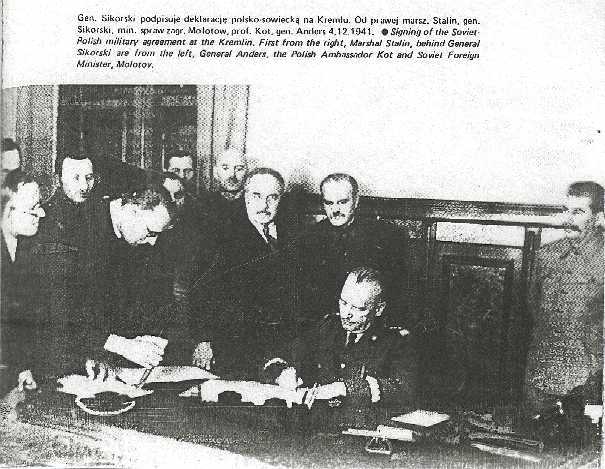
[The English lang. caption to this
picture is incorrect. Sikorski is signing the Polish-Soviet Declaration of
Friendship and Cooperation, 4 Dec. 1941, not the military agreement signed in
August. The Polish Ambassador, Stanislaw Kot is on Sikorski's right, with
Molotov on Kot's left. General Anders is standing behind Kot.].
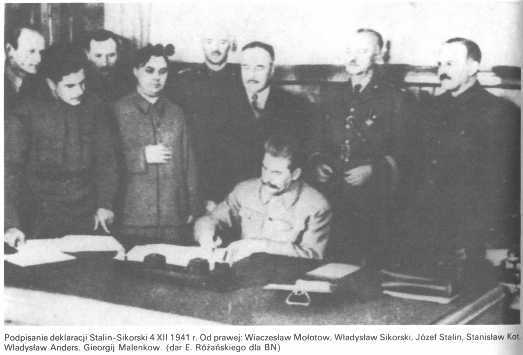
[Stalin
signing the Polish-Soviet Declaration on Friendship and Cooperation. 4 Dec.
1941. Malenkov is on Stalin's right, with his right hand on his tunic. General
Anders stands between Malenkov and Polish Ambassador Stanislaw Kot, with
General Sikorski, followed by Molotov, on Sikorski's left].
On December 4, Stalin and Sikorski
signed the Polish-Soviet Declaration of Friendship and Cooperation. Just before that ceremony, Stalin hosted a banquet for
Sikorski in the Kremlin. When Stalin sounded Sikorski on the possibility of a
Polish-Soviet agreement on the frontier, to be concluded before
the Peace Conference at war's end, Sikorski said the [1921-39 Polish-Soviet]
frontier must not be questioned, but asked to return to the subject at another
time. Stalin agreed.* However, as it turned out, Sikorski did not return to
Moscow, even though privately he seemed reconciled to the idea that Poland
would have to cede most of her former eastern territories to the USSR after the
war. He foresaw this, however, in the context of an East Central European
Federation.**
*[For an English translation of the
Polish record of the banquet conversation, see: Documents on Polish-Soviet
Relations, 1939-1945, vol. I. doc.no. 160 and W.Anders, An Army in Exile;
no Russian record has appeared thus far.]
** On Sikorskiís views regarding the cession of Polish eastern territories,
see: Cienciala, "General Sikorski and the Conclusion of the Polish-Soviet
Agreement of July 30, 1941," cited above].
We should note that while Stalin was
signing the Declaration with Sikorski, a group of hand-picked Polish Communists
was ready to go to German-occupied Poland.
They were second-string prewar Communists who had survived Stalin's purges of
the 1930s because they were then in Polish jails and were trained in the
Comintern School in 1940-41. In the early fall of 1941, they drew up a
political manifesto for the "Polish Workersí Party" [Polska Partia
Robotnicza - PPR]- a name suggested by Georgii M.Dimitrov, the
Secretary General of the Comintern, who had either gotten it from Stalin or had
his approval for it.
Dimitrov supervised the drawing up of the PPR manifesto. This included
many old Polish Socialist demands and was designed to split the underground
Polish Socialist Party and draw part of it into the Polska Partia
Robotnicza, PPR, Polish Workers' Party, partly made up of members of the
Polish Communist Party dissolved by Stalin in 1938. [The leaders who were in
Moscow, had been executed in the the Stalin purgesof 1935-36, or the Stalin
Terror, 1937-38.] The first attempt to fly the Moscow group to Poland failed
when their plane crash-landed on trying to take off from Vyazma in September.
(Jan Turlejski jumped out of the plane as it landed, and was killed.) They flew
off again and parachuted from a Soviet plane in the vicinity of Warsaw on Dec.
27, 1941.The first leader was Marceli Nowotko, followed by Pawel Finder.
His successor,from 1943 to 1948, was Wladyslaw Gomulka, [b. 1905]* who
was not a member of the Moscow group.
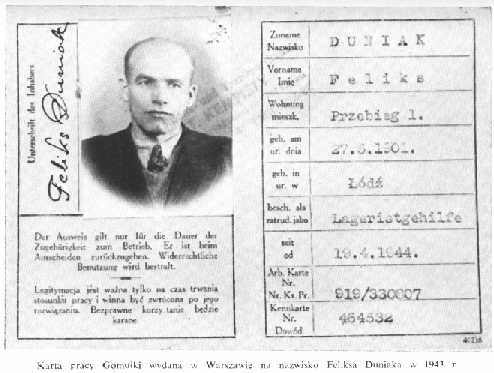
Gomulka's
German- language fake identity card in the name of Feliks Duniak, 1943.
*[ For a history of Polish
Communists see: Jan B. de Weydenthal, The Communists of Poland. An
Historical Outline, Stanford, CA., revised ed., 1987, also: Cienciala,
"The Activities of Polish Communists," cited earlier].
Stalinís thinking about Poland, as
well as on postwar Europe, can be gauged from his talks with British Foreign
Secretary Anthony Eden in Moscow between December 16 and 22,
1941. Eden had come to Russia on an English warship by the
northern route, with the mission of concluding, or at least preparing the
way for an Anglo-Soviet alliance.
Stalin told Eden that the Soviet Union must regain the 1941
frontiers in the West (gained with German consent in 1939-40),
and that this was his absolute condition for signing the alliance with
Britain. At the same time, he was ready to make some
"concessions" to the Poles and said the Polish-Soviet frontier should
be negotiated by the two governments. As for compensation, he suggestedthat
Poland get East Prussia and a western frontier on the Oder river, but
did not insist on the latter. As for other countries, he suggested not
only Soviet control over Finland and Romania, but also an agreement that
Eastern Europe be recognized as the Soviet sphere of influence while Western
Europe would be the British sphere.
Eden had no power to agree to Soviet demands and suggestions,
although privately he thought those regarding Poland were
"reasonable." He also thought that Britain should agree to the Soviet
annexation of the Baltic States. He thought the Soviets would come
in there anyway at the end of the war, and believed Soviet Russia would be the
dominant power on the continent after the war. As such, it, would be Britainís
only ally to keep down Germany the future. (It was generally assumed that the
U.S. would retire from Europe as it had done after World War I.)*
*[For a good summary of the English
records of the Eden-Stalin talks, see: Llewellyn Woodward, British Foreign
Policy in the Second World War , 2nd enlarged edition, vol. 2,
London, 1971, pp. 222 ff. On Edenís views, see: John Harvey, ed., The War
Diaries of Oliver Harvey, 1941-1945, London, 1978, pp. 75-77; Harvey was
Edenís Private Secretary and accompanied him to Russia. For the Russian
records, see: Oleg A. Rzheshevsky, ed., War and Diplomacy. The Making of the
Grand Alliance. Documents from Stalinís Archives, Amsterdam, 1996, Part I,
"Stalin Shows his Claws," pp. 1-62.]
During the Stalin-Eden talks, one of
the Russian drafts for the alliance treaty stated that western Ukraine and
western Belorussia should be left to the USSR except for regions with
predominantly Polish populations. Thus Belostok (P. Bialystok) and Vilna
(P.Wilno, Lith. Vilnius) should be left in the USSR and Lvov (P. Lwow, Ukr.
Líviv) go to Poland, or vice versa, Vilna and Belostok to Poland and Lvov to
the USSR., see Rzheshevsky., doc. 5, point
10, p. 23].
Churchill at first disagreed with Edenís proposal that Britain agree
to Stalinís territorial demands. He felt this would be a violation of the Atlantic
Charter, which he had worked out and signed with FDR in August 1941.
Indeed, the official U.S. stance was in agreement with the Charterís
prescriptions that there should be no territorial changes during the war, and
that none should take place after it without consulting the wishes of the
population involved.*
*[See: Robert Dallek, Franklin D.
Roosevelt and American Foreign Policy, 1932-1945, New York, 1979, pp.
281-285. On the making of the Atlantic Charter, see: Theodore A. Wilson, The
First Summit: Roosevelt and Churchill in Placentia Bay, 1941, revised ed.,
Boston, 1991].
However, in early 1942, the British
suffered serious defeats: the fall of Singapore to the Japanese and defeats in
N. Africa. Also, two major German warships, the "Scharnhorst" and
"Gneisenau," plus a cruiser, "Prinz Eugen" eluded the
British navy in breaking out of the French harbor of Brest and sailing on a
foggy day through English Channel to German ports. Therefore, Churchill pressed
FDR to agree to an Anglo-Soviet alliance treaty which would recognize Soviet demands.
FDR privately believed that Soviet territorial demands were justified,
and that Soviet cooperation was absolutely necessary for winning the war
against Germany, then Japan, and for keeping peace after the war. But
at the same time, he could not agree publicly to Soviet demands for fear of
losing 6-7 million Polish-American votes as well as those of Baltic-Americans
in the next elections. Finally, he feared that such recognition would
outrage American opinion and thus strengthen opposition to U.S. involvement in
the United Nations. Still, in April 1942, FDR agreed not to oppose an
Anglo-Soviet treaty including Soviet frontiers, provided there was a
clause allowing people to emigrate with their belongings if they did not want
to live under Soviet rule.*
*[For Rooseveltís views at this
time, see: Cienciala, "The United States and Poland in World War II,"
The Polish Review, 2009, no. 4. For documents see: Undersecretary of
State Sumner Welles to British Ambassador Lord Halifax, April 1, 1942, Foreign
Relations of the United States, 1942, vol. III, pp. 538-39; for a
memoir, see Navigating the Rapids., 1918-1971. From the Papers of Adolf A.
Berle, edited by Beatrice Bishop Berle and Travis Beal Jacobs, New York,
1973, p.401].
However, Churchill knew that
there would be great opposition in Parliament to the abandonment of the Baltic
States to the USSR and that some vocal Members of Parliament would
oppose agrement to a new Polish-Soviet frontier at Poland's expense. So when Molotov
arrived in England on a secret visit in May 1942 to negotiate the alliance, the
British did their best to eliminate the frontier question from the text of the
alliance and suggested an exchange of letters on this matter. Molotov,
however, insisted on British recognition of the western Soviet frontier as it
was in June 1941- until he suddenly accepted the British proposal of a simple
20-year military alliance, which was signed on May 26, 1942.
There was speculation for many years on what induced Stalin to change his mind.
The most likely explanation seemed to be that the U.S. Ambassador in London, John
Gilbert Winant, had given Molotov a strong message from FDR. Indeed, he
had, but Russian documents published in Eng. translation in 1996 show that Stalin
directed Molotov to give up Soviet demands just before the Winant-Molotov
conversation took place. It is likely that Stalin learned of FDRís
reservations through another channel, perhaps through the president's
close adviser Harry Hopkins who was secretly in touch with some members
of the Soviet Embassy in Washington, who were also intelligence agents.
Whatever the case might be, Stalin cabled Molotov on 24 May that the
absence of Soviet frontiers from the draft treaty proposed by Eden " is
not bad perhaps, for it gives us a free hand. The question of frontiers, or to
be more exact, of guarantees for the security of our frontiers at one or
another section of our country, will be decided by force."*
*[For Ambassador Winantís report of
his conversation with Molotov, May 24, 1942, see: Foreign Relations of the
United States, 1942, vol. III, pp. 558-64; for Stalinís telegram to Molotov
of the same day, received before the Molotov-Winant conversation, see:
Rzheshevsky, War and Diplomacy, doc. no. 38; for Molotovís account
of his conversation with Winant, see ibid., doc.no. 47].
The Polish Army in the USSR,
1941-1942.
The army grew rapidly although many
surviving prisoners of war could not reach the recruiting centers, either
because their labor was considered necessary where they were, or because they
died of exhaustion and illness on the way, or after arriving in Uzbekistan.
Furthermore, the food supplies given to the P. army by the Soviet military
authorities were inadequate and there was constant friction. The Soviets
pressed for sending a Polish division to the front as soon as it was ready,
while Sikorski and Anders stood for sending the Army as a whole, when ready -
which Anders estimated would be in June 1942. Some of the food shortages were
no doubt due to the needs of the Red Army, but food also seems to have been a
means of pressure on the Polish government to agree to Soviet frontier demands.
There were also conflicts over who
was a Polish citizen. Thus, the Soviets insisted that only ethnic Poles should
be released to join the army, but not Ukrainians, Belorussians, and Jews, who
were Polish citizens before the war, but like all others living in former
eastern Poland, became Soviet citizens in November 1939. The Soviet government
made an exception only for ethnic Poles.
Even so, due to the efforts of the
Polish embassy in the USSR, some Jewish Poles managed to join the army, e.g.
Menahem Begin, the future leader of Israel.
In July 1942, the Soviets arrested
most of the Poles who had been sent out as "delegates" by the Polish
embassy all over the Soviet Union to locate Polish citizens, have food and
clothes sent to them, and send recruits to the Polish army. They were accused
of espionage (a few were intelligence officers), but most were released after
Anglo-American interventions. Those who did not have diplomatic immunity were
not released and disappeared without trace.
The conditions for the troops and
the civilians, who flocked with them to Polish army centers, were very bad.
Malnutrition, followed by malaria and typhoid fever decimated their ranks.
Finally, when Soviet supplies continued to be inadequate and conditions did not
improve, General Anders decided to evacuate all the military and civilians
under his command to Iran (then known as Persia) in order to save lives. Sikorski
had wanted some to stay, but finally agreed to the move, while reserving the
right to continue recruitment in the USSR.
Evacuation was made easier by
the fact that Churchill wanted Polish troops to strengthen the British
forces in the Middle East. Thus, about 70,000 troops plus civilians, a total of
about 112,000, were evacuated in two stages to Iran: in April and September
1942. Most went by ship across the Caspian Sea, while others travelled over the
mountains . Many died of exhaustion and disease either on the way, or afte
reaching Iran.*
*[see K. Sword, Deportation and
Exile, ch.3; see also the English version of Anders' memoirs: Wladyslaw
Anders, An Army in Exile.]
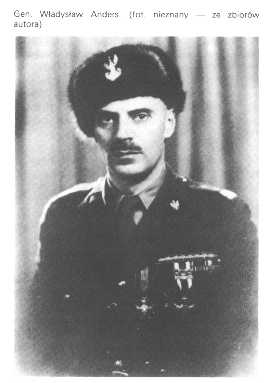
General Wladyslaw Anders in the USSR, 1941-42.
Katyn, and the Breakdown of
Polish-Soviet Relations, April 1943.
Polish-Soviet diplomatic relations
worsened in late 1942 and early 1943. There were constant notes from the Polish
government to the Soviet government protesting the Soviet practice of naming
towns in former eastern Poland "Soviet" towns. The Poles insisted on
the inviolability of their eastern frontier of 1939, while the Soviets accused
the Polish government of wanting to annex Soviet territory. The Polish
government, for its part, had plans for a federation in East Central Europe,
which would include Lithuania -- made a Soviet Republic in 1940.
At the turn of January and February
1943, just as the Soviets were about to accept the surrender of the German 6th
Army in Stalingrad by German Field Marshal Friedrich W.E. Paulus
(1890-1957 - Hitler made him a marshal because no German marshal had ever
surrendered), Stalin called Wanda Wasilewska and her husband, the
Ukrainian writer Oleksandr Korneichuk, back to Moscow from their
journalistic trip to cover the German surrender. According to Wasilewska's
memoirs, Stalin said that a new Polish center must be organized in the USSR
(which she had been proposing for some time) because he expected a breakdown
of Polish-Soviet relations. The new center was to be called "The Union
of Polish Pariots." They also agreed on a flagship newspaper called
"Free Poland" and that the first number should appear on March 1.
Both names were suggested by Stalin.
It was perhaps no
coincidence that a week earlier the leaders of the Polish Workersí Party (PPR)
in German-occupied Warsaw had proposed the establishment of a "united
front" with the Polish Armia Krajowa (A.K. or Home Army), also
negotiations on a new Polish government for postwar Poland. They also proposed
that this government, which might include Sikorski, conclude an alliance
with the Soviet Union. Finally, they wanted to have their representatives in
the A.K.General Staff. The underground leadership rejected these proposals.
On April 13, 1943, the German radio officially
announced the discovery of mass graves of Polish officers in Katyn Forest
near Smolensk. At first, the Germans claimed that about 10,000 bodies
were buried there (the Polish government's estimated number of missing Polish
officers without the police and gendarmes), but then revised the estimate
to a little over 4,000 (the verified Polish number of Katyn victims is 4,410).
They claimed that the officers had been murdered by the Soviets in 1940.
The Polish government, which had
been asking Soviet authorities for the whereabouts of the missing men since the
fall of 1941, had to take action. It was under great pressure to do so because
most of the soldiers in the Anders Army, then in the Middle East, came from
former eastern Poland and had lost relatives and comrades in the USSR, as had
many families in German-occupied Poland. Therefore, the Polish government asked
the International Red Cross ((IRC) to undertake an investigation. It so
happened that the German government made the same request at almost the same
time.
The Soviet government -- whose press
had already charged the Germans with the crime -- declared the German charge
was a lie and said that the Polish government should have asked them first. (As
if it had not been asking about the missing officers in 1941-43). According to
British Foreign Secretary Antony Eden's statement to Sikorski on 24 April,
Stalin's conditions for not breaking off relations were that the P. government
retract their request to the IRC for an investigation and declare that the
Germans had murdered the Polish officers at Katyn. Sikorski told Eden he would
not insist on the IRC investigation (which fell through anyway for lack of
Soviet consent), but he could not blame the Germans because he had convincing
information on Soviet guilt. *
*[ On the exhumations at Katyn, the
fate of the personal items found on the bodies, and all other matters connected
with Katyn, see: Pt.II, Extermination, Cienciala, Lebedeva, Materski eds.,Katyn.
A Crime Without Punishment,Yale University Press, New Haven, Conn., 2007;
reprint 2009.]
Despite Allied appeals, Stalin broke
off relations with the Polish government on April 25, accusing it of
collaboration with the Germans.
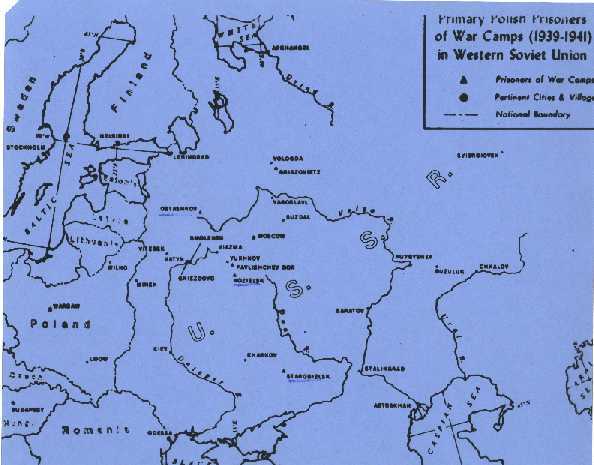
The
three Special Camps holding Polish POWS in the USSR.
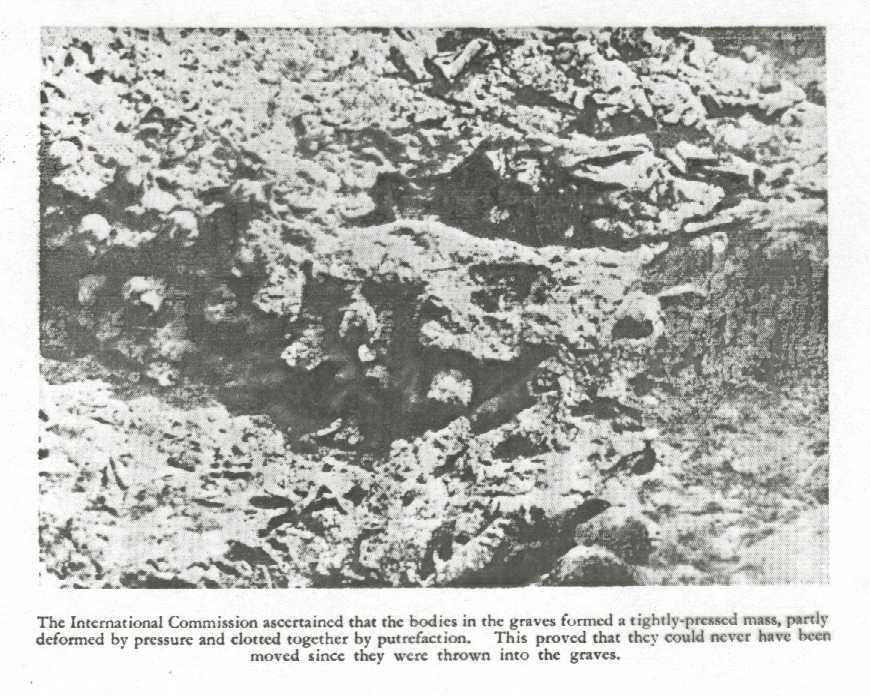
[The bodies in this particular grave
were arranged in rows, on top of each other, as can be seen from the
enlargement below. These prisoners must have been shot somewhere else, either in
the NKVD prison in Smolensk or somewhere in the Katyn area, and then laid out
in rows (not thrown as in the caption above) in the burial pit. In another pit,
the bodies lie pell mell as if thrown in at random. They were most likely shot
at the edge of the pit, AMC].

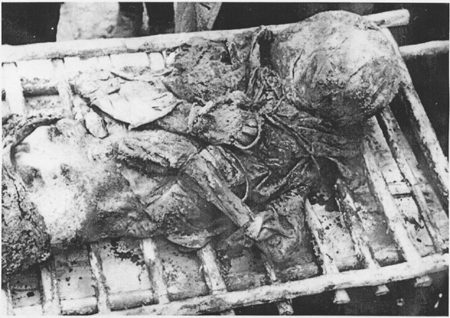
This
photo shows a victim whose hands were bound.

Photograph
of exhumed bodies laid out for examination.
[Photographs
above from the German publication on Katyn, 1943]

A
collage of prewar photographs of unidentified officers held in Starobelsk camp,
murdered in the NKVD prison in Kharkiv (Russ. Kharkov), Ukraine. A little over
55% of all the officers were reserve officers, with professional careers in
civilian life.
[Photographs
courtesy of the Katyn Museum, Warsaw].
Since the IRC could not conduct an
investigation without Soviet consent, the Germans organized their own. They also brought in forensic medicine experts from
pro-German countries and one neutral country (Switzerland) in an
"International Medical Commission." Furthermore,they brought in some
British, Polish, and U.S. officers from POW camps in Germany, as well as
journalists from occupied and neutral countries. They also allowed visits by
selected Poles and permitted the Polish Red Cross in occupied Poland to send a
small delegation followed by a technical commission, whose members supervised
and sometimes worked on exhuming bodies, listing the items found on each of
them..
The examination of the exhumed corpses at Katyn showed that the vast
majority were officers from Kozelsk camp, a few miltes from Smolensk. They had
been shot in the back of the head, at the base of the skull, with the bullet
exiting in the forehead or face. Most had their arms unbound on their sides,
but about 20% had their hands bound; some had sacks or coats thrown over their
heads and a rope around their necks joined to their bound hands, so if they
pulled it they would choke. These men must have tried to resist; if so, they
were probably in the first group brought to the edge of the burial pit. The
rest of the prisoners, whose hands were un tied, were probably killed somewhere
nearby, after which their bodies were arranged in rows in the pits. No witness accounts of the Katyn executions have
appeared so far (Feb. 17, 2012).
Many bodies had on them papers and
letters, also Russian newspapers from the spring of 1940. Most wore winter
clothes (executions began in early April and the spring of 1940 was cold in
this part of Russia), while the trees growing on the mass graves had been
transplanted there at the time. The bullets and casings were German, fitting
German "Walther" pistols; both had been exported from Germany to the
USSR in the 1920s and early 1930s. Those whose remains were identified were
known to have corresponded with their families in Poland between late
November-early December 1939 and mid-March 1940, while some correspondence was
sent out of the Starobelsk camp (Ukraine) as late as April. The
letter-postcards were dated and gave the return address. Finally, in spring
1940, the territory was under Soviet rule. Thus, it was clear that the massacre
had been carried out by the Soviets.
It is worth noting that the Germans
sent 9-10 wooden chests containing envelopes with documents and personal items
found and tagged -- except for the first batch done by the Germans -- by the
Polish Red Cross personnel at Katyn, to the Polish Institute of Forensic
Medicine attached to the Jagiellonian University, Krakow. Here, they were
studied and catalogued by the Polish workers of the institute led by the
forensic medicine specialist, Dr. Jan Zygmunt Robel, under the supervision of a
German officer, Dr. Werner Beck. There were about 3,000 envelopes, but the
Poles only had time to open, clean, and write up the contents of 285 of them
before the Germans evacuated the wooden chests further West. Still, from items
found in 285 envelopes taken from the bodies, the Polish workers in Krakow
managed to identify just over half of the 4,423 corpses exhumed at Katyn.
(There are now 4.410 verified names).
They also secretly typed several
copies of 22 legible diaries, 15 of which reached the Polish government in
London. They hid other copies --which were found during repair work done on the
building in March 1991. Some envelopes were hidden in another place in Krakow,
discovered by the Polish Security Police -- and preserved by them until Gen.
Kiszczak returned them to the Archbishop of Krakow in 1989. *
The chests with personal belongings
found on the bodies, also various records, were evacuated to the West by the
Germans, ahead of the Russians. The German officer in charge of them, Dr.
Werner Beck, had instructions to destroy them rather than let them fall into
Russian hands He did his best to get them to the Western Allies, mainly it
seems, for his own benefit. When he reached Dresden, the Red Army was near and
he left instructions for the chests to be burned rather than let them fall into
Soviet hands.This was apparently done by a railway official at the railway
station of Radebeul, a suburb of Dresden,Germany, just before the NKVD got
there.
*[For
the narrative and documents on Katyn, see Katyn. A Crime Without Punishment,
Yale University Press, New Haven, 2007, reprint 2009; see also the study based
on documents and secondary works by George Sanford, Katyn and the Soviet
Massacre of 1940. Truth, Justice and Memory. Routledge, London and New
York, 2005.]
German propaganda aims and Katyn,
1943.
Nazi Propaganda Minister Joseph
Goebbels (1897-1945) certainly hoped that the Katyn revelations would (a)
secure Polish military support from occupied Poland in the war with the USSR,
and (b) cause a rift between the Western Allies and the USSR. The revelations
were also convenient for the Germans, who sent troops into the Warsaw Ghetto on
19 April, a few days after the news of Katyn was broadcast to the world on
(April 13, 1943), but no document has been found linking the two events in
German propaganda policy at the time.
[For The Warsaw Ghetto Uprising,
see above.]
However, Poles did not volunteer for
the German Army and the rift Goebels hoped for between the Western powers and
the USSR over Katyn did not occur. The Red Army was very popular in the West,
where the media described and praised its courageous fight against the Germans
and its great victory at Stalingrad (early February 1943). Therefore, Western
public opinion tended to believe the Soviet claim that the Germans had killed
the Polish officers at Katyn. This belief was aided by the fact that both the
British and the American governments quashed discussion of the Katyn massacre
in their media. Polish survivors of NKVD camps who had come out with the Anders
Army into Iran - later Iraq and Italy - were not allowed to speak publicly or
publish anything. Therefore, after a few short news mentions in mid-April 1943,
no more information appeared on Katyn in the West until after the war.
Meanwhile, the Russians conducted
their own exhumations and investigation at Katyn in January 1944. They declared the mass murder had been committed by the
Germans in summer 1941, changing this later to September-December 1941 because
many victims wore winter clothes due to a cold spring in 1940. It is now known
that the "evidence" of German guilt for Katyn cited in the report of
the Soviet special commission, headed by Soviet academician Dr. Nikolai
Burdenko - known as the "Burdenko Commission" for short - was
provided by the NKVD. Russian documents accessible during Gorbachev's
"Glasnost" era [1987-91] and under Yeltsin [1991-2000] show that a
special NKVD group worked on the graves in the period September 1942-Jan. 1944;
it selected some corpses for exhumation and put various postdated papers on
them to show the Poles had been murdered in summer-fall 1941, which would put
the blame on the Germans. In fact, archival Russian documents made
accessible to Russian historians in 1988-89 show that the whole Burdenko
investigation at Katyn had been stage managed by a special NKVD team (see
Cienciala et al., eds., Katyn, and Sanford, Katyn).
Successive Soviet governments
continued to accuse the Germans of the Katyn crime, until President Mikhail
S. Gorbachev's Politburo decided in spring 1990 to admit that the missing
Polish officers had been murdered by the NKVD. By this time, Russian historian
Natalia S. Lebedeva and others had found the NKVD convoy troop lists and then
the records of the NKVD "Administration for Prisoners of War and
Internees," and were about to publish articles on the subject. The new
Polish government, formed (after Soliarity's June 4 electoral victory) in
September 1989, headed by General Wojciech Jaruzelski (President
1989-90) was also pushing for a Soviet admission of guilt. This was because
Polish public opinion was doing so; Jaruzelski hoped that such an admission
would improve Polish-Soviet relations and make the government more popular at
home.
In view of all the above, Soviet
President Mikhail S. Gorbachev handed over NKVD lists of names of Polish
prisoners of war sent to their deaths from the three special NKVD camps in
spring 1940, to Polish President Jaruzelski on April 13, 1990, at the Polish
Embassy, Moscow. On the same day, the Soviet news agency TASS issued a
communique stating that Lavrenty P. Beria, (head of the NKVD) and his deputy
V.N. Merkulov were responsible for the massacre at Katyn. (They had been
executed in 1953 and there was no mention of Stalin!) In the communique published in Pravda, the Russian
government expressed its great regret at this" heinous Stalin crime."
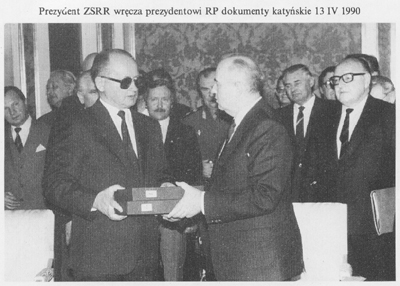
[Photograph from Jarema Maciszewski,
Wydrzec Prawde (Tear out the Truth, Warsaw, 1991, see also New York
Times, 14 April 1990. J. Maciszewski, who had lost two relatives at Katyn,
was the head of the Polish half of the mixed Polish-Soviet Historical
Commission to remove "blank spots" from the history writing on
relations between the USSR and Poland. In this photo, he is standing in the
back row, second from left. Just off Jaruzelski's left shoulder is Janusz
Onyszkiewicz (with moustache), a Solidarity leader and member of the new Polish
government. The head of the Russian half of the mixed historical commission,
Prof. Smirnov is first from right, behind President Gorbachev. Jaruzelski often
wore dark glasses because of a chronic eye inflammation acquired, as he told
Anna M. Cienciala in 1994, from reading books by candlelight after his release
from a labor camp and before going for military training to join the new Polish
Army in the USSR. He had been deported to the USSR from eastern Poland together
with his family in 1940; his father died shortly after release from a labor
camp, but Jaruzelski, his mother and sister, survived. He was released too late
to join the Anders Army, so he joined the new, communist-led Polish Kosciuszko
Division, later the First Polish Army, in which he fought the Germans all the
way to Berlin. He became a communist and rose in army ranks; crushed Solidarity
in Dec. 1981; held power as party leader to 1989; and was President of Poland
in 1989-90.]
However, it was not until 14 October
1992, that on orders from Russian President Boris N. Yeltsin, the chief
Russian archivist, Rudolf Pikhoia handed over the key documents -- held
in the Russian Presidential Archive --to Polish President Lech Walesa
(b. 1943, former Solidarityleader, President 1990-95). The main reason for this
revelation - which was made at the same time in the Russian press -was
Yeltsin's ban of the Russian Communist Party, which was opposing his policies.
The party appealed against the ban to the Russian Constitutinal Tribunal and
Yeltsin revealed the Katyn documents as part of the evidence of the Russian
Communist Party's criminal past.
(It is worth noting that this and other incriminating documents were
published in several Russian newspapers on Oct. 14, 1992. (The same documents
were put on the official Russian website on April 28, 2010, on which more will
be said later.)
The most important document revealed
at this time was the March 5 1940 approval by the Politburo of the
proposal made by NKVD chief, Lavrenty P. Beria (1899-1953), that the
14,746 Polish prisoners of war in the three camps of Starobelsk, Kozelsk, and
Ostashkov, as well as the 11,000 held in NKVD prisons in Western Ukraine and
Western Belorussia -- the majority of whom were Poles, incl. about 1,000
officers -- should be shot without trial. The justification given
by Beria was that "all of them are hardened enemies of the Soviet power
with little expectation of their reform." The first of the
signatures across the first page of the Russian text was by J.V. Stalin. [New
York Times, October 15, 1992.]
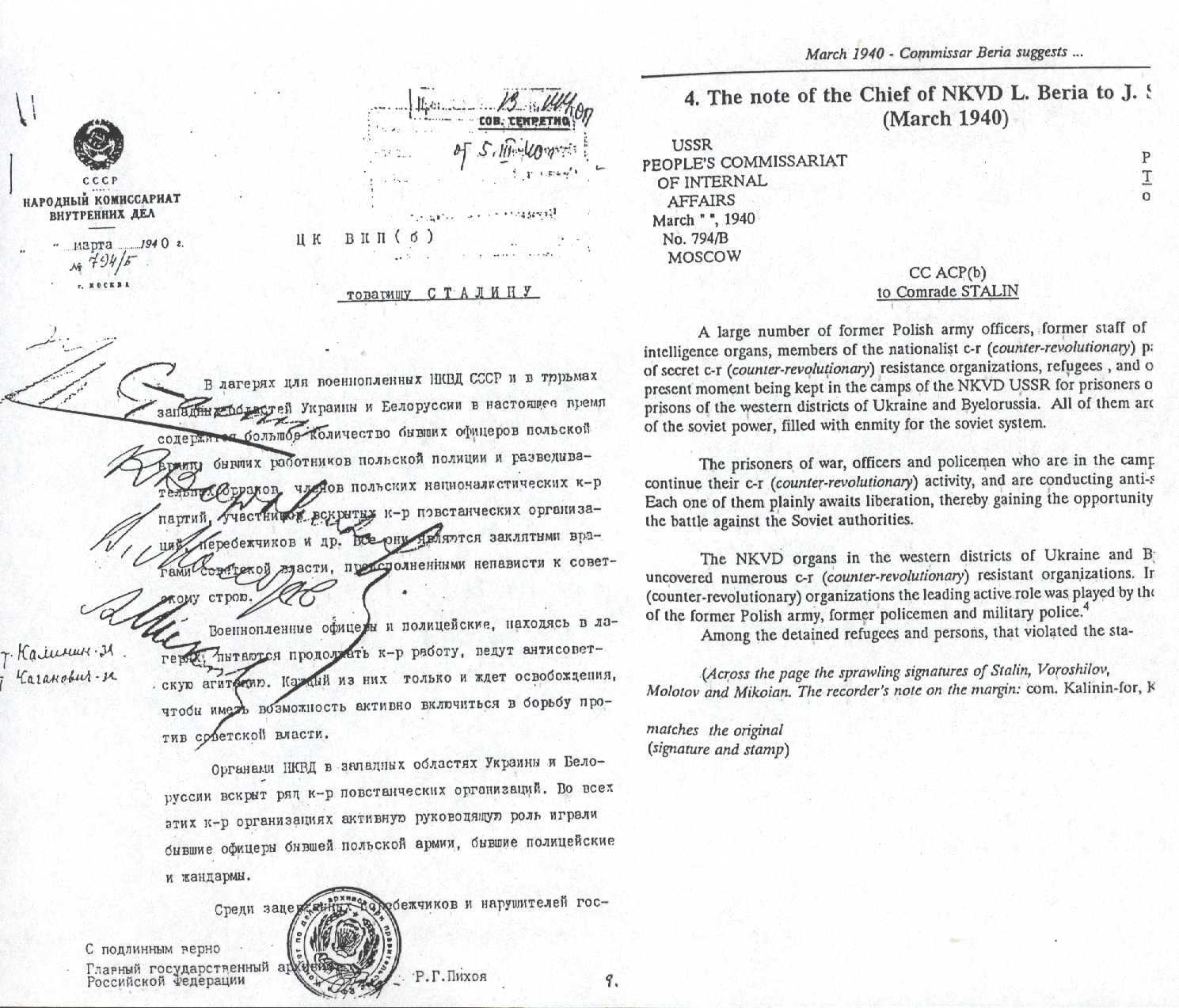
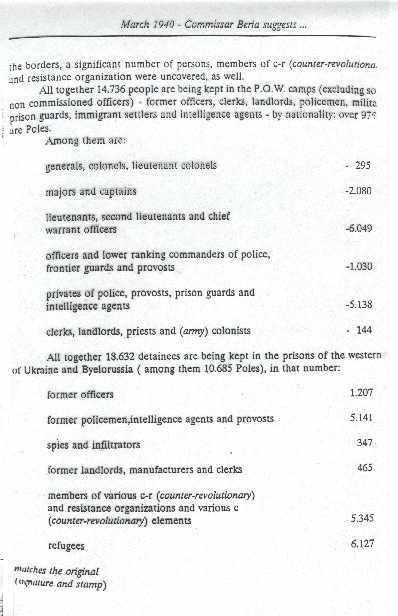
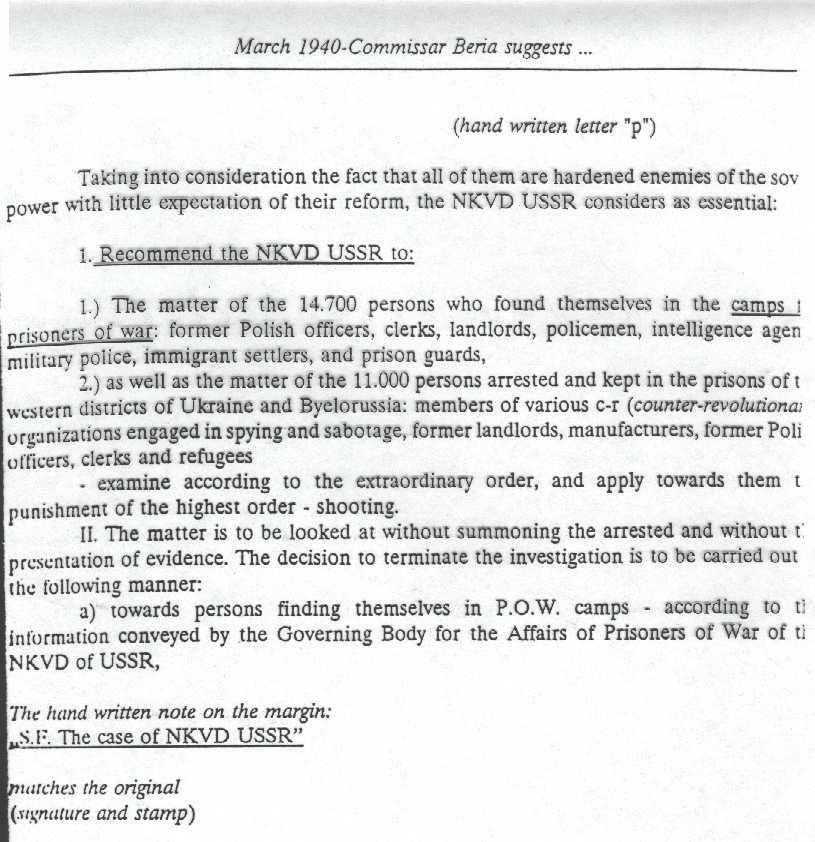
[
From Wojciech
Materski, ed., with foreword by Janusz K. Zawodny, Katyn. Documents of Genocide,
Warsaw, 1993; the original document is given on the left with the English
translation on the right; see also Cienciala et al., eds., Katyn, doc.
no. 47].
In fact, according to a Russian
document dated 3 March 1959, a total of 21,857 Poles were executed in spring
1940. This figure included both the prisoners from the three special NKVD camps
and some 7,300 prisoners who had been held in NKVD jails in western Belorussia
and western Ukraine.* This figure is generally accepted by Polish historians
although it is known that many Poles taken prisoner in Sept. 1939 are still
unaccounted for.
*[Bibliographical Note. For
the English translations of these and other Russian documents, see: Cienciala,
Lebedeva and Materski, Katyn. A Crime Without Punishment.
Yale University Press, New Haven, Conn., 2007, reprint 2009.This volume also
contains some of the 1943 German photographs of Katyn, as well as German aerial
photographs and maps found in the National Archives by Waclaw
Godziemba-Maliszewski, who is the leading expert on aerial photography of the
Katyn, Starobelsk and Mednoe burial sites, and wrote the legends for the above
book. See his bilingual Polish-English work: Katyn: An Interpretation of
Aerial Photographs Considered with Facts and Documents, Fotointerpretacja
w Geografii. 25.Problemy Telegeoinformacji, Warsaw, 1995.]
The directors of the Polish and
Russian state archives agreed in 1992 to edit and publish documents on Polish
prisoners of war and their fate in parallel Polish and Russian volumes. Polish
volumes 1, 2, 3, appeared in Warsaw in 1995-2001; the 4th and last volume was
published in 2006 but released in April 2007 on the 54th anniversary of the
first German announcement on Katyn. The first Russian volume came out in Moscow
in 1997, covering the 1939-40 period in one volume, and the second volume
covering the period March 5 1940 - 2000, appeared in December 2001; both were,
like the Polish volumes, edited jointly by Russian historian Natalia S.
Lebedeva and Polish historian W. Materski, chief editor of the Polish volumes.
It should be noted that over forty years ago, Janusz Zawodny published the
first English-languge scholarly study of Katyn, based on available documents
and interviews: Death in the Forest, (Notre Dame, IN., 1962, and
reprints). It is still the best English-language introduction to the subject].
------------------------------------------------------------------------------------------------------------------------------------------------------------------------
3. The Polish Question in
Western-Soviet Relations from late April through the end of 1943.
(A) The Death of General Sikorski.
General Sikorski, his daughter, and other members of his suite (including
three Britons and a courier from Poland who had left the country in February),
died in a plane crash off Gibraltar on July 4, 1943. They were on their
way back to Britain after Sikorski's visit with the Polish Army in the Middle
East. Only the Czech pilot survived; he had been able to exit his cabin in the
nose of the plane in his "Mae West" (life jacket named after the
physically well endowed 1930s American film star, Mae West). The British
inquiry commission concluded, on the basis of plane parts recovered from the
sea, that there had been no sabotage - although it could not specify the cause
of the crash.
There has been much speculation on
whether the accident was due to metal fatigue, accidental gear blockage,
overloading, or sabotage. The Czech pilot of the Liberator plane, who had flown
Sikorski in that plane before, stated that when he reached 150 feet, he could
not make the gear stick move to gain height. The crash might have been caused
by some mechanical failure, but there has been speculation that someone had put
sugar or sand into the gears, which would be invisible after the plane crashed.
Indeed it seems the plane was poorly guarded the night before, and it took off
somewhat later than planned - otherwise it would have disappeared at sea.
Suspicions of Soviet sabotage arose
later on the assumptionthat Soviet mole Kim Philby, head of M I-5
(British intelligence), was at Gibraltar at this time, but he was not. However,
Ambassador Ivan M. Maisky, the Soviet ambassador in London,stopped there
on the way to Moscow with his suite. He did not meet with Sikorski due to the
efforts of the British governor of Gibraltar, General Mason McFarlane. *
*[For a detailed study of the crash
based on evidence available at the time, see David Irving, Accident. The
Death of General Sikorski, London, 1967. A computerized study madeby Polish
experts in the early 1990s led them to conclude that the crash was not an
accident, but no direct evidence of sabotage has surfaced thus far].
If anyone had a real interest in
killing Sikorski, it was the Soviet government. Indeed, the Polish communist
press in the USSR and in German-occupied Poland had been attacking him for
being anti-Soviet. In particular, the Union of Polish Patriots in the USSR,
a group of Polish communists and left-wingers led by Wanda Wasilewska,
established with Stalin's blessing in spring 1943, had launched an attack on
him on June 6, 1943 for betraying the Polish-Soviet Friendship Treaty of
December 1941.
However, after his death, they praised him for re-establishing Polish-Soviet
relations in July 1941 and for being open to the Soviet point of view on changing
the Polish-Soviet frontier. Thus, the death of Sikorski allowed the Polish
communists to praise him in order to secure support for their underground
"Polish Workers' Party" in German-occupied Poland.
Deputy Premier Stanislaw
Mikolajczyk (1901-1966) succeeded Sikorski as Premier of the Polish
Government in Exile, while General Kazimierz Sosnkowski (1885-1969), who
had a very fine military record, became Commander-in-Chief of the Polish armed
forces. Mikolajczyk, was the exiled leader of the Polish Peasant Party,
the largest in Poland. Like Sikorski, he was willing to negotiate a
compromise with the Soviet government on the Polish-Soviet frontier, but like
Sikorski, only after the war ended. Both realized that Polish opinion at home
and abroad would turn against any Polish government that gave up eastern Poland
- one half of the prewar state - during the war without consulting the nation,
or at least securing Western guarantees of territorial compensation and postwar
independence.
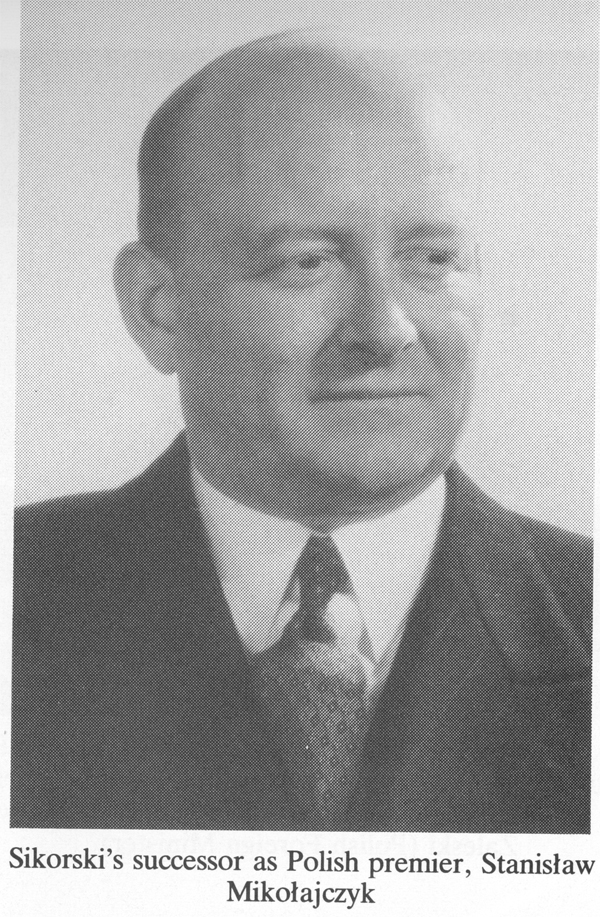
(B)Discussion
of Polish Frontiers at the Big Three Conference in Tehran, November 28 -
December 3, 1943.
As a background to this conference,
we should note the Allied decisions made before it
took place. Thus, at the First Quebec Conference of August 1943, Churchill
and FDR decided that everything must be done to secure Russian
friendship. Churchillís key concern was to prevent any separate
German-Soviet peace on the lines of the peace between Bolshevik Russia and the
Central Powers at Brest-Litovsk, March 1918, while FDR wanted above all to
secure Soviet aid to defeat Japan after the victory over Germany.
The Allied Chiefs of Staff were not willing to go as far as Major General
James Burns, head of FDRís Soviet Protocol Committee, who
stressed the need for Russiaís aid to defeat Japan and had no objections to
Russia becoming the predominant power in postwar Europe. However,
they did recommend that the western powers concentrate their military action in
Western Europe while viewing Eastern Europe as the Soviet war
theater. They proposed that the western powers, once their troops
landed in W.Europe, bargain with the Soviets for a compromise peace settlemeent
and for U.S. participation in the occupation of Germany. By the same
token, they indicated no interest in contesting Soviet supremacy in E.Europe.*
*[See: Mark A. Stoler, Allies
and Adversaries: The Joint Chiefs of Staff, the Grand Alliance. and U.S.
Strategy in World War II, Chapel Hill, 2002].
Secondly, at the Foreign
Ministersí Conference held in Moscow in October 1943, U.S. Secretary
of State, Cordell Hull, did not support the proposals of British Foreign
Secretary, Anthony Eden, for creating East European federations, which
Churchill hoped would allow the regional states to resist Soviet domination.
Furthermore, the Russians were told that they would get an occupation
zone in East Germany. No wonder Stalin was pleased. He shook
hands with Cordell Hull (1871-1955) and smiled. Cordell Hull wrote in
his memoirs: "I thought to myself that an American having Stalinís
personality and approach might well reach high office in my own country."
* It would be interesting to know what Stalin thought of Cordell Hull.
*[See: The Memoirs of Cordell
Hull. vol. II, London, New York, 1948, p. 1311.]
At the Big Three Conference in
Tehran, November 28 - December 2, 1943, Churchill was very anxious
to solve the Soviet-Polish impasse, which was dangerous for Allied unity. Therefore,
he proposed to Stalin that Poland be moved West "like a soldier taking
three steps left close." It would be compensated with German territory.
No wonder Stalin liked the idea - after all, he had proposed it to
Eden in December 1941. Churchill said he would propose it to the Polish
government.
Roosevelt told Stalin that although he agreed with Churchill on
Polish boundaries, he could not participate in such decisions or take a public
part in them before the end of 1944, that is, before the presidential
elections. According to the American record, "There were, he told
Stalin, some 6 or 7 million Americans of Polish extraction and Ďas a practical
man, he did not wish to lose their vote.í" Stalin
said he understood. The President also said he did not intend to go to war with
the Soviet Union over Poland or other territories [Baltic States], but thought
American opinon would favor a referendum sometime after Russian liberation. He
believed the peoples of these territories would wish to join the Soviet Union
anyway (!). To this Stalin replied that he understood the Presidentís position
but if there was a referendum, he would not agree to any international control.
The decisions on Eastern Europe made
by the Big Three at Tehran had far reaching consequences. It was agreed
that former eastern Poland should go to the USSR, while Poland would be
compensated with East Prussia (except for Konigsberg, later Kaliningrad, which
Stalin demanded as a warm-water port for the USSR), and have her western
frontier on the Oder river. The British and American leaders understood
this to mean an enlarged prewar Polish Upper Silesia, but not the territory
stretching thence north to Stettin on the Baltic.
It was also understood that the USSR would get the Baltic States of
Estonia, Latvia and Lithuania (which she held in 1940-41), as well
as Bukovina and Bessarabia (formerly in Romania, though Bessarabia, now
Moldova, had belonged to the Russian Empire), and that the Soviet
occupation zone in Germany would extend to the Elbe river.
The Western powers committed themselves to land their armies in France in May
1944, and Stalin promised to help by launching an offensive at this time on the
eastern front.
He also confirmed his promise of aid in the war with Japan after Germanyís
defeat on Europe. In return, he demanded that Russia recover her 1905 losses to
Japan, that is, southern Sakhalin and the Kurile Islands.
(Russian possession of these is the main obstacle to a Japanese-Soviet
settlement to this day).
Churchill tried but failed to secure Stalinís consent to an allied
landing in the north-western Balkans, at the head of the Adriatic as the
secondary invasion of Europe after northern France. Stalin opposed this, as did
Roosevelt and American military leaders, who wanted the main blow to go from
France to Berlin. (Churchill would try to persuade FDR to agree to his proposal
in 1944, but failed again.)*
*[On the Polish question at the
Tehran conference, see: Jan Karski, The Great Powers & Poland,
1919-1945. From Versailles to Yalta, Lanham, New York, London, 1985,
ch.XXIX. The book gives a good survey of the Polish Question in World War II,
based mainly on published sources available at the time. The authorís negative
account of Polish interwar foreign policy is colored by his political views.
For the U.S. Record, see Papers Relating to the Foreign Relations of the
United States. The Conferences of Cairo and Tehran, 1943, Washington, D.C.,
1961].
4. The Polish Question in 1944.
(A) The Genesis of the first
Postwar Polish Communist Regime.
As mentioned earlier, The Union
of Polish Patriots in the USSR (Zwiazek Patriotow Polskich w ZSSR, abbr.
ZPP) was established under WandaWasilewskaís leadership in the USSR in
spring 1943. It was accompanied by the raising of a new Polish army recruited
from Polish prisoners of war and deportees in the Soviet Union who had not
managed to join the Anders army before it left for Iran in 1942. The embryo of
the Communist-led army was the Kosciuszko Division, formed in summer
1943 and led by General Zygmunt Berling. (He had been promoted
from Lt. Colonel to General by Stalin). It had its baptism of fire at
the Battle of Lenino, in October 1943, when it lost a third of its men
due to inadequate Russian artillery support.
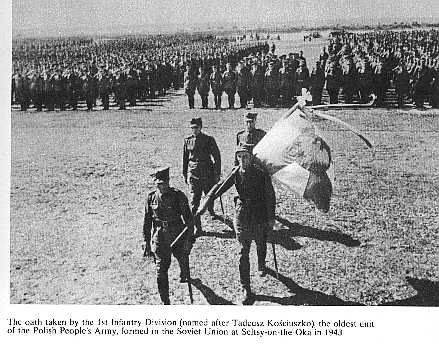

Presidium
of the Congress of the Union of Polish Patriots in the USSR, June 9-10, 1943.
[Pictures
from: Topolski, An Outline History of Poland , Warsaw,1986. Note the
priest, Father Kupsz, Chaplain of the Kosciuszko Division,second from left, and
General Zygmunt Berling, third from left. Wanda Wasilewska is 4th from left, at
the center of the group].
In view of the approach of the Red
Army to the prewar Polish-Soviet frontier, a handful of radical Polish
Socialists and Communists established "The Home National Council"
(Krajowa Rada Narodowa, abbr. KRN) in Warsaw on the night of December 31-st
1943 - January 1st 1944. It was meant to upstage the forthcomiong
establishment of a revamped underground leadership Indeed, the anti-communist
Council of National Defense (Rada Obrony Narodowej) was established in early
January 1944.
The establishment of the KRN was not
coordinated with Moscow, and those who attended its first meeting were led by a
left-wing Polish socialist, Edward Osobka-Morawski (1909-1997). He told
Anna M. Cienciala in June 1980, that he had purposely fixed the meeting in the
evening, so that no one could leave before morning due to the German curfew,
and thus they would have to sign something. The KRN represented only a
tiny fragment of Polish public opinion, but pretended to represent the
majority. It was acknowledged by Moscow after some delay, occasioned by
suspicion of its unauthorized establishment.
(B) British and American
leadersí efforts to establish a new Polish government and the creation of the
Polish National Committee of Liberation (Polski Komitet Wyzwolenia Narodowego,
abbr.PKWN), July 22 1944.
In January 1944, the Red Army
crossed the prewar Polish-Soviet frontier in several places. In February 1944, Churchill
told the House of Commons about the Polish-Soviet frontier discussed with
Stalin at Tehran, and that Poland would be compensated with German territory in
the West. He described this arrangement in glowing terms as very advantageous
for Poland, although the Polish government had rejected it. He continued
exerting great pressure on Premier Stanislaw Mikolajczyk to accept the
frontier.
Mikolajczyk confidentially told the British that he and his government
were willing to enter into negotiations with Moscow based on the Curzon Line
(of July 1920, demanded by Stalin with minor concessions to Poland). However,
the Polish premier said his government could not just go ahead and accept it
during the war because this would lead to mass protest and rejection of its
authority by the majority of Poles. Indeed, he was right. Even the communist
Polish Workersí Party (Polska Partia Robotnicza -PPR) in German-occupied Poland
would not come out publicly in favor of ceding the former Polish eastern
territories to the USSR, for fear of losing the little support it had. Instead,
it proclaimed that the frontier would be negotiated on the basis of self-determination.
This was understood to mean that the predominantly Polish areas of
Wilno/Vilnius/Vilna, Bialystok/Belystok and Lwow/Lviv/Lvov would remain in
Poland. [Russian names are used in English and American documents.] Of these, only Bialystok was to stay in Poland.
Mikolajczyk wanted to know what German territory Poland would
get, and asked for British and U.S. guarantees of Polish independence - but was
given vague answers as to territory and told that guarantees were impossible.
Nevertheless, Churchill did transmit to Stalin Mikolajczykís proposal
that pending postwar Polish-Soviet negotiations on the frontier, a demarcation
line between Polish and Soviet administrations should be drawn, based on the
Curzon Line. (The precedent was the British proposal to the
Soviet Government in July 1920). Stalin, however, refused to consider
it.
While Churchill was pressuring
Mikolajczyk, President Roosevelt followed his own independent policy. He
allowed two left-wing Polish Americans to travel as "private
citizens" to Moscow in April-May 1944. In fact, they had been suggested to
FDR by the Soviet ambassador in Washington in February.The first, Professor
Oskar Lange (1904-1965), was an economist teaching at the University of
Chicago. He had been a socialist and a friend of Wanda Wasilewska before the
war, had become an American citizen in 1943, and was very active in
Polish left-wing circles in the U.S. Wasilewska had designated him in December
1943 for the post of Foreign Minister in the projected Polish communist committee
of liberation. This offer reached him in January 1944 through the Soviet
Consulate in New York. He turned it down on the grounds that he was an American
citizen, and suggested he could be of more help if he acted as a private
individual. He also advised the Moscow Poles not to set up a provisional Polish
government until the Red Army was on Polish territory. It should be noted that Lange
was in touch with the American SOE (Special Operations Executive, the
forerunner of the C.I.A) and sent his messages to Wasilewska and Co. in
Moscow through the New York Soviet consulate - in English. This suggests that
an American government official read them, and that they may have been
transmitted to the White House.
The other visitor to Moscow, Father
Stanislaw Orlemanski was a priest who served a Polish-American parish in
Springfield, Mass. He was an ardent populist, openly supported the Kosciuszko
Division, and managed to have his parishioners do the same. He was clearly
chosen by Stalin to visit the USSR because most Polish-Americans were Roman
Catholics and Orlemanski could undermine the otherwise uniform anti-communist
stance of the R.C. church in America.
Roosevelt ordered their trip to be arranged, and they flew to Moscow
by way of Alaska in May 1944. Lange reported his conversations with
Stalin and Molotov, also with Polish communists in the USSR, to the U.S. and
British Ambassadors in Moscow. He also wrote a long report for the State
Department with a copy for Roosevelt after his return. (There are also Russian
records of his talks with Stalin and Molotov).
It should be noted that two separate
groups, one from the left-wing "Home National Council" (KRN), and one
made up of PPR members, arrived in Moscow after making their way through the
frontline. Lange met with the first delegation which arrived while he
was in the Soviet capital. After his return to the U.S. Lange also met with
high State Department officials. Thus, everything suggests that Lange acted
as an unofficial intermediary between Roosevelt and Stalin on the question
of establishing a new Polish government. It was to projected to include some
Poles from London, especially Mikolajczyk, and thus be acceptable
to Polish-Americans. This was Rooseveltís main concern, and FDR probably
assumed such a government would be dominated by Poles acceptable to Stalin.*
*[see Anna M.Cienciala, "New
Light on Oskar Lange as an Intermediary between Roosevelt and Stalin in
Attempts to create a new Polish Government (January-November 1944)," Acta
Poloniae Historica, vol. 72, Warsaw, July 1997. This periodical publishes
articles in English.]
Mikolajczyk visited the United States in early June 1944. The
President urged him to go to Moscow and reach an agreement with Stalin on the
Polish-Soviet frontier, but hinted he would support Polish claims to Lwow and
the nearby oilfields. He also informed Stalin that the talks had
been conducted along the lines agreed at Tehran, which implied that all of
former eastern Poland would go to the USSR. (It seems, however, that FDR hoped
Stalin would agree to leave Lwow in Poland to make it easier for Mikolajczyk to
join a new, Soviet-dominated Polish government).
Mikolajczyk also met with Oskar
Lange, but they did not have a meeting of minds.
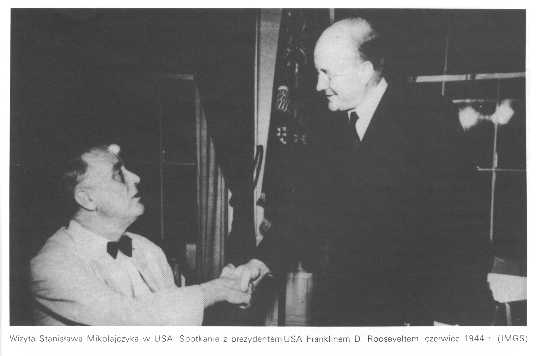
Mikolajczyk
with President Roosevelt, Washington, D.C. June 1944.
Mikolajczyk returned to London and continued talks with Lebedev, the
Soviet Ambassador to emigre governments.The Ambassador seemed willing to
discuss the demarcation line proposal before the Polish Premier left for the
U.S., -- but not after his return in late June. Perhaps Rooseveltís telegram to
Stalin had something to do with this. In any case, Lebedev now told Mikolajczyk
that the Polish Government had to recognize the frontier demanded by Stalin, or
the talks would come to nothing. Mikolajczyk said he could not do so, but
wanted to negotiate with Stalin, so he set out for Moscow on July 26 by way of
Egypt and Tehran. Churchill and Roosevelt informed Stalin of his forthcoming
visit and supported it.
While Mikolajczyk was on his way to
Moscow, news reached him in Egypt that the "Polish Commitee of
National Liberation" (Polish abbr. PKWN)
--which had been set up in Chelm, Poland, and had
issued a manifesto dated July 2 --, had just been recognized by the USSR.
He asked Churchill whether he should procced and when the British Prime
Minister said yes, he decided to do so. Many years later, it was revealed that
under Stalinís guidance, the two Polish communist delegations which had arrived
in Moscow from German-occupied Poland, joined with the Union of Polish Patriots
(ZPP) in Moscow to form The Polish Committee of National Liberation
(PKWN), after which they "negotiated" with Molotov on the Polish
frontiers. On 26 July, the PKWN signed a secret treaty with the USSR
recognizing the frontier demanded by Stalin, after which representatives of the
Committee arrived in Chelm on July 26 and then went on to Lublin, which
became their headquarters. The Committeeís Manifesto to the Polish people dated
July 22, allegedly printed in Chelm, was in fact printed in Moscow. The
Committee claimed to represent the majority of the Polish people, which was
absolutely false. *
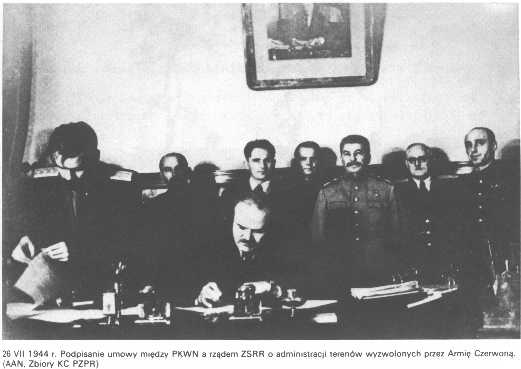
Moscow,26
July 1944. Soviet Commissar for Foreign Commissar Vyacheslav Molotov signing
the agreement on Red Army control over the administration of Liberated Polish
Territories. Edward Osobka-Morawski, later head of the Polish Provisional
Government, stands behind Molotov, with Stalin on his left, followed by Soviet
Deputy Commissar for Foreign Affairs Andrei Vyshinsky.
*[ On Churchill, Roosevelt, Mikolajczyk,
the setting up of the PKWN and the secret frontier treaty, see Anna M.
Cienciala, "The Diplomatic Background of the Warsaw Uprising of 1944: The
Players and the Stakes," Polish Review, vol. XXXIX, no. 4, 1994,
pp. 393-413].
(C)The Warsaw Uprising, August
1 - October 2, 1944.
The Background.
By the end of July 1944, the
vanguard of the 2nd Belorussian Army Group commanded by General Konstantin
K.Rokossovsky (1896-1968), was rapidly approaching Warsaw. On July 30, Mikolajczyk
arrived in Moscow and told Molotov the next day that an uprising against the
Germans was about to break out in Warsaw. When he saw Stalin on August 3, the
rising had broken out --Aug. 1-- and Stalin promised to do what he could to
help.
We should note that meanwhile, on
July 20, a German general, Klaus von Stauffenberg, had tried to assassinate
Hitler at his bunker in East Prussia by putting a briefcase holding a bomb
under the conference table. But someone kicked the briefcase away from Hitler.
The attempt failed; the conspirators were arrested, given mock trials, and
executed. However, the attempt created the impression that other German
generals might revolt against Hitler. Also, the German Central Army Group was
coming apart under the blows of the 2nd Belorussian Front and German soldiers
were streaming west through Warsaw.
In Warsaw, the commander of the A.K.
(Home Army), General Tadeusz "Bor" Komorowski (1895-1966), was
given a free hand by the Polish government on July 26 to start an uprising
against the Germans when he believed the right moment for it arrived. Such a
revolt had not been planned for Warsaw within the context of operation
" Storm" (Burza), which was to consist of regional uprisings as the
Germans withdrew, whereupon the designated civilian authorities were to come
out of the underground and take over the administration in the name of the
Polish Government in London. The storm was not to include cities so as to avoid
civilian loss of life.
As the Red Army advanced, news came
of mass Soviet arrests of A.K. combatants -- sometimes even after they helped
the Red Army to liberate a town -- as well as Polish civilian officials, but
the Home Army commander and his staff decided on an uprising in Warsaw. It
seems it had not other choice given the circumstances of the time.Communist
propaganda had been accusing the A.K. of passivity, and Soviet Polish-language
radio broadcasts called upon the people of Warsaw to help the Soviet Army
liberate the city by securing the bridges and factories. Thus, if the Home Army
did not order an uprising, it would be discredited; and if an unorganized
uprising broke out anyway, the communists could claim that the people supported
the Polish National Commitee of Liberation. The Home Army leaders decided to
fight the Germans and, at the same time, show world opinion that the Poles did
not want a Soviet-imposed communist government. Thus the uprising against the
Germans was also a demonstration against the Soviet-dominated PKWN.
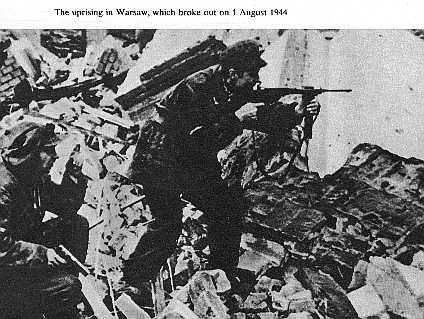
A.K.
soldiers fighting the Germans in Warsaw
from:
Topolski, Outline History of Poland (1986).
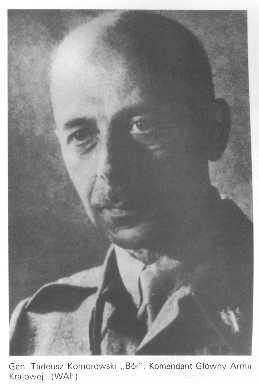
General
Tadeusz "Bor" Komorowski, commander of the Home Army (A.K)..
On July 31st, when
Komorowski knew Mikolajczyk was in Moscow asking for Soviet help, Soviet guns
were heard near Praga, the eastern part of Warsaw, and a report came in that
Soviet tanks were sighted. It seemed that the right moment for the uprising had
arrived, so the order went out for the Uprising to break out on Aug. 1 at 5
p.m. The Polish military leaders did not know that only vanguard units of
Rokossovskyís army were within sight of eastern Warsaw, while the bulk of it was
still miles behind. Nor did they know that a new, powerful, German army group
had arrived, led by General Model.
At this time Warsaw was seething.
Bedraggled German troops and civilians had been passing through the city for
some time, heading for the Fatherland, and now Soviet guns were heard. Not only
the Home Army but also many civilians were eager to attack the Germans in the
city. Of course, Komorowski and his staff knew of the Soviet arrests of Home
Army men and officials, but they assumed it was in the Soviet interest to take
Warsaw as soon as possible. It was, after all, the key communications hub
between Moscow and Berlin. They also assumed that the Home Army would rise
shortly before this occurred, expecting to fight only a few days. Then it would
welcome the Red Army into the Polish capital, showing that it was a force to be
reckoned with and ensure the underground leaders would participate in governing
postwar Poland. However, if the Russians then proceeded to arrest the leaders,
the latter would resist and this could not be hidden from world opinion --
which was the case with the arrests of A.K. soldiers in territories east of
Warsaw. Thus, the Western Powers would see that the Soviets wanted to dominate
Poland, and hopefully, they would take steps to prevent this, or at least send
help.The Home Army leadership also
expected the Polish Parachute Brigade to arrive by plane from Western Europe.
What no one expected on the Polish
side was for Rokossovskyís Army to stop at the gates of Warsaw, while other
Soviet armies would advance to the north and south of it - but this is what
happened. It is interesting that as long as Mikolajczyk was in Moscow,
the Soviet press did not report the uprising, only fires in Warsaw. Most likely
Stalin waited to see whether Mikolajczyk would recognize the new Polish-Soviet
frontier and join the Polish National Committee of Liberation. However, the
Polish Premier he could not do so, but said he would try to persuade his
Cabinet in London to accept the terms offered. Stalin also gave vague promises
to Mikolajczyk of Soviet help to the Warsaw insurgents.
As soon as Mikolajczyk left
Moscow on August 9, the Soviet press and radio condemned the uprising as
"a political racket," and blamed the Polish government in London. Also,
the Germans brought up five SS divisions under General Model, which briefly
stemmed the advance of Rokossovskyís army, but were defeated.
Rokossovsky's War Council then
telegraphed Stalin saying they could liberate Warsaw by August 22,provided they
got some units from the lst Ukrainian Front south of them. No answer to this
telegram has been found thus far, and on August 22 the lst Ukrainian Front was
ordered to advance into the Balkans.
Meanwhile, the Germans brought
several thousand more soldiers and police into Warsaw and drove back the
insurgents. Churchill and Roosevelt asked Stalin to allow the landing of allied
planes behind Soviet lines after dropping supplies to the Warsaw insurgents,
but Stalin refused. He relented when Russian and communist-led Polish troops
(lst Polish Army) occupied Praga (eastern Warsaw) on September 13, but due to
weather conditions it was only in mid-September that a flight of American
fortresses from England dropped supplies over Warsaw. However, they flew very
high, at 30,000 feet, to avoid German anti-aircraft fire, and most of the
supplies fell into German hands.
Meanwhile, Polish and South African pilots flew to Warsaw from Bari, Italy,
dropped supplies, and returned. They suffered heavy losses.
|
|
|
[A heavy shell fired from a German
gun, placed on a railway flat car, explodes on the only skyscraper in Warsaw; a
woman soldier, photos from: Dni Powstania (Days of the Uprising),Warsaw,
1957]
Unofficial Soviet messages to Mikolajczyk,
after his return to London --sent through Poles in touch with the Soviet
embassy in London -- offered help for Warsaw if he joined the Polish National
Committee of Liberation. Perhaps that is why Rokossovsky was ordered to occupy
eastern Warsaw (?) The Home Army leadership tried to establish contact with
him, but failed. A Polish battalion of the lst Polish Army landed on the west
bank of the Vistula in Warsaw, but was driven back by the Germans with heavy
losses. It seems that this was meant to
show that siginifcant Soviet help for the insurgents was impossible.
In late September, the Home Army
leadership decided that surrender was inevitable. It took place on October 2,
after 63 days of fighting. Warsaw was in ruins due to German bombing and
artillery shells. Hitler then ordered the city to be razed, and much of west
bank Warsaw was destroyed.
|
|
|
[Photographs from Dni Powstania, (Days
of the Uprising), Warsaw, 1957]
It is estimated that 200,000 lives
were lost, mostly civilians. !0,000 of them were A.K. fighters, and the Germans
also lost about 10,000 soldiers. The Polish survivors were evacuated, and the
soldiers taken to German POW camps. The Home Army was disbanded shortly
afterwards and only the National Armed Forces (Narodowe Sily Zbrojne, NSZ,
National Democrats ) fought the Soviets while retreating west.*
*[For a good English language study,
see: J.K. Zawodny, Nothing but Honor. The Story of the Uprising in Warsaw,
Stanford, CA, 1978. The most detailed study to date is by Norman Davies, Rising
'44, London, New York, 2004, reviewed by Anna M. Cienciala, Journal
of Cold War Studies, July 2007, and see other rewiews. For a shorter
but comprehensive study, see Wlodzimierz Borodziej, TheWarsaw Uprising of
1944, trans. Barbara Harshav, Madison,WI, 2006, reviewed by Piotr Wrobel, Slavic
Review, 2007, p. 519].
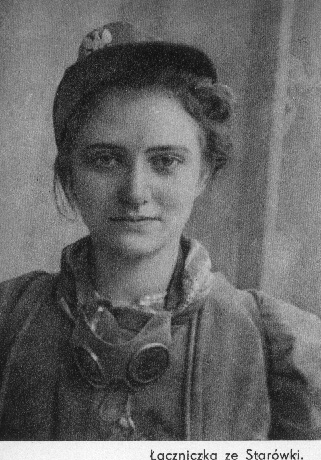
A
young woman, a Home Army liaison officer, who escaped from the part of Warsaw
known as the Old Town [Dni Powstania].
Different Views of the Warsaw
Uprising.
Poles held widely different views at
the time on whether the Uprising was justified or not. Gen. Anders, commander
of the Polish 2nd Corps in Italy, thought the Home Army command had made a
"criminal" decision in view of Soviet actions against HA units east
of Warsaw, so no Soviet aid could be expected and the city was doomed along
with its inhabitants. For a different reason, the Soviet press, as well as
Stalin, called it a "racket" or a criminal act. A Polish historian,
Jan Ciechanowski, who had fought in the uprising and later settled in Britain,
condemned the decision in vehement terms in his book on the subject. (See
bibliography).
Other Poles, who had also fought in
the Uprising, e.g. Zofia Korbonska -- wife of Stefan Korbonski, the last
delegate of the Polish government in Warsaw -- expressed the view that it was
inevitable in view of the situation in Warsaw in summer 1944 as well as of the
Polish tradition of fighting for freedom. In fact, the argument that, absent
the uprising, the city would have been saved along with its population, can be
countered by citing Hitler's order to the German Army to defend it as a
"fortress." He had ordered such a defense of Minsk, Belorussia (now
Belarus) and of Breslau (now Wroclaw) in Silesia; both were destroyed with
great civilian losses. We do
not, however, know whether Stalin would have ordered Rokossovsky to take the
city if there had been no Warsaw Uprising, or whether Mikolajczyk's access to
the Polish Committee of National Liberation in August 1944 would have produced
Soviet aid to insurgents once it broke out. In fact, documentation on Stalin's
thinking on this, as on most other key events in which he played the decisive
role, is still unavailable to historians, although it can be reconstructed on
the basis of some Russian memoirs and other materials. One thing is
clear: he would not tolerate a really inedpendent Poland.
Under communism, the Uprising was
condemned as a political crime --but with time, the bravery of the fighters was
praised. Most Poles honor the memory of those who fought a hopeless battle and
a museum of the Uprising was opened in Warsaw in 2009. Former President Lech
Kaczynski -- who died along with 96 others in a plane crash at Smolensk, April
9, 2010 -- had pushed the project forward when he was mayor of Warsaw.
(D) From the Warsaw Rising to Yalta
and Potsdam, October 1944-August 1945.
(A) Toward the Yalta Conference.
As mentioned earlier, in October
1944, Churchill made another attempt to bring about an agreement between
Mikolajczyk and Stalin. Both traveled to Moscow. However, Mikolajczyk
could not agree to the Soviet terms on the frontier and to his Polish Peasant
Party getting only a few seats in the new Polish government. He again said he
would try to convince his Cabinet to accept Soviet terms.
At this time, Churchill also
tried to save what he could of British influence in the Balkans. He
concluded the "Percentage Agreement" with Stalin, whereby Britain
would recognize that the USSR had 90% influence in Romania and Bulgaria, while
the Soviets would recognize 90% British influence in Greece. They would share
influence 50-50 in Hungary and Yugoslavia. Roosevelt approved the deal for the
time being.*
*[ See: Albert Resis, "The
Churchill-Stalin Percentage Agreement," American Historical Review,
vol. 83, no. 2, April 1978, pp. 368-387]
Mikolajczyk failed to secure Western guarantees of territorial
compensation for Polihs losses in the Eastand could not convince the Polish
Cabinet to accept a compromise on the eastern frontier. The most they would do
was agree to negotiations on the frontier after the war, so he resigned in
November 1944, and a new Prime Minister, the Socialist leader Tomasz
Arciszewski (1877-1955) took over. Mikolajczyk sent memoranda to Churchill
with suggestions on what should be done, and the British Prime Minister still
hoped that Mikolajczyk would join a new Polish government coalition.
However, on December 3, 1944,
Stalin recognized the Polish Committee of National Liberation as the
Provisional Government of Poland. He did so despite appeals from
Churchill and Roosevelt that he delay this until they met at Yalta. Roosevelt
had been re-elected President in November 1944. He had secured Polish-American
votes by pledging his support for an independent Poland -- which they
understood to include the prewar Polish-Soviet frontier.
(B)The Yalta Conference and
its Aftermath.
By the time the three allied leaders
met at Yalta, (Crimea), on February 4, 1945, Soviet armies were within striking
distance of Berlin. Other armies were still besieging Breslau (P.Wroclaw) and
mopping up pockets of German resistance.
Yalta was suggested by Stalin - who
was afraid of flying. FDR, sick and exhausted, made the trip on a U.S. warship
to Malta, then flew to Crimea. Like Churchill he also had to make a long and
bumpy trip in an open jeep from the Soviet airport, over mountaineous territory
and in cold weather, to Yalta. The other members of the two western delegations made the
trip in buses.
At Yalta, Churchill and Roosevelt
tried to find a solution to the Polish Question that would be acceptable to
Stalin as well as to the British public and Polish-Americans. Churchill also
wanted to preserve some British influence in Poland, but Roosevelt was most
concerned with securing Soviet help against Japan after Germanyís defeat in
Europe, and with Soviet membership in the new United Nations.
The Polish-Soviet frontier did not
present a problem because it had been agreed in principle at Tehran. It was to
follow the Curzon Line (1920, see Lec.Notes 11B), with small concessions to
Poland. Roosevelt made a weak attempt to preserve Lwow for Poland, but Stalin
brushed it aside. There was, however, much dispute over Polandís western
frontier. Stalin wanted it drawn along the Oder and Western Neisse river
- which would give all of Upper Silesia to Poland - while
Churchill and Roosevelt supported the Eastern Neisse, which would leave
most of this valuble industrial region in Germany. Finally, they
agreed on a statement that Polandís eastern frontier was to follow the Curzon
Line, while the northern and western frontiers were to be defined later.
There was much discussion at Yalta
about Polandís future government.
It was finally agreed that the existing "Polish Provisional Government of
National Unity" - the name assumed by the Polish provisional government
recognized by Stalin on January 4, 1945 - would be enlarged by the addition of
"democratic" leaders from Poland and abroad. Candidates for this
enlargement were to be screened by a Committee of Three: the Soviet Commissar
for Foreign Affairs, Vyacheslav M. Molotov, the U.S. Ambassador
in Moscow, W. Averell Harriman, and the British Ambassador Sir
Archibald Clark-Kerr. Once formed, the new government was to pledge to hold
free and unfettered elections, but without any international supervision for it
was rejected by Stalin. Instead, the ambassadors of the USSR, Britain and U.S.
in Poland were to be "observers." Free elections were also to take
place in all liberated countries, as stated in the "Declaration on
Liberated Europe," signed by all three heads of state.
In fact, the Declaration confirmed
the principles of the Atlantic Charter and of the United Nations Charter based
on the former. It spoke of the right of all peoples to choose their form of
government, and the restoration of sovereign rights and self-government to
peoples deprived of them. The three heads of state also promised help in
forming interim authorities broadly representative of all democratic elements,
which would be pledged to establish governments by free elections. Molotov
thought the American draft of the Declaration unacceptable, but Stalin told him
to accept it because "We can deal with it our way. The point is the
correlation of forces." He also knew that Roosevelt really
did not care if Eastern Europe became communist. *
*[For the Molotov-Stalin exchange,
see: Molotov Remembers. Inside Kremlin Politics. Conversations with Felix
Chuev, edited with introduction by Albert Resis, Chicago, 1993, p. 51. For
Roosevelt not caring about E.Europe, see his remark to Harriman cited in:
William Larsh, "Yalta and the American Approach to Free Elections in
Poland," Polish Review, vol. XL, 1995, no. 3, p. 280, n.35. For a
summary of the Yalta discussions on Poland, see: Karski, The Great Powers
and Poland, ch. XXXVII, pp. 581-602, also Anna M.Cienciala, "Great
Britain and Poland before and after Yalta," Polish Review, vol. XL,
no. 3, 1995, pp. 281-314. For the U.S. Record, see: Foreign Relations of the
United States. The Conferences of Malta and Yalta, Washington, D.C., 1955;
For the Polish Question at Yalta, see Cienciala review article on Plokhy's
book: Yalta. The Price of Peace:"What
did Roosevelt and Churchill Really Aim to Achieve for Poland at Yalta? Was
Yalta the Price of Peace?" Polish Review, 2010 ,click
for text].
Stalin confirmed his agreement to
help the U.S. the war against Japan, while Churchill and Roosevelt agreed to
his demand for southern Sakhalin and the Kurile Islands. (Ultimately, Stalin
denounced the Soviet-Japanese neutrality agreement of April 1941 and attacked
the Japanese armies only after the U.S. had dropped the first atomic bomb on
Japan). The Big Three also agreed on dividing Germany into American, British
and Soviet zones.
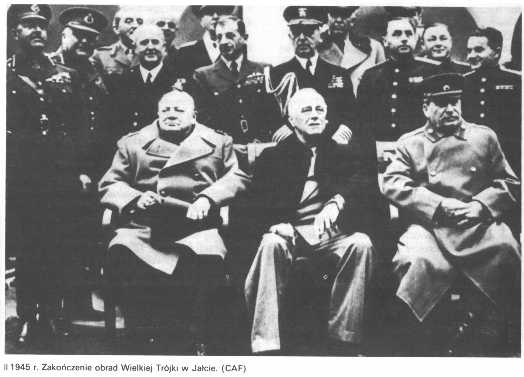
The
end of the Big Three Conference at Yalta, February 11 1945.
After Yalta, Stalin made sure that
few really democratic leaders were added to the existing, communist-dominated
Polish government by ordering the NKVD to lure the 16 most prominent
Polish underground leaders into a trap. They had accepted the Yalta
decisions on Poland, and agreed to talk with Soviet military officers about
coming out of the underground. In these talks, they were promised that a plane
would take them to London to confer with the Polish govrnment there before
going to Moscow. However, the Soviet military plane which they boarded in March
1945 took them to Moscow, where they were placed in the NKVD Lubianka prison.
They were deprived of sleep and food
over several weeks to make them confess to crimes against the Red Army, but
most of them only agreed to say they had used radio transmitters without Soviet
permission, which was a crime in the Soviet Penal Code. When Mikolajczyk
agreed to negotiate his access to the Provisonal Polish Government of National
Unity and came to Moscow in June 1945, the negotiations took place at the same
time as the rigged trial of the 16 underground leaders.
This was, of course, Stalinís way of pressuring Mikolajczyk to join the new
government. The sixteen were sentenced to various terms of imprisonment;
fourteen survived and two died in prison. After Mikolajczyk joined the new
Polish Government, the Allies recognized it on July 5, 1945. Mikolajczyk's
membership was touted as proof of its democratic nature, even though the vast
majority was communist or supported the new Polish state.
In the meanwhile, the Red Army took
Berlin in early May, wreaking a terrible revenge on the German civilian population
as they advanced, killing the men and raping the women (see Anthony Beevor,
Berlin 1945.) Hitler and his wife Eva Braun (married just before they died)
committed suicide in his bunker -as did Joseph Goebbels and his wife, after
poisoning all their children so they would not fall into Soviet hands. Hitler
ordered his body and Eva's to be burned, which was done. (The Soviets found
them, but said nothing, letting rumors fly for years that Hitler had survived.
His skull was found in the Russian archives after the collapse of the USSR in
late December 1991.)
On May 8, 1945, German
generals in the West signed surrender documents in the presence of the allied
commander-in-chief General Dwight D. Eisenhower (1890-1969). The
German surrender in N.W. Germany was made to British General Bernard
Montgomery. The Russians had their own surrender ceremony in Berlin on May 9
and, with the exception of the first victory parade held in June, celebrate
victory over Germany every year on this day.
( C ) The Potsdam Conference,
July 16- August 2, 1945.
President Roosevelt died in April
1945, and was succeeded as President by Harry S. Truman (1884-1972). He
met with Stalin and Churchill in Potsdam, a Berlin suburb relatively
undamaged by the war. Churchill was replaced by the Labour Party leader, Clement
R. Attlee (1883-1967) after Labour won the elections on July 26. Most
Britons, with the Great Depression fresh in their memory, wanted full
employment and a welfare state, all promised by the Labour Party, which is why
they voted it into power.
Polandís western frontier was
negotiated at Potsdam with the Polish delegation, which included Mikolajczyk as
a deputy Premier. It was agreed that Poland would get East Prussia, except for
Konigsberg (Kaliningrad) which went to the USSR. Poland would also get the
Baltic coast up to Stettin (P. Szczecin), all of Upper Silesia, and all the
land north of it, thus establishing the new Polish western frontier on the Oder
and Western Neisse rivers. (Stalin had proposed a Polish-German frontier on the
Oder River to British Foreign Secretary, Anthony Eden,during their talks in
Moscow, Dec. 1941).
The western leaders extracted a
pledge of free elections from the Polish delegation in exchange for recognizing
the new western frontier, but the pledge was not kept.
The three Allied leaders agreed that
the German population in the territories granted to Poland was to be deported
to German territory. (2-3 millions had already fled
ahead of the Red Army). At the same time, some two million Poles from former
eastern Poland, now part of USSR, were transported into the new western
territories, where they were joined by Poles from central and southern Poland
looking for free farm land. Germans from all over Eastern Europe were
deported to German territories, most to the western zones of occupation.
This deportation involved about 11,000,000 Germans*, who were treated as
collectively responsible for the brutal Nazi occupation policies, particularly
in Poland. They had been used by Hitler to support German expansion and were
resented for taking the property of Poles, Czechs, and others. Also, the great
powers, as well as the Poles, wanted to prevent the existence of large German
minorities outside of Germany, as had been the case in 1918-39. Thus, there was
a massive "ethnic cleansing" which caused much suffering, but was the
natural result of Hitler's policies in World War II as well as Soviet power. Furthermore, the Germans were not
the only people to suffer in this way.
(On the population movements in
postwar Eastern Europe, see the Introduction to Lec. Notes 17).
*[See
map at beginning of Lec. Notes no. 17]
The Western powers did make an
important reservation regarding the new Polish western frontier. The new Polish territories were to be under
"provisional Polish administration" until a final peace conference
took place with the participation of a united Germany. * This was to be used by
future western German leaders as justification for not recognizing Polandís
western frontier. (It was, however, recognized in a West German-Polish Treaty
in November 1970, also in the Helsinki Agreements of summer 1975, with final
recognition at the time of German unification in October 1990.) The Potsdam
Conference also led to the confirmation of the Soviet occupation zone in East
Germany, agreement on the four power occupation of Austria and of the two
capitals, Berlin and Vienna. *
*[For the Potsdam Conference, see:
Herbert Feis, Between War and Peace. The Potsdam Conference, Princeton,
N.J., 1960, and Charles L. Mee, Jr., Meeting at Potsdam, New York, 1975.
For the U.S. record, see: Foreign Relations of the United States. The
Conference of Berlin, 1945, Washington, D.C., 1960].
For an overview of Polish foreign
policy in WW II, see Wandycz, Polish Diplomacy, pp. 30-49 (click
here for text)
For the best English-language †book on Poland in WWII, see Halik Kochanski, The
Eagle Unbowed. Poland and the Poles in the Second World War, Penguin Books,
U.K., 2012; Harvard University Press, Cambridge, Mass., 2012.
For Polish documents in English on
the last year before WWII and in September 1939, see: Polish Documents on
Foreign Policy 24 October 1938 - 30 September 1939, edited by Wlodzimierz
Borodziej and Slawomir Debski, Warsaw, 2009. (Reviewed by Cienciala in Diplomacy
and Statecraft, 2010.)
See also books listed in the
Bibliography for WWII.
************************
Appendices to Lecture 16
B. Eastern Europe in World War II.
AUSCHWITZ/Oswiecim-
Birkenau/Brzezinka.
Auschwitz/Oswiecim was a labor camp
for non-Jews. It began as a forced labor camp for Poles, many of whom died
there.
Birkenau/Brzezinka, next to the labor camp, was the largest German death camp
in Poland for Jews.
The whole complex was on ethnically Polish territory which was annexed to
Germany in September 1939. One of the barracks was loaned to the
Holocaust Museum, Washington, D.C., in 1984, and a dispute erupted in early
2012 on whether it should be returned to the original site in Poland.
The New York Times article of
Jan. 28, 2001, the anniversar of Liberation in 1945, gave up-to-date
information about Auschwitz.
(It should be noted that exact figures of the victims who died there became
known when the Russian government made available the German records taken
by Soviet authorities after the Red Army liberated the camp in late
January 1945).

Polish help for Jews under the
German Occupation. (from: The Jews in Poland,
Chimen Abramsky et al., eds., Oxford, 1984).
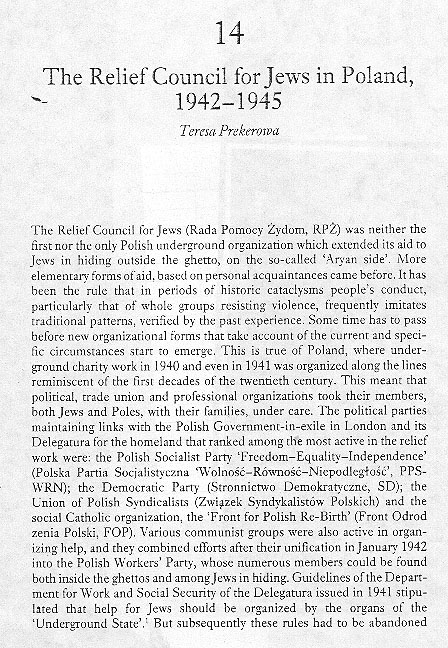


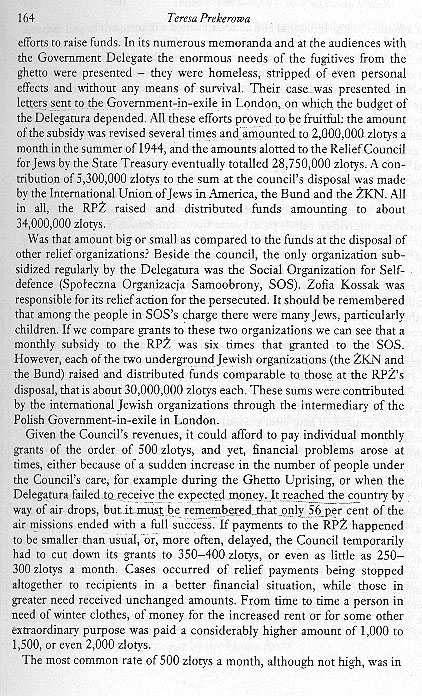
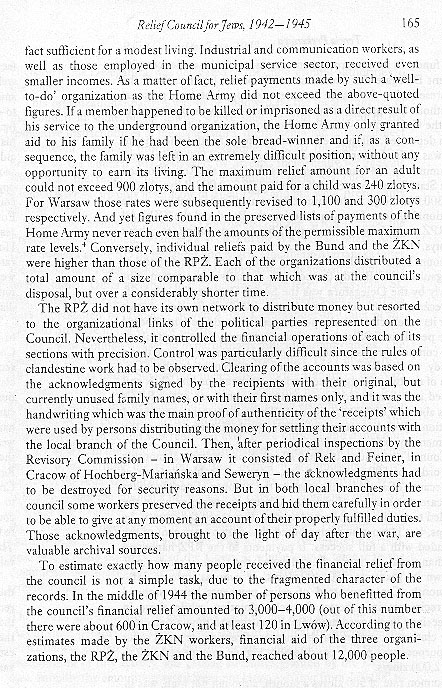
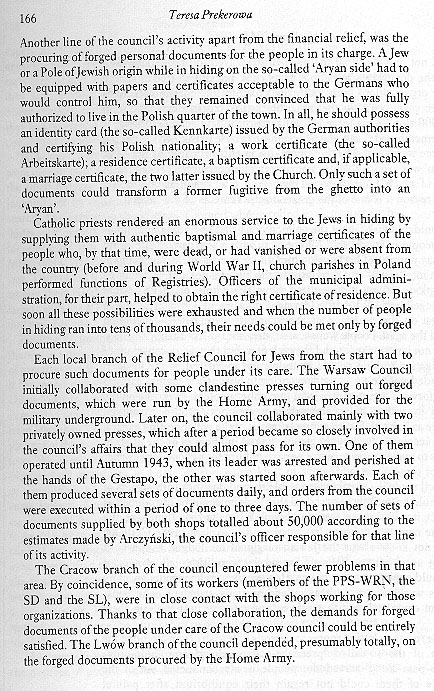

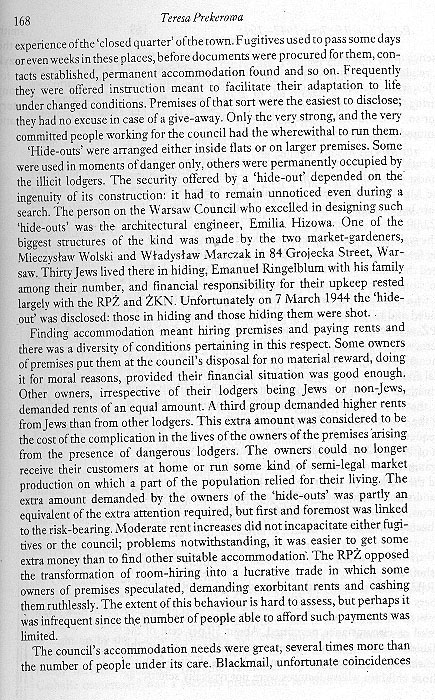
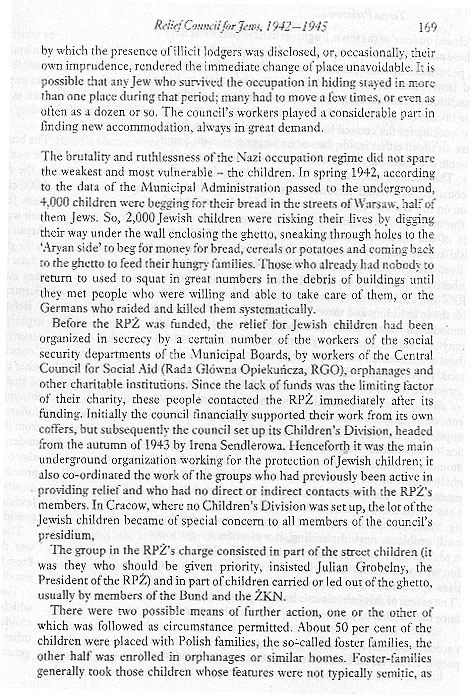
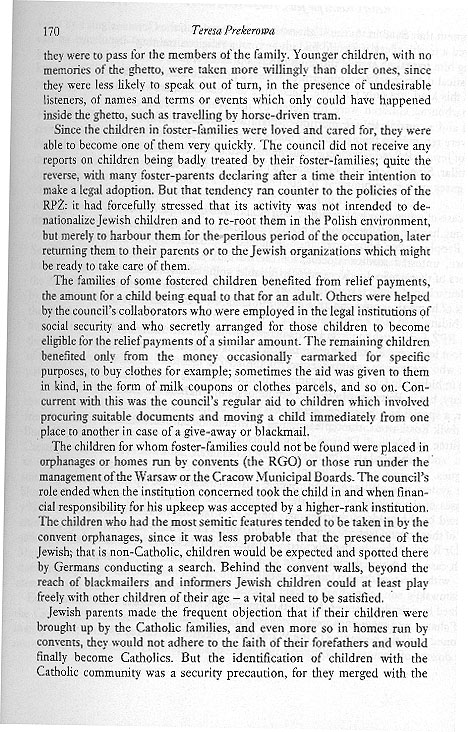
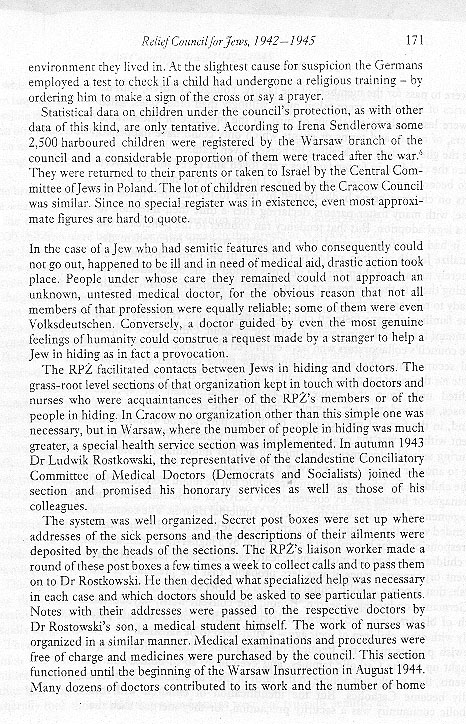
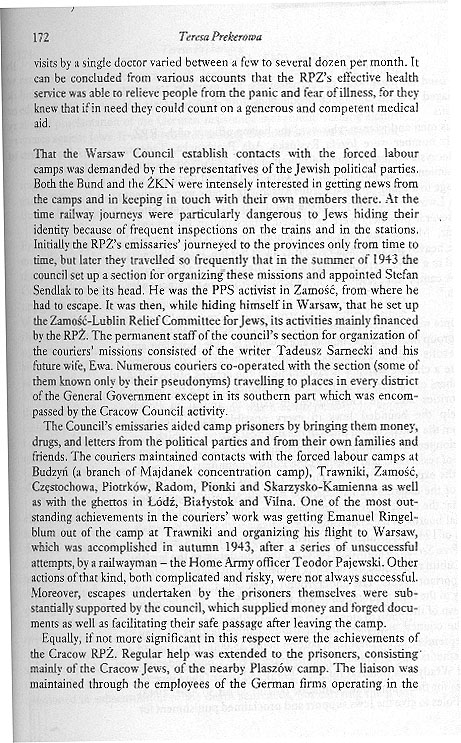

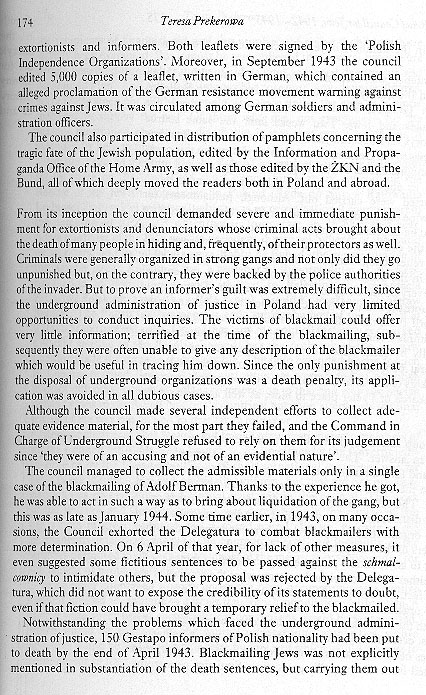
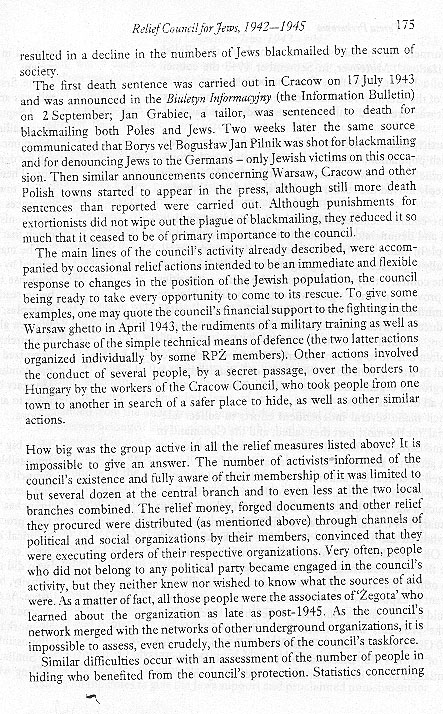
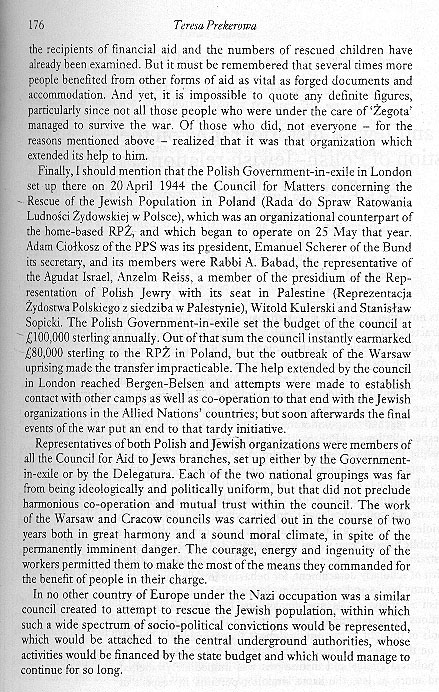
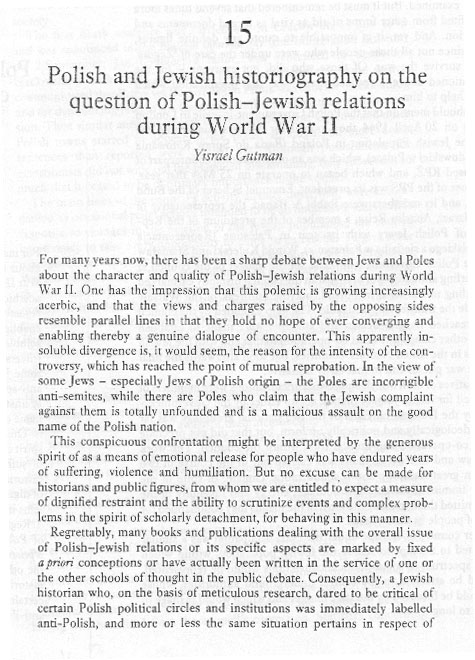
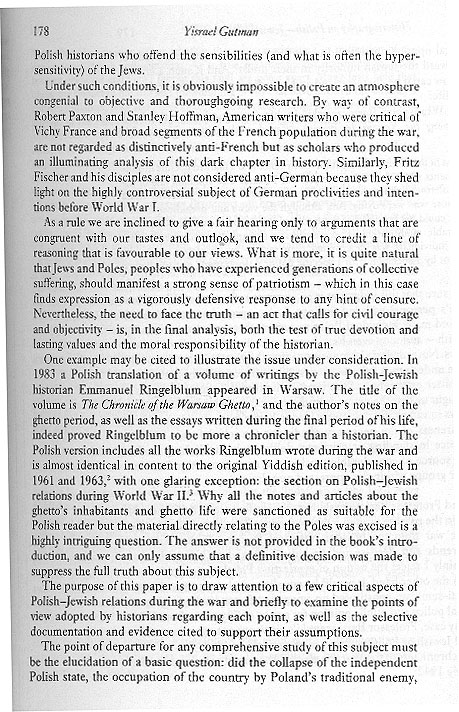
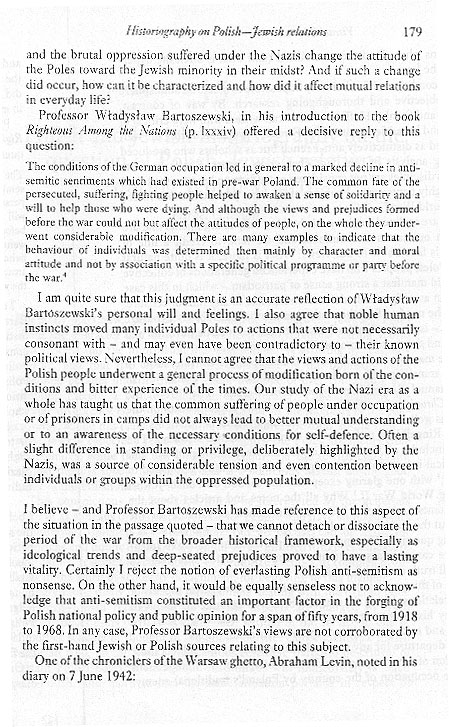
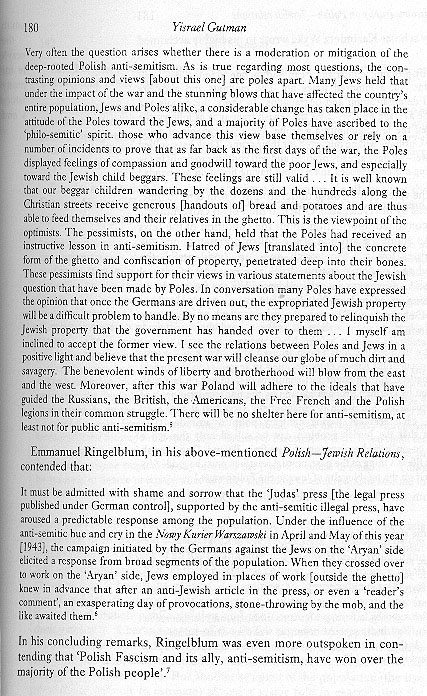
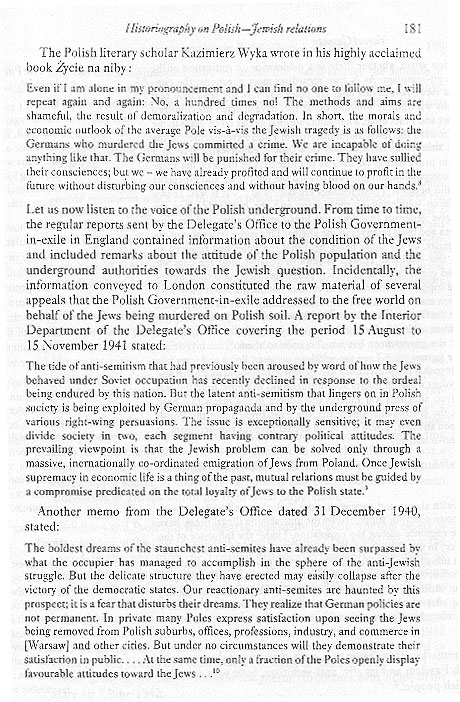
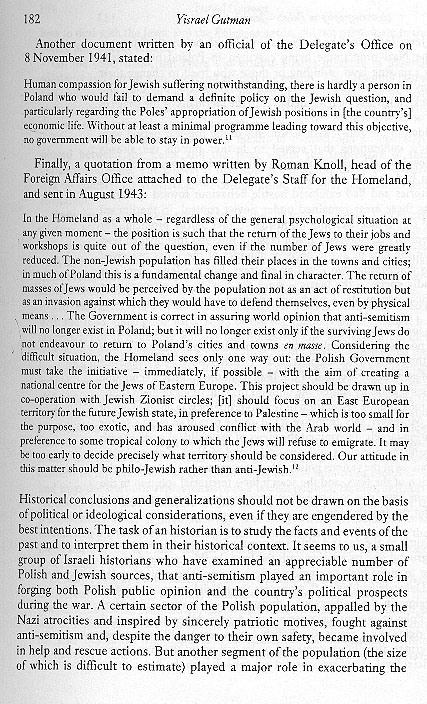
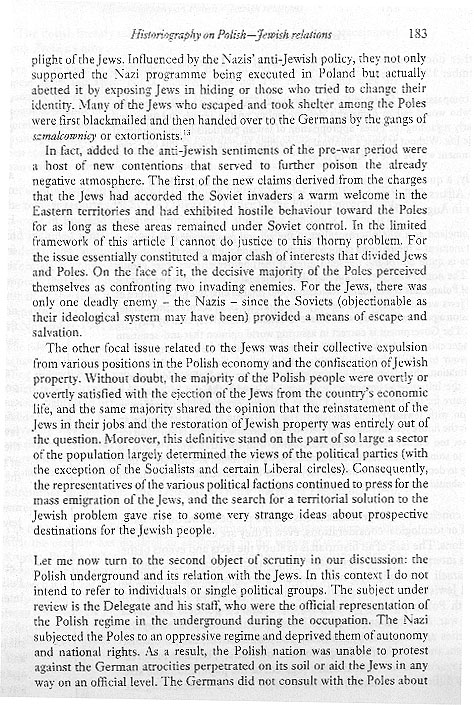

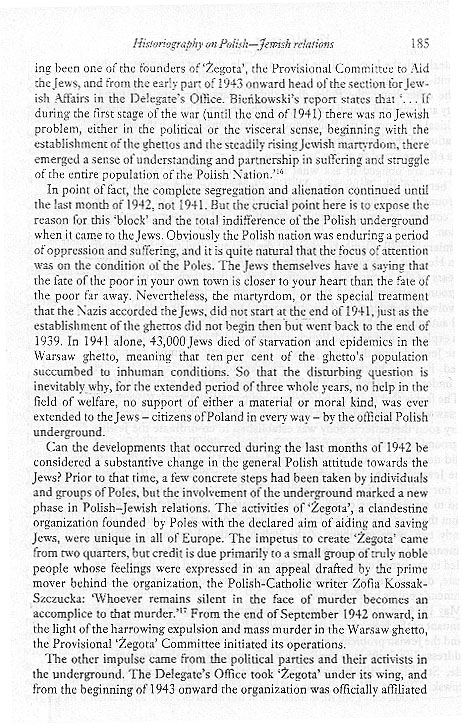
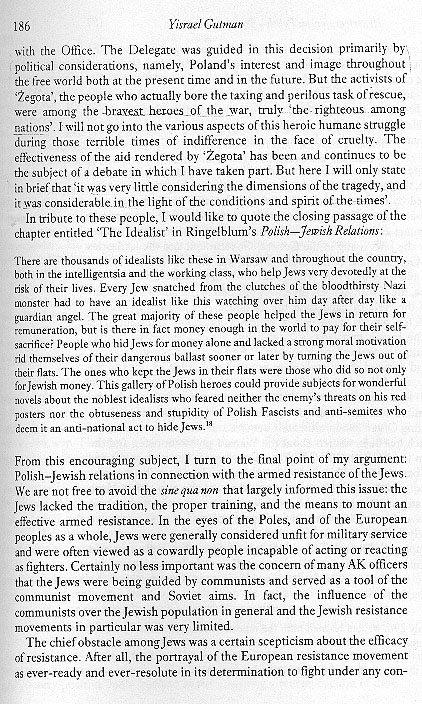


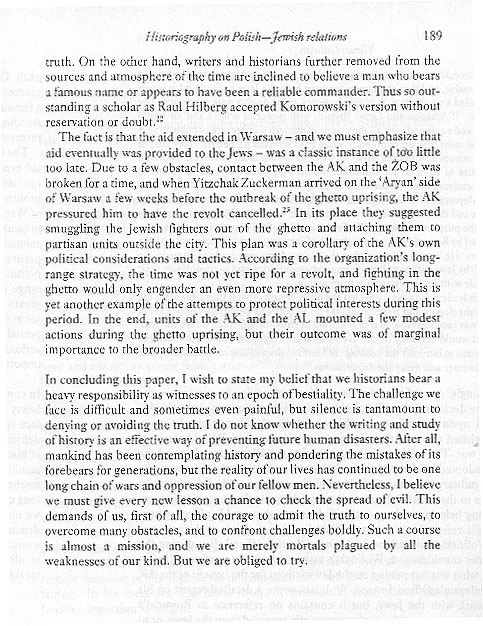
The Massacre of Polish Jews by Poles
in Jedwabne, July 10, 1941.
This massacre in a little town
about 90 kilometers north-east of Warsaw, came to light when Jan T. Gross, a
Polish-born American sociologist and historian, found documents showing that,
after the Soviets withdrew under German attack on the USSR, the Poles in this
small town murdered almost all of its 1,600 Jews. The testimony of the
survivors - who owed their lives to a Polish family which hid them for the
duration of the war - as well as testimony given at a trial in 1949, was found
by Gross, who published a book on the massacre in Poland, Sasiedzi (Neighbors)
in 2000. An English version published by Princeton University Press came out in
April 2001.
The article by Andrew Nagorski,
Newsweek, March 5, 2001, summarizes the key points of the Gross book. For
a longer summary by Jan T. Gross, see: ďNEIGHBORS,Ē The New Yorker,
March 12, 2001, PP. 64-77.

Letter by Adam Michnik, New York
Times, March 17, 2001.
Polish reactions to the Jedwabne
revelations were mixed. Some, including President Alexander Kwasniewski and
Premier Jerzy Buzek have expressed deep regret and apologized in the name
of the Polish nation. Others said it was too early for apologies because
an investigation was in process; it was not known what triggered the massacre,
nor exactly how the Germans were involved. Yet others refused to believe that
Poles murdered Jews, and saw the Gross book as part of a Jewish plot to
discredit Poland. The most thoughtful reaction in early 2001 came from Adam
Michnik, a dissident in the years 1968-89, and since 1989 editor of
one of Polandís most popular newspapers, the liberal Gazeta Wyborcza.
(The Electoral Newspaper, pron. Gaazetah Vyborchah).
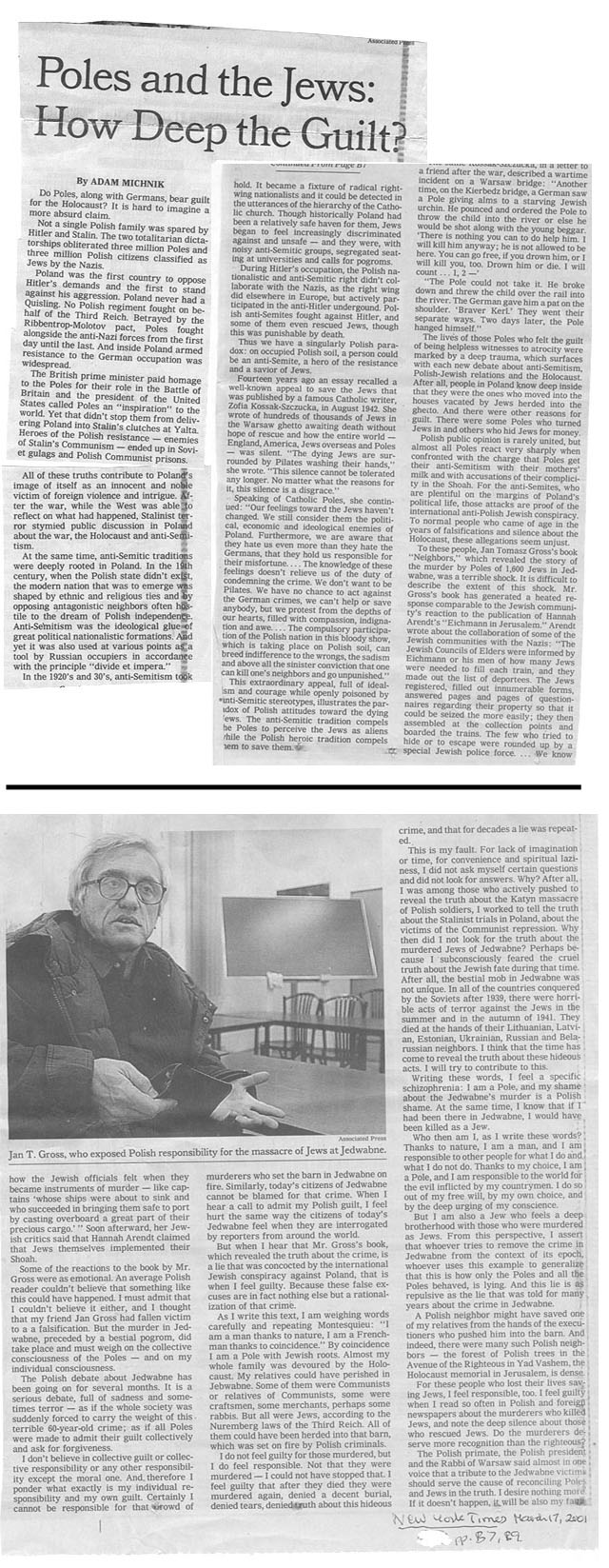
Anna M. Cienciala wrote a review
essay on the two volumes about Jedwabne published by the Polish Institute of
National Memory, Warsaw, November 2002. (At the end of the article, see the
correction of errors in the original article.)
 |
 |
 |
 |
 |
 |
 |
 |
 |
 |
 |
 |
 |
 |
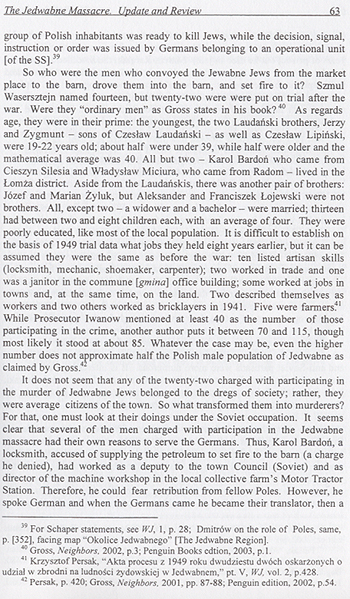 |
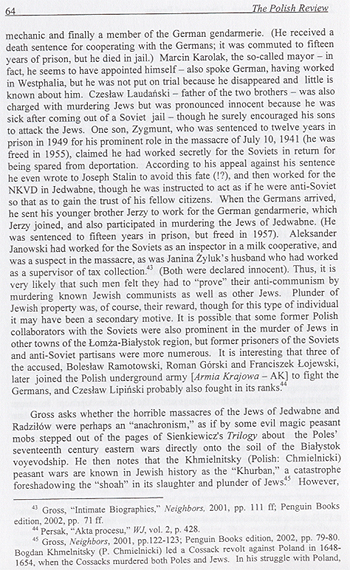 |
 |
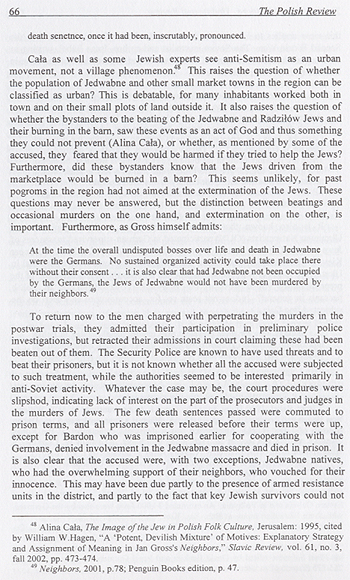 |
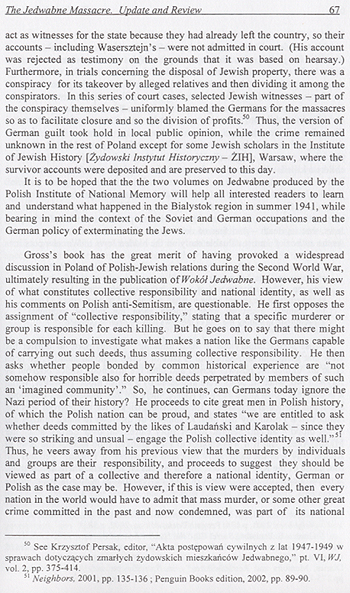 |
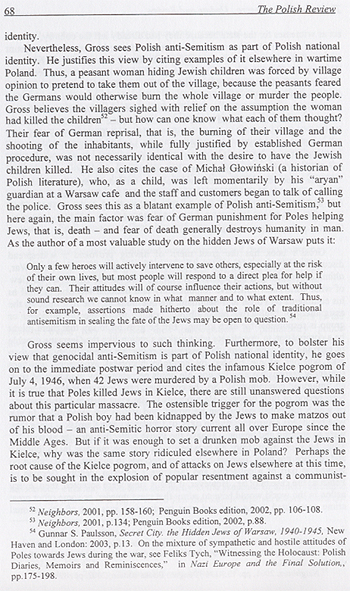 |
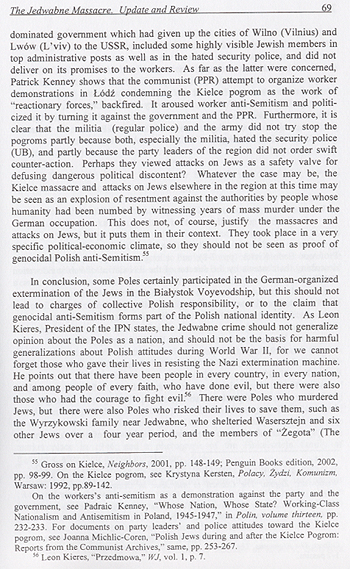 |
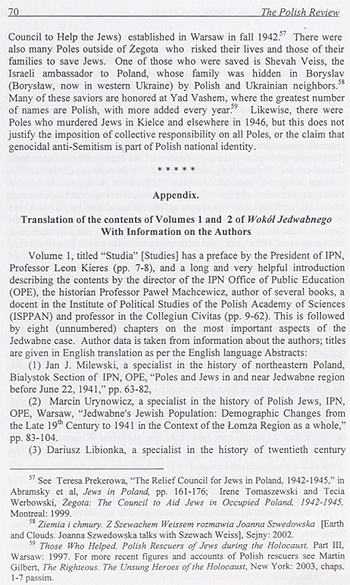 |
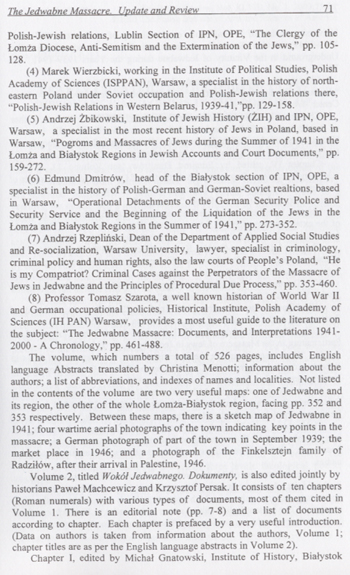 |
 |
Errata to A.M. Cienciala's article, "The Jedwabne Massacre:
Update and Review." (The Polish Review, v.48, 1, 2003, 49-72).
p.50, line 13: Charlotte should be
Charlottesville
p. 50, par. 1, line 5, Iwanow should
be Ignatiew
p. 51, note 7, line 1, same
correction as above.
p. 54, note 15, line 2, Crakow
should be Cracow
p. 60, par 1, line 3 from bottom:
1945 should be 1944.
p. 64, line 3: Marcin Karolak should be Marian Karolak
p. 64, line 4-5: omit the phrase:
"also spoke German, having worked in
Westphalia" (incorrect information
about Westphalia).
p. 71, par following chapter
descriptions: Christina Menotti should be: Christina
Manetti
p. 72, par following chapter
descriptions: same correction.
FELIKS
TYCH ON POLISH ANTI-SEMITISM,
*********************************
